My Review and Build of Merit Kit #65302, 1/350
Aircraft Carrier, USS Enterprise, CV-6 REVIEW & BUILD, Doolittle Raid Vessel
Note: You can see all the pictures in highest resolution at My USS Enterprise, CV-6, Flickr Album, or you can click on any of the pictures here and get a higher resoultion image.
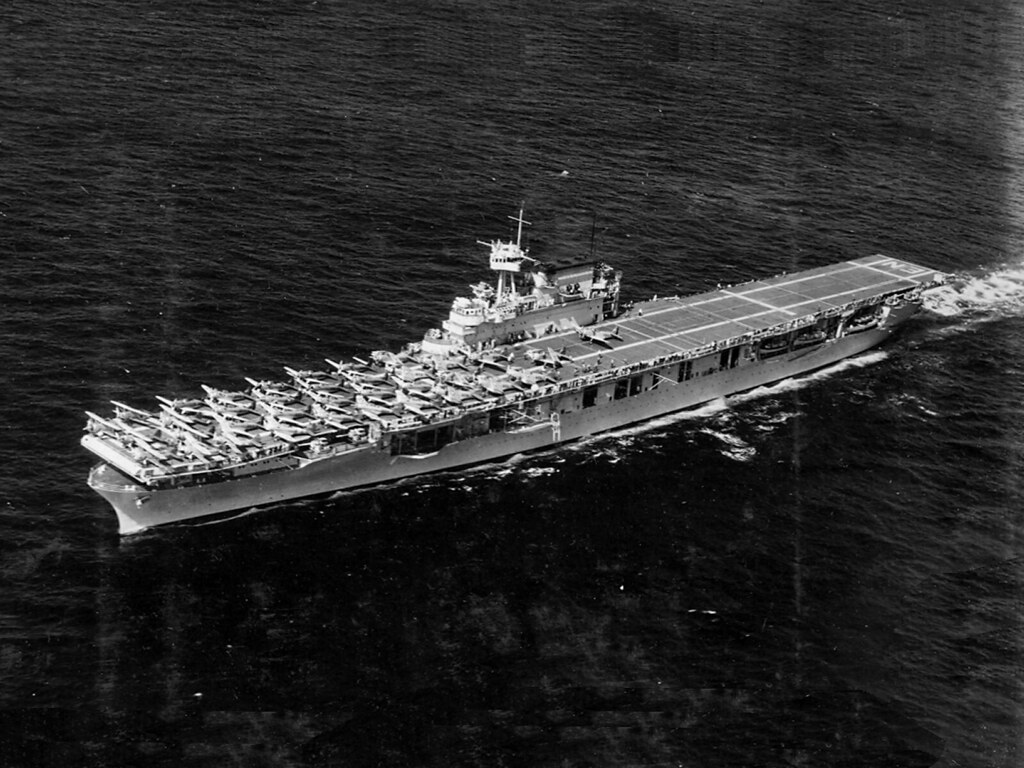
USS Enterprise, CV-6, Aircraft Carrier
The USS Enterprise aircraft carrier, CV-6, was the sixth official aircraft carrier that the United states Navy had acquired, and she was specifically built from the keel up as an aircraft carrier.
Earlier carriers leading up to the the Enterprsie were:
- CV-1 USS Langley, Covnerted from a Collier an commissioned an aicraft carrier in 1920
- CV-2, USS Lexington, Launched in 1925 and commissioned in 1927, at 43,000 tons, built from from a battle cruiser hull into a carrier. Sunk in 1942 at Coral Sea.
- CV-3, USS Saratoga, 2nd Lexingotn class, launched in 1926 and commissioned in 1927, at 43,000 tons, built from from a battle cruiser hull into a carrier. Survived World War II.
- CV-4, USS Ranger, the first US Navy carrier designed abnd built from the keel up as a carrier, was launched in 1933 and commissioned in 1934, a little smaller at 25,5000 tons, but newer than the Lexington class, survived World Wr II.
- CV-5, USS Yorktown, Enterprise's sister ship, launched in 1936 and commissioned in 1937. 26,000 tons, sunk by Janese submarine following the Battle of Midway in 1942.
USS Enterprise was launched in 1936 and commissioned in 1938, and she also suvived the war. The last in the Yorktown classs wass USS Hornet, CV-8, which was launched in 1940 and commissioned in 1941 before the war started. She was lost in World War II as the Battle of the Santa Cruz Islands in 1942.
In between the Enterprise and the Hornet, a single carrier was also built separtely, the USS Wasp, CV-7. She was launched in 1939 and commissioned in 1941 abd was a smaller, displacing about 20,000 tons. she was also sunk in World War II, as she escroted reinforcements to Guadalcanala in Spetember 1942 by a Japanese submarine.
So, after Pearl Harbor, in Deember 1941, when the war started, the US NAvy havd eight aircraft carriers. Within a year of the start of th war, five of them had been sunk.
USS Enterprise was one of the three that was not, and she fought on valiantly throughout the war.
I am building her for two reasons.
First and foremost, as her history will show, she participated in more major battle action in World War II than any other United States ship. These actions included the Doolittle Raid on Tokyo, Battle of Midway, the Battle of the Eastern Solomons, the Battle of the Santa Cruz Islands, several engagements during the Guadalcanal Campaign, the Battle of the Philippine Sea, and the Battle of Leyte Gulf. During the war, Enterprise earned 20 battle stars, the most for any U.S. warship in World War II...or for that matter, in the entire history of the US Navy. She was the most decorated U.S. ship of all time.
During World War II, on three occasions during the Pacific War, the Japanese announced that she had been sunk in battle, only to have her return and fight them again.
The second reason is because of he participation in the Dooliitle raid in April of 1942, only six months after Pearl Harbor, when the Unites States launched a bold and audacious attack on Japan's capital city of Tokyo with B-25 Mitchell bombers flying off of USS Hornet, CV-8, which was being covered with fighters from USS Enterprise on the voyage to and from that Raid.
Early Years:
As stated, the USS Enterprise was commissioned in 1938, three years before the US entered World War II.
Enterprise sailed to Rio de Janeiro on her shakedown crusie after commissioning. After her return, she operated along the east coast and in the Caribbean until April 1939, and was one of fourteen ships to receive the early RCA CXAM-1 Radar. She was then ordered to duty in the Pacific.
Based first at San Diego (where she was used in the filming of Dive Bomber, starring Errol Flynn and Fred MacMurray) and then at Pearl Harbor after President Roosevelt ordered the Fleet to be "forward based," the carrier and her aircraft squadrons trained intensively and transported aircraft to various island bases of the Pacific. Enterprise left Pearl Harbor on 28 November 1941 one such mission, delivering Marine Fighter Squadron 211 (VMF-211) to Wake Island. She was returning from that mission on 7 December 1941, when the Japanese attacked Pearl Harbor
After Pearl Harbor:
As stated, on the morning of 7 December 1941, Enterprise was at sea and received a radio message from Pearl Harbor, reporting that the base was under attack. That evening, Enterprise, screened by six of her Grumman F4F Wildcat fighters, put into Pearl Harbor for fuel and supplies.
In fact, as they entered the area, her aircraft were fired on by anti-aircraft defenses, and one pilot radioed in, reporting that his aircraft was an American aircraft.
She sailed early the next morning to patrol against possible additional attacks in the Hawaiian Islands. Although the group encountered no surface ships, Enterprise aircraft did sink Japanese submarine I-70 at 23°45'N 155°35'W on 10 December 1941, getting one of the first at sea sinkings in of the war.
During the last two weeks of December 1941, Enterprise and her group steamed west of Hawaii to cover the islands while two other carrier groups made a belated attempt to relieve Wake Island. After a brief layover at Pearl Harbor, the Enterprise group sailed on 11 January 1942, protecting convoys reinforcing Samoa.
USS Enterprise wasted no time in trying to take the fight to the enemy.
On 16 January 1942, one of her TBD Devastators of Torpedo Squadron 6 (VT-6), piloted by Chief Harold F. Dixon, got lost on patrol, ran out of fuel, and ditched. Dixon and his two crewmates, bombardier Anthony J. Pastula and gunner Gene Aldrich, survived for 34 days in a small rubber raft that had no stored food or water, before drifting ashore on Pukapuka atoll. Dixon was awarded the Navy Cross for "extraordinary heroism, exceptional determination, resourcefulness, skilled seamanship, excellent judgment and highest quality of leadership." in leading the two men to safety.
On 1 February, 1942, Enterprise's Task Force 8 raided Kwajalein, Wotje, and Maloelap in the Marshall Islands, sinking three ships, damaging eight, and destroying numerous airplanes and ground facilities. Enterprise received only minor damage as the Japanese attempted to counterattack while her group retired to Pearl Harbor. It was the first of many times the Japnese attempted to catch and sink the USS Enterprise.
The next month, the Enterprise group swept the central Pacific, attacking enemy installations on Wake and Marcus Islands.
Doolitle Raid:
After minor alterations and repairs at Pearl Harbor, Enterprise departed on 8 April 1942 to rendezvous with her sister ship, the USS Hornet.
The mission was top secret and the two carriers and their escorts (each had four destroyers and two heavy cruisers along with them), met in the Pacific. Hornet had sailed from the west coast.

The men were elated to hear that this mission was to take the fight to the enemy hme islands and her capital. The two carrier group sailed west, Enterprise escorting Hornet on the mission to launch 16 Army B-25 Mitchells in the "Doolittle Raid" on Tokyo.
Japanese picket shis were well out from the Japanese Islands and one of these say the group and radioed their sighting before being sunk by the surface ships.
Immediately enterprise launched aircraft to protect Hornet who began launching her bombers two hunred miles early. But they did launch, which meant eacn and every one of the bombers would not have the fuel to reach their planned landing field in China and they would have to either dith over the sea, or crash land in China in Japanese controlled areas. They chose to make the attack and they did so,
While fighters from Enterprise flew combat air patrol, the B-25s launched on 18 April, and flew undetected to the target. The task force, its presence known to the enemy after the sighting then reversed course and returned to Pearl Harbor on 25 April 1942.
Five days later, Enterprise sortied toward the South Pacific to reinforce U.S. carriers operating in the Coral Sea. However, the Battle of the Coral Sea was over before Enterprise arrived. After executing, with Hornet, a feint towards Nauru and Banaba (Ocean) islands which caused the Japanese to delay their Operation to seize the two islands, Enterprise returned to Pearl Harbor on 26 May, and began intensive preparation to meet the expected Japanese thrust at Midway Island.
The Battle of Midway:
On 30 May, Task Force 17 (TF17), with Rear Admiral Frank J. Fletcher in carrier Yorktown, left Pearl with two cruisers and six destroyers as CTF-17; as senior officer present, Rear Admiral Fletcher became "Officer in Tactical Command." The usual commander of the Enterprise task force, Vice Admiral William F. "Bull" Halsey, was in hospital at Pearl at the time.
On June 4th, aircraft from both sides sighted one another and each side launched air attacks during the day in a decisive battle.
Though the forces were in contact until 7 June, 1942, by 10:45am on June 4th, the outcome had been decided.
While attacking the four Japanese carriers, entire Torpedo squadrons came in ahead of the dive bombers and weredecimated without causing any damage. One entire squadron and most of a second were shot down as the numerous Zeros protecting the Japanese carrier swooped down on them.
Howver, the US dive bombers then arrived on scene as the Japanese air cover had just finished the torpedo aircraft off leaving nothing covering the carriers on high. At least two of the carriers had their decks full of aircraft reparing to launch to attack the American carriers.
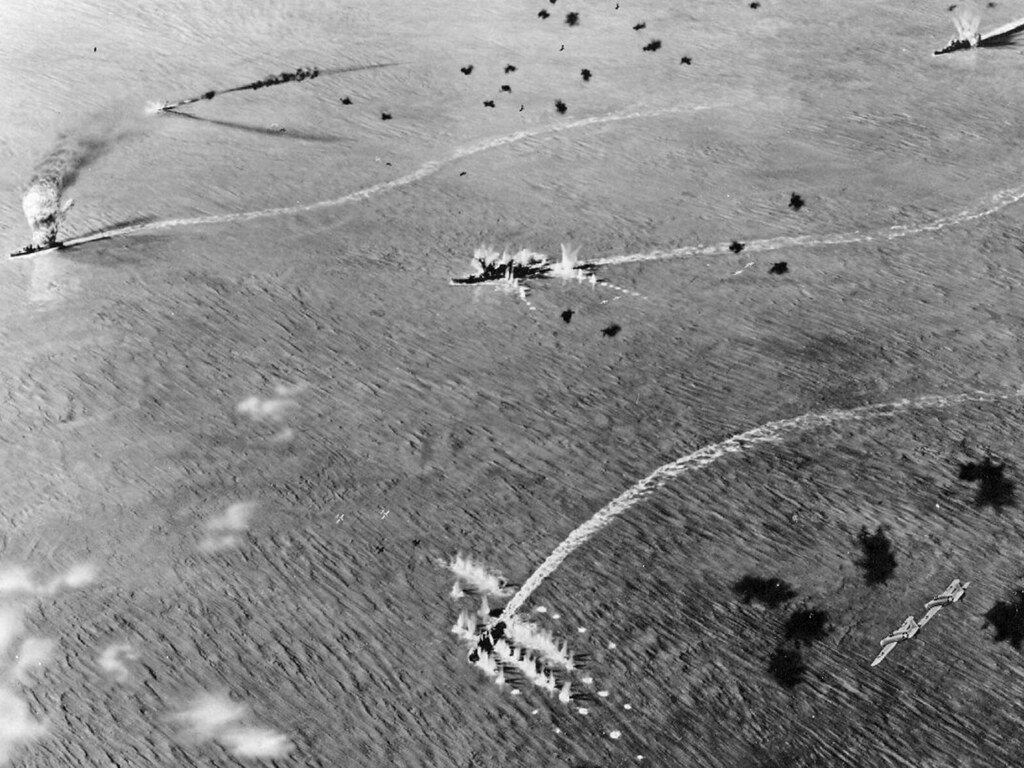
A more inviting target could not be had for US SBD Dauntless dive bombers.
Within ten minutes, three Japanese carriers were burning end to end and sinking.
It was only a matter of time until a fourth was caught and knocked out too.
That one remaining Japanese carrier, Hiryu, launched air strikes that crippled Yorktown with three bombs and two torpedoes striking home during two separate attacks. The torpedo attacks doomed the American carrier. In late afternoon, a mixed squadron of Enterprise and Yorktown bombers, flying from Enterprise, (as stated) found her and disabled Hiryu, leaving her burning.
The following day Enterprise dive bombers alone sank cruiser Mikuma. While Yorktown and Hammann were the only American ships sunk, TF 16 and TF 17 lost a total of 113 planes, 61 of them in combat, during the battle. Japanese losses were much larger: four carriers, one cruiser and 272 carrier aircraft were destroyd in this decisive battle.
Enterprise was also attacked...but it was the Hornet that took the hits. Enterprise put up a very effective anti-air defense.
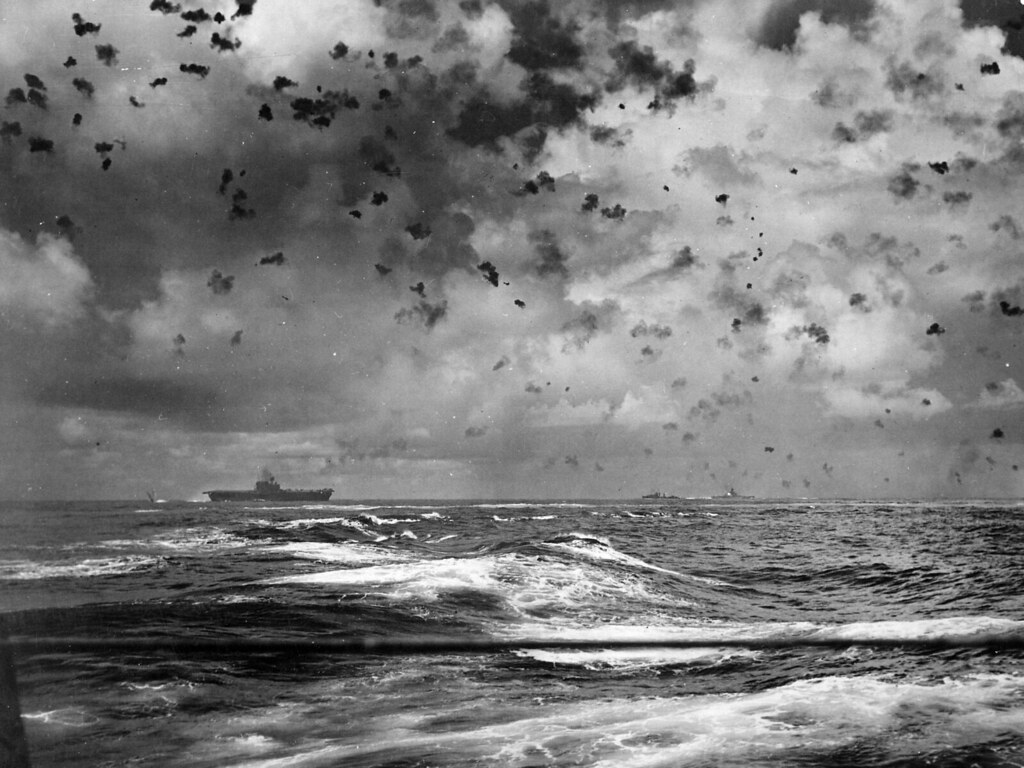
Despite losses to her aircraft squadrons, Enterprise came through undamaged and returned to Pearl Harbor on 13 June 1942. And there was a LOT of very serious fighting ahead, despite the tremendous victory at Midway.
Guadalcanal and the South Pacific:
After a month of rest and overhaul, Enterprise sailed on 15 July 1942 for the South Pacific, where she joined TF 61 to support the amphibious landings in the Solomon Islands and Gualdalcanal on 8 August. For the next two weeks, the carrier and her planes guarded seaborne communication lines southwest of the Solomons. On 24 August, a strong Japanese force was discovered some 200 miles (300 km) north of Guadalcanal, and TF 61 sent planes to the attack.
This was the first time that the Grim Reapers of VF-10 deployed from Enterprise under commanding officer James H. Flatley, who became known as "Reaper Leader." In the ensuing Battle of the Eastern Solomons, the light carrier Ryujo was sunk, and the Japanese troops intended for Guadalcanal were forced back. In the battle, Enterprise suffered most heavily of the American ships. She tookthree direct bomb hits and four near misses killed 74, wounded 95, and inflicted serious damage on the carrier. BUt amazingly, quick, hard work by damage control parties patched her up so that she was able to return to Hawaii under her own power.
Repaired at Pearl Harbor from 10 September-16 October 1942, Enterprise departed once more for the South Pacific, where with Hornet she formed TF 61. On 26 October, Enterprise scout planes located a Japanese carrier force and the major Battle of the Santa Cruz Islands ensued. Enterprise aircraft struck carriers and cruisers during the struggle, while the Big E herself underwent intensive attack. Hit twice by bombs, Enterprise lost 44 men and had 75 wounded. Despite serious damage, she continued in action and took on board a large number of planes and crewmen from her old friend, th USS Hornet which was sunk in the battle.
Though the American losses of a carrier and a destroyer were more severe than the Japanese loss of one light cruiser, the battle did gain time to reinforce Guadalcanal against the next enemy onslaught, and Henderson Field on the Island was secure. The loss of the Hornet meant Enterprise was now the only functioning US carrier left in the entire Pacific Ocena...and she herself was damaged.
On the flight deck, the crew posted a sign: "Enterprise vs Japan," and the war continued for USS Enterprise.
Continuing to fight, on August 24, 1942, a Japanese bomb exploded on the flight deck of Enterprise on 24 August 1942, during the Battle of the Eastern Solomons, causing minor damage.
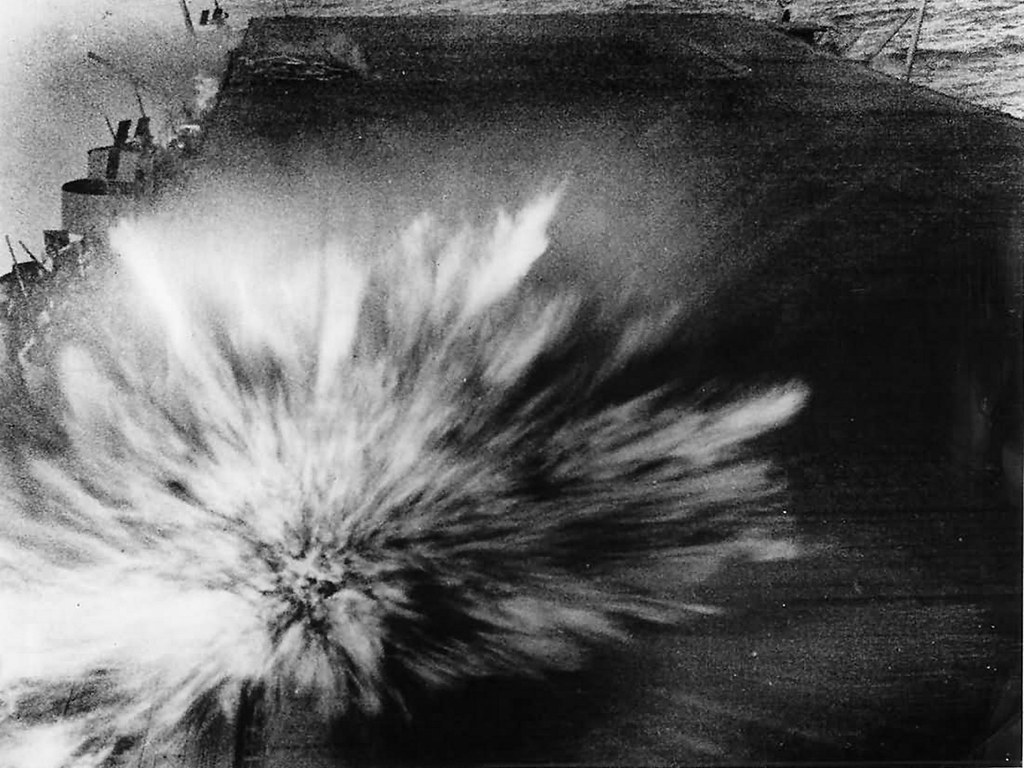
Enterprise salied for Nouméa, New Caledonia on 30 October for repairs, but a new Japanese thrust at the Solomons demanded her presence and she only had eleven days, with repair crews from Vestal still working on board continuously.
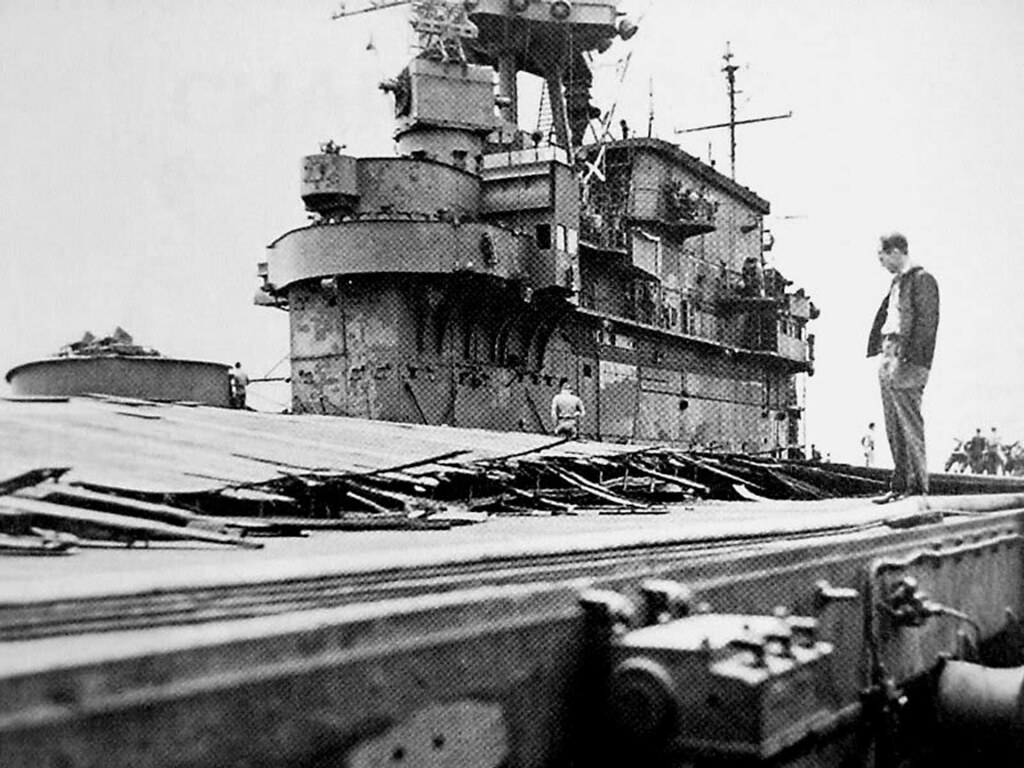
Underway with orders to engage the enemy, reair crew continued their repair work even during the forthcoming battle. Ship repairs fell under the round-the-clock supervision of her damage control officer Lieutenant Commander Herschel Albert Smith, who commented on the situation with this comment, "She made the open sea with her decks still shaking and echoing to air hammers, with welders' arcs still sparking, with a big bulge in her right side forward, without water tight integrity and one oil tank still leaking, and with her forward elevator still jammed as it had been since the bomb at Santa Cruz broke in half.".
This remarkable job later won the praise of Vice Admiral William Halsey, Jr., USN, Commander South Pacific Area and the South Pacific Force, who sent a dispatch to the OIC of the Seabee detachment stating: "Your commander wishes to express to you and the men of the Construction Battalion serving under you his appreciation for the services rendered by you in effecting emergency repairs during action against the enemy. The repairs were completed by these men with speed and efficiency. I hereby commend them for their willingness, zeal, and capability."
On 13 November, aviators from Enterprise helped to sink the Japanese battleship Hiei, the first Japanese battleship lost during the war during the Naval Battel of Guadalcanal. When that battle ended on 15 November 1942, Enterprise had shared in sinking sixteen ships and damaging eight more. The carrier returned to Nouméa on 16 November to complete her repairs.
Sailing again on 4 December, Enterprise operated out of Espiritu Santo, New Hebrides, until 28 January 1943, when she departed for the Solomons area once again. On 30 January, her fighters flew combat air patrol for a cruiser–destroyer group during the Battle of Rennell Island. Despite the destruction of most of the attacking Japanese bombers by Enterprise planes, the heavy cruiser USS Chicago was sunk by aerial torpedoes.
Detached after the battle, the carrier arrived at Espiritu Santo on 1 February, and for the next three months operated out of that base, covering U.S. surface forces up to the Solomons. Enterprise then steamed to Pearl Harbor where, on 27 May 1943, Admiral Chester Nimitz presented the ship with the first Presidential Unit citation ever awarded to an aircraft carrier.
In the summer of 1943, with the new Essex-class and Independence-class carriers joining the American Pacific Fleet, Enterprise was temporarily relieved, and on 20 July, she entered Puget Sound Naval Shipyard for a much-needed major overhaul. Over the course of several months, Enterprise received an extensive refit, which included, among other upgrades, many new anti-aircraft weapons and an anti-torpedo blister that significantly improved her underwater protection
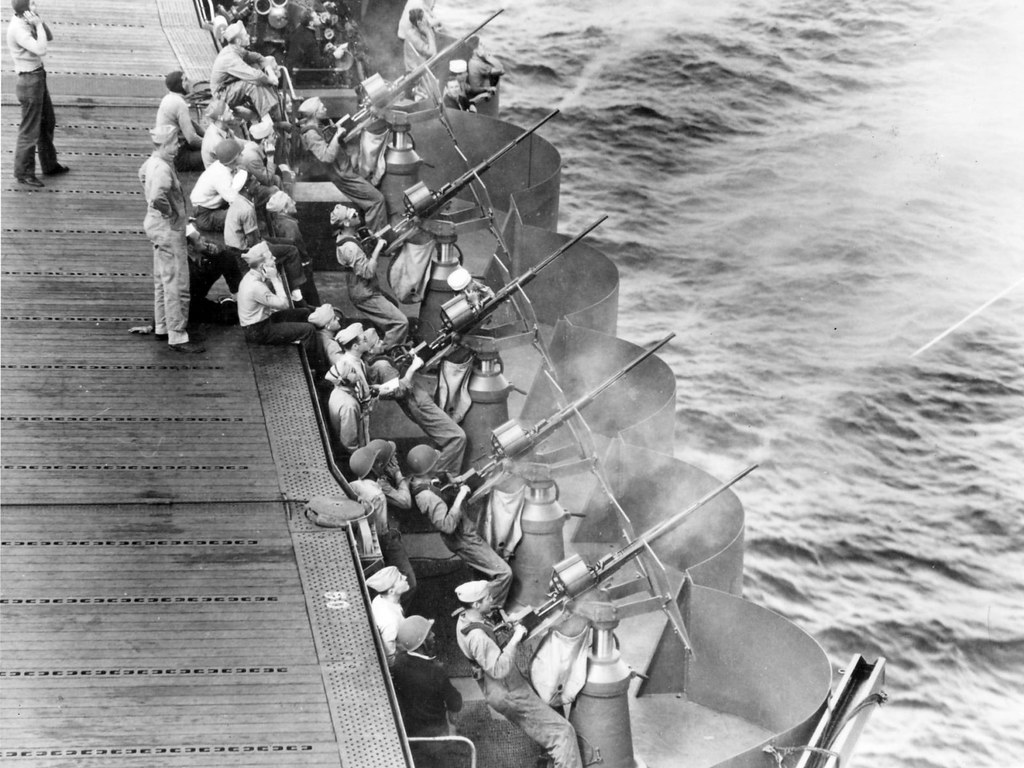
The Marshall and Mariana Islands:
The Marshall Islands
By mid-November, Enterprise joined in providing close air support to the 27th Infantry Division landing on Makin Atoll. On the night of 26 November, Enterprise introduced carrier-based night fighters to the Pacific when a three-plane team from the ship broke up a large group of land-based bombers attacking TG 50.2.
The carrier's next operation was with the Fast Carrier Task Force in softening up the Marshall Islands and supporting the landings on Kwajalein, from 29 January-3 February 1944. Then, Enterprise sailed, still with TF 58, to strike the Japanese naval base at Truk Lagoon in the Caroline Islands, on 17 February. Again Enterprise made aviation history, when she launched the first night radar bombing attack from a U.S. carrier. The twelve torpedo bombers in this strike achieved excellent results, accounting for nearly one-third of the 200,000 tons of shipping destroyed by aircraft.
Detached from TF 58 with escorts, Enterprise launched raids on Jaluit Atoll on 20 February, then steamed to Majuro and Espiritu Santo. Sailing on 15 March in TG 36.1, she provided air cover and close support for the landings on Emirau Island. The carrier rejoined TF 58 on 26 March, and for the next 12 days, joined in a series of strikes against the islands of Yap, Ulithi, Woleai, and Palau. After a week's rest and replenishment at Majuro, Enterprise sailed on 14 April to support landings on Hollandia near New Guinea, and then hit Truk again from 29–30 April.
On 6 June 1944, she and her companions of TG 58.3 sortied from Majuro to join the rest of TF 58 in attacking the Marianas Islands. Striking Saipan, Rota, and Guam from 11–14 June, Enterprise pilots gave direct support to the landings on Saipan on 15 June, and covered the troops ashore for the next two days.
Aware that major Japanese naval attempt to break up the invasion of Saipan, Admiral Spruance, now Commander 5th Fleet, positioned TF 58 and USS Enterprise to meet the threat.
The Battle of the Phillipine Sea and Leyete Gulf:
The ensuing fight developed into the largest naval engagement in history.
On 19 June 1944, Enterprise was one of four carriers of Task Group 58.3 under the command of Rear Admiral John W. Reeves. For over eight hours, airmen of the United States and Imperial Japanese navies fought in the skies over TF 58 and the Marianas. Over the course of two days, a total of six American ships were damaged, and 130 planes and a total of 76 pilots and aircrew were lost. In sharp contrast, American carrier aircraft, with a major assist from U.S. submarines, sank three Japanese carriers (Hiyo, Shokaku, and Taiho), and destroyed 426 carrier aircraft, losses from which Japanese naval aviation would never recover.
Enterprise then participated both in the defense of the fleet and in the subsequent early-evening strike against the Japanese task forces. A planned midnight strike against the Japanese fleet by night-flying Enterprise pilots was cancelled because of the recovery and rescue operations required after the dusk attack. After the battle, Enterprise sailed for Pearl Harbor and a month of rest and overhaul. Sh was back in action on 24 August, the carrier sailed with TF 38 in that force's aerial assault on the Volcano and Bonin Islands from 31 August – 2 September, and Yap, Ulithi, and the Palaus from 6–8 September.
After operating west of the Palau Islands, Enterprise joined other units of TF 38 on 7 October and set course to the north. From 10–20 October, her aviators flew over Okinawa, Formosa, and the Philippines, blasting enemy airfields, shore installations, and shipping in preparation for the assault on Leyte. After supporting the Leyte landings on 20 October, Enterprise headed for Ulithi to replenish, but the approach of the Japanese fleet on 23 October called her back to action.
In the Battle of Leyte Gulf (23–26 October), Enterprise planes struck all three groups of enemy forces, battering battleships and destroyers before the action ended. As a result of the major Japanese breakthrough off Samar, which sank two US NAvy excort carriers, which had, with their light destroyer escort fourt courgeously to turn back that major Japanese thrues, the Enterprise remained on patrol east of Samar and Leyte until the end of October, then retired to Ulithi for supplies. During November, her aircraft struck targets in the Manila area, and at the island of Yap. She returned to Pearl Harbor on 6 December 1944.
1945, Okinawa, Kamikazis, and the end of the war:
Sailing on 24 December for the Philippines, Enterprise carried an air group specially trained in night carrier operations. She joined TG 38.5 and swept the waters north of Luzon and of the South China Sea during January 1945, striking shore targets and shipping from Formosa to Indo-China including an attack on Macau. After a brief visit to Ulithi, Enterprise joined TG 58.5 on 10 February 1945, and provided day and night combat air patrol for TF 58 as it struck Tokyo on 16–17 February. She then supported the Marines in the Battle of Iwo Jima from 19 February – 9 March, when she sailed for Ulithi. During one part of that period, Enterprise kept aircraft aloft continuously over Iwo Jima for 174 hours.
Departing Ulithi on 15 March, the carrier continued her night work in raids against Kyushu, Honshu, and shipping in the Inland Sea of Japan.
She was again damaged by an enemy bomb on 18 March, and so Enterprise entered Ulithi six days later for repairs. Back in action on 5 April, she supported the Okinawa operation until she was damaged on 11 April—this time by a kamikaze—and was forced back to Ulithi.

Off Okinawa once more on 6 May, Enterprise flew patrols around the clock as kamikaze attacks increased. On 14 May 1945, she suffered her last major wound of World War II when a kamikaze Zero, piloted by Lt. J.G. Shunsuke Tomiyasu, destroyed her forward elevator, killing 14 and wounding 34.
Despite the major damage, due to heroic damage control efforts once again, Enterprise was abe to make her ow way carrier sailed all the way back to the West Coast for repairs.
Three months later, in August, fully repaired at the Puget Sound Navy Yard. She received her full aircraft ciompliment and left port to return to the fight. But it was not to be so. She was degaussing/demagnetizing off the Strait of Juan de Fuca when the Nagasaki bombing ended the war on August 9, 1945.
Operation Magic Carpet after the War:
Restored to peak condition, Enterprise voyaged to Pearl Harbor where she took on soldiers returning home to the States. With some 1,141 servicemen due for discharge, including hospital patients and former POWs, she sialed to the west coast and disembarked these soldiers. She then sailed on to New York on 25 September 1945 via the Panama Canal arriving on 17 October 1945.

Two weeks later, she proceeded to Boston for installation of additional berthing facilities, then began a series of three Operation Magic Carpet voyages to Europe, bringing more than 10,000 veterans home in her final service to her country.
Her first European voyage returned 4668 serviceman from Southampton, England in November 1945. On the second trip to Europe, she was boarded by the British First Lord of the Admiralty, Sir Albert Alexander in Southampton, who presented Enterprise with a British Admiralty pennant that was hoisted when a majority of the Admiralty Board members were present. The pennant was given to the Big E as a token of respect from several high-ranking officers of an ally.
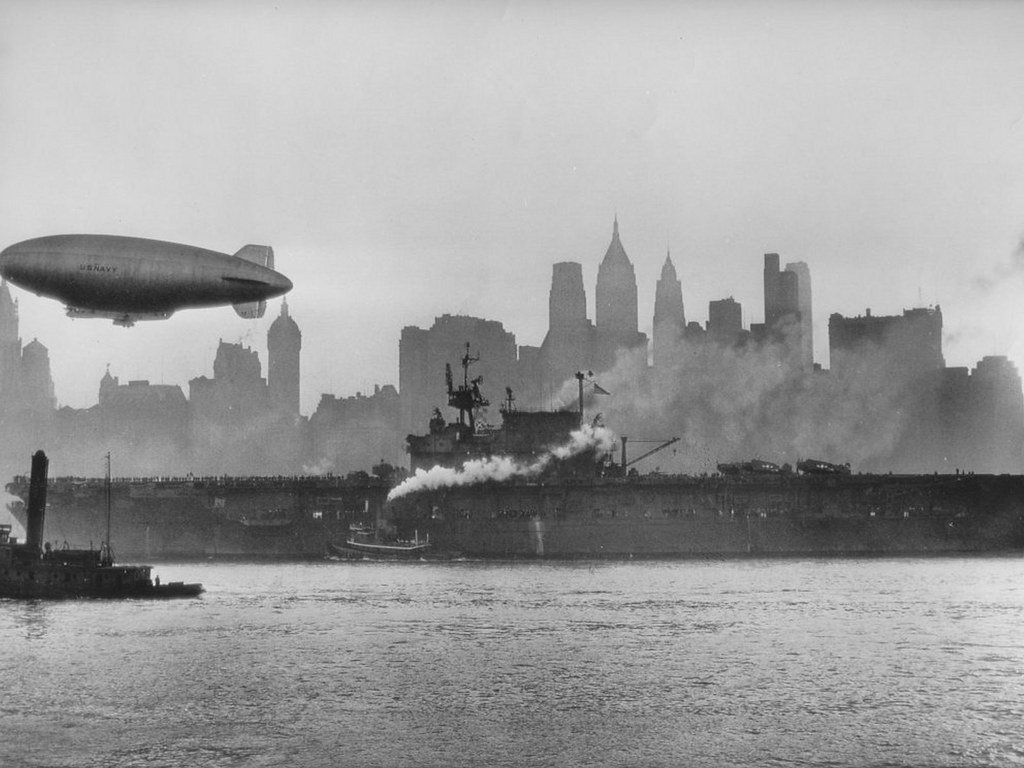
She returned to New York on 25 December 1945 with 4413 servicemen.[24] On this nine-day trip, she encountered four storms, some with winds of 80mph that caused 75 foot waves that swamped the forecastle deck in water up to 10 feet deep.
Her last voyage was to the Azores, and returned 3557 personnel, including 212 WACs to New York on 17 January 1946.
The end of the "Big E":
With the commissioning of over two dozen larger and more advanced aircraft carriers by end of 1945, Enterprise was deemed surplus for the post-war needs of America's navy. She entered the New York Naval Shipyard on 18 January 1946 for deactivation, and was decommissioned on 17 February 1947.
An effort was made to preserve the big E and for years the attempt sought to garner enough funds to turn her into a Museum ship.
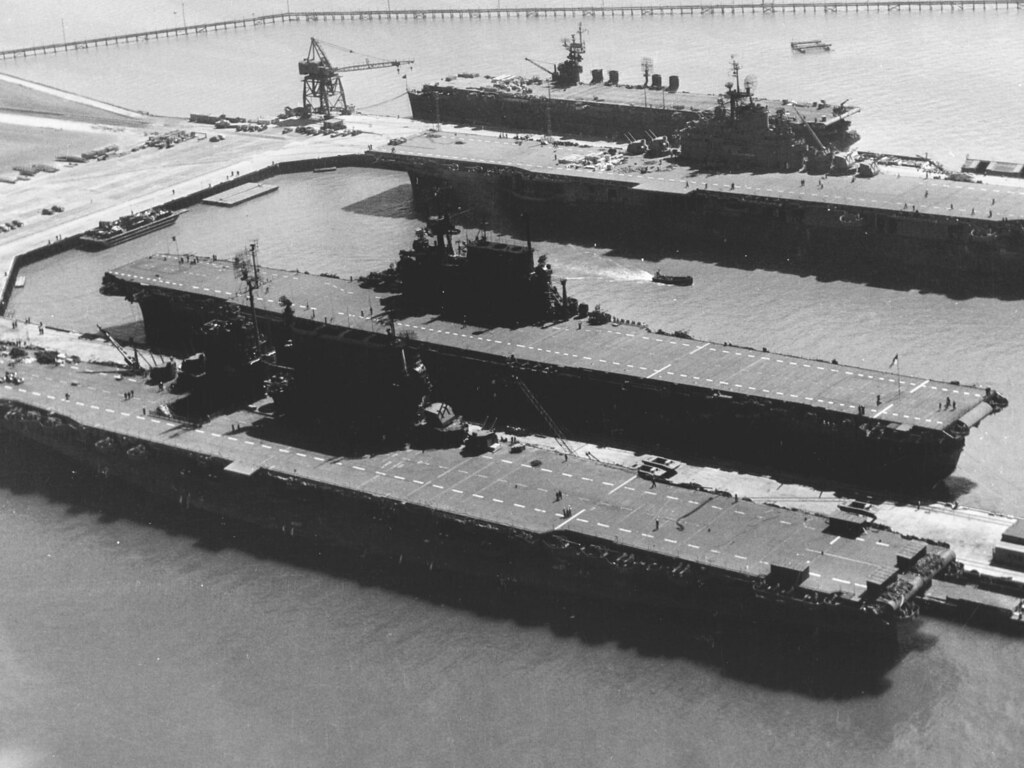
Sadly, though later the nation would do so for five Essex class carriers, the Big "E" was never set aside, and she was scrapped in 1960.
In 1984, a permanent "Enterprise Exhibit" was dedicated at the Naval Aviation Museum, Naval Air Station Pensacola, Florida to house artifacts, photos and other items of historical interest.
A memorial plaque was installed at the base of what is still called "Enterprise Tower."
The stern plate of USS Enterprise is located in River Vale, New Jersey.
In addition, surviving Enterprise artifacts include the ship's bell, which resides at the U.S. Naval Academy, where it is traditionally rung only after Midshipmen victories over West Point; and the sixteen-foot, one-ton nameplate from the ship's stern, which sits near a Little League park in River Vale, New Jersey. Her commissioning plaque and one of her anchors are on display at the Washington Navy Yard in Washington, D.C.
Thus ended the most decorated and hardest fighting ship in US history.
But her namesake continued her honor, and it perhaps fitting that it be this way.
Even as she was scrapped, a new USS Enterprise, CVN-65, the first nuclear aircraft carrier in history was built and commissioned...and then served aable for almost 52 years.
That carrier served in numerus conflicts against enemies of the Unites States, and herself became famous.
She is to be followed by another USS Enterprise aircraft carrier, CVN-80, the 3rd Ford clas carrier, which will start building in 2020 when the 2nd Ford class, the JFK, CVN-79, is launched.
Introduction and What's in the Box - April 12, 2017
Merit Intenational has come on very strong over the last few years as a very good marketer of ship models in particular.
The particularly do well in 1/350 scale, and also 1/200 scale. But I concentrae on the 1/350 scale.
Honestly, I think they use the same factory in China that Trumpeter uses, but most Merit International models come with very decent detail up sets included, and they have the same very fine detailing for plastic that the Trumperter models have. Such fine details that in many of those cases, once painted the plastic part is as good as a photo etch part would be.
Nonetheless, for the railing, sensors, and many other details, photo etch is still very desiraable, and this kit does not skimp. There are five full sheets of photo etch parts that come with this kit. so purchasing a detail up kit is not really necessary, uness you are seeking a fantastic amount of detail which a Pontos type detail up set can bring, which would include a wood deck, etc, and cost a couple of hundred dollars extra.
The kit also contins seventeen pllastic sprues withsomething on the order of 1200 pieces, as well as fifteen clear sprues, five each to build five TBD-1, Torpedo aircraft, five SBD-5 Dauntless Dive bombers, and five F4-5 Wildcat fighter aircraft, for a total airwing of fifteen aircraft that come with the kit. I intend to double that and have 30 aircraft altogether...12 F-4F Widcats, 12 SBD Duntless Dive Bombers, and six TBD Torpedo aicraft.
There is no waterline option for this model, which is fine by me because I build the full hulls anyway. If you wanted a waterline option you would have to scratch build it and cut off the hull at the waterline.
The kit has excellent detail for the Hangar Deck, with a full hangar deck available with excellent detail. The bow and stern of the vessel are also both very well detailed, with all of the structural components that were so intrinsic to the USS Enterprise.
The decal sheet is very detailed, with all of the deck and hull markings for the USS Enterprise in high quality water-slide decals.
The kit comes with an excellent full color, glossy, paint guide, and an outstanding instruction booklet, with Twenty full pages of detailed, clear and easy to follow instruction.
With patience aand care, this kit shuld almost build into museum quality by itself...and I intend and hope to make her that way.
Here's how she looks out of the box:
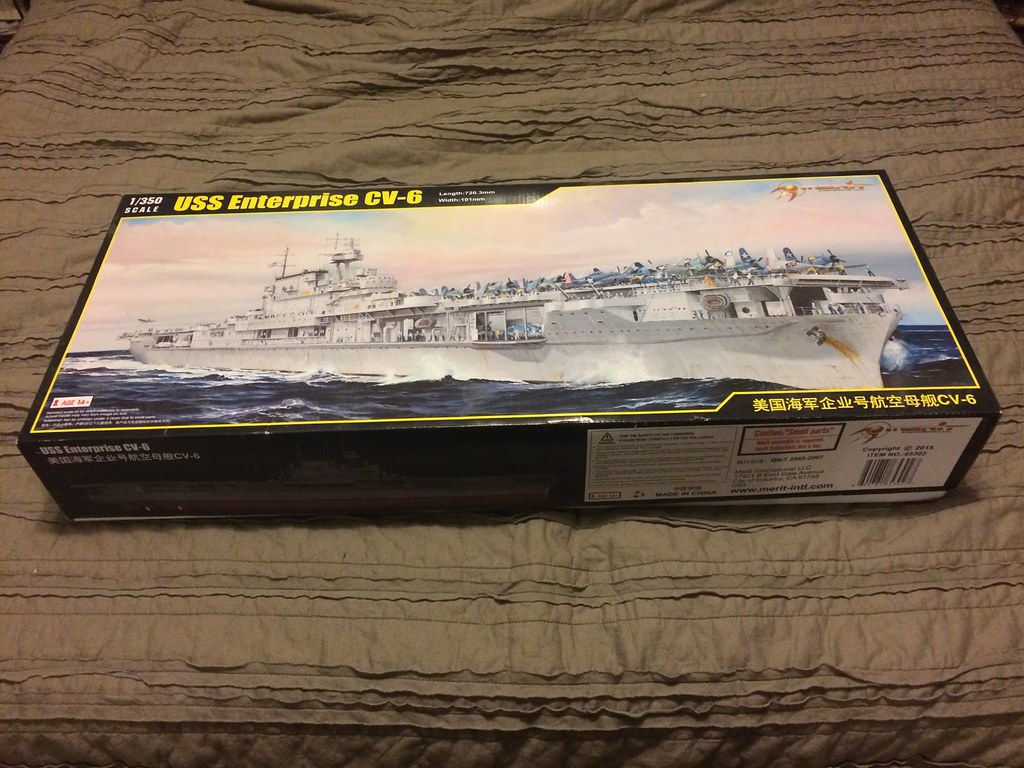
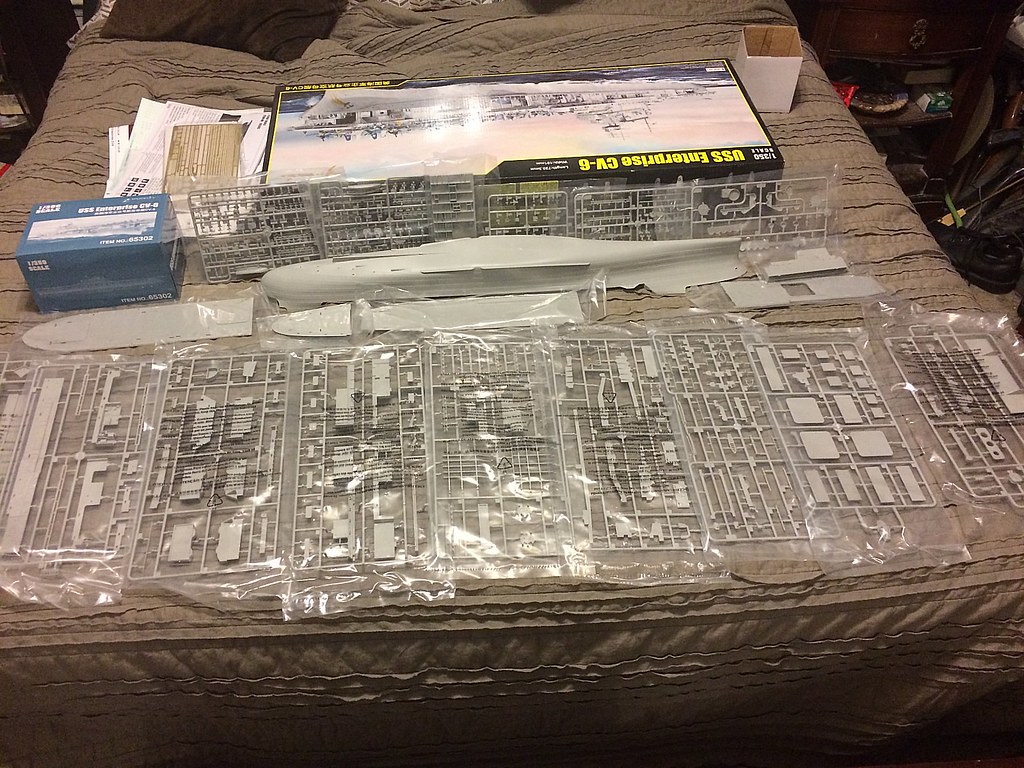
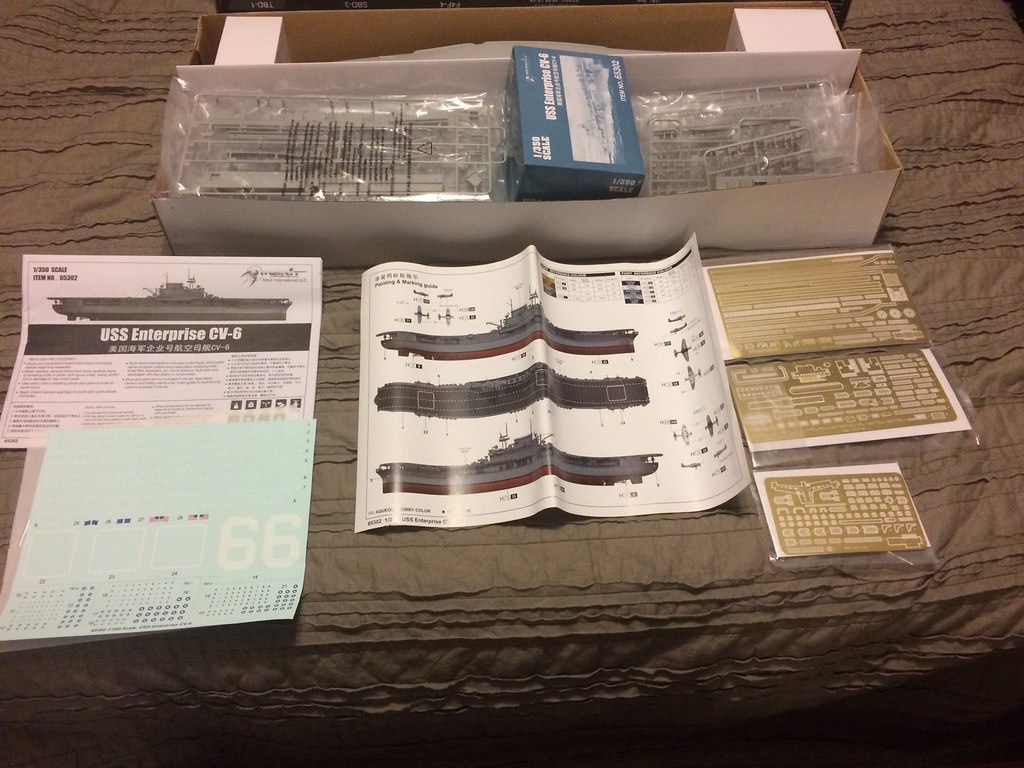


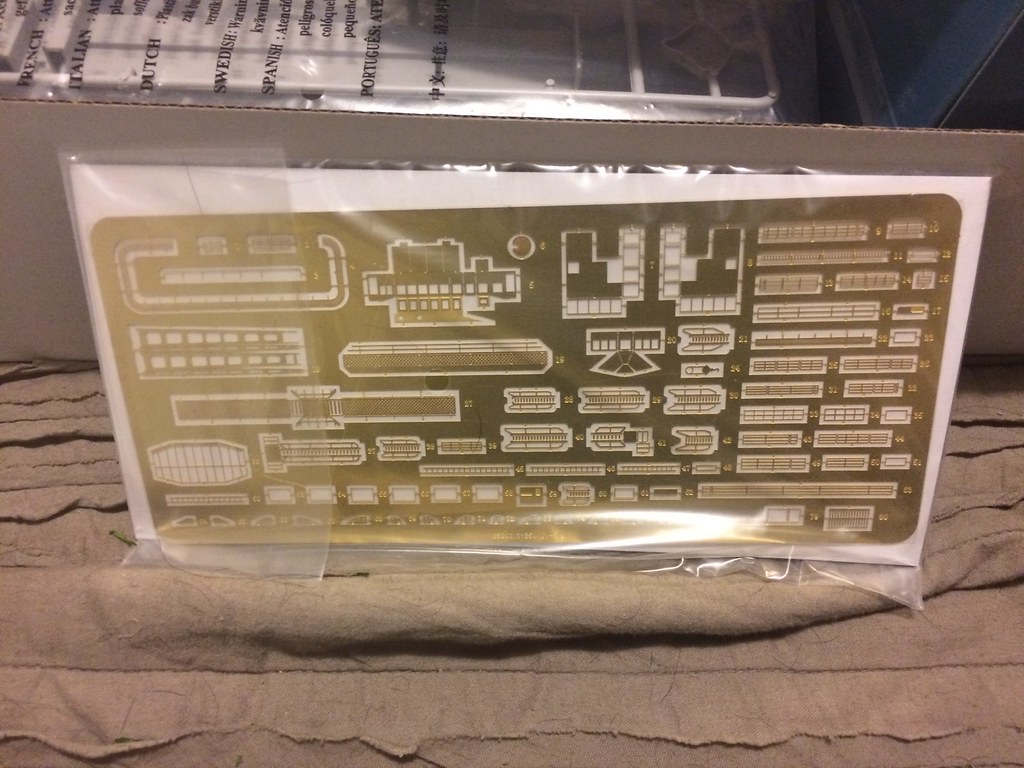
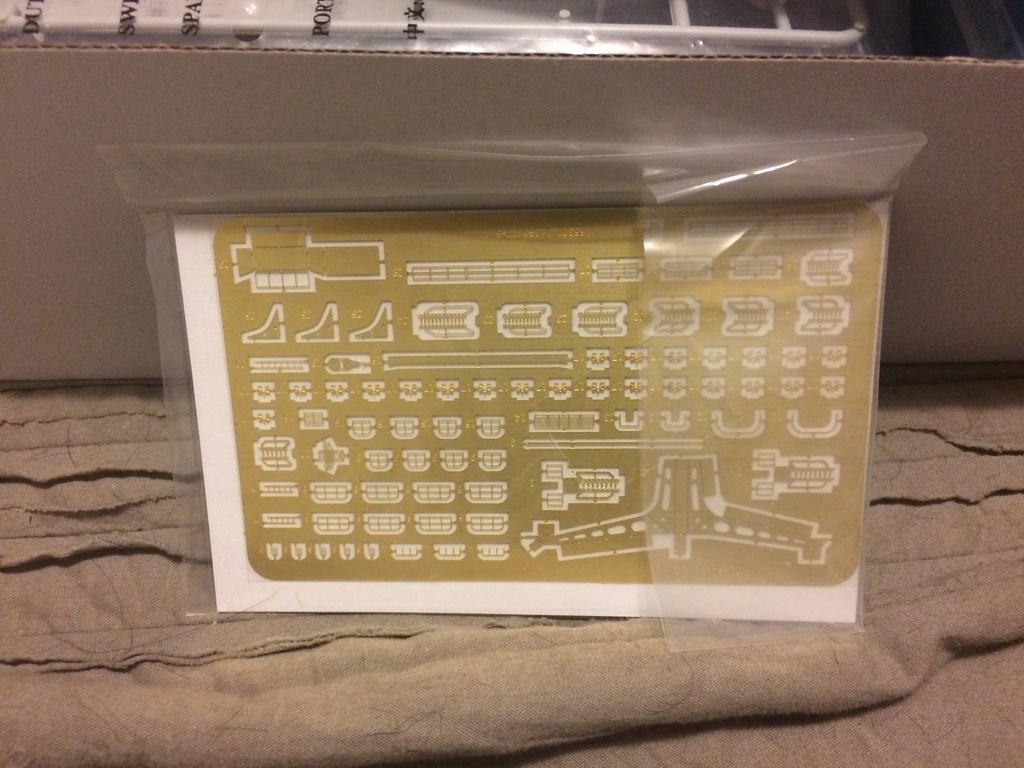
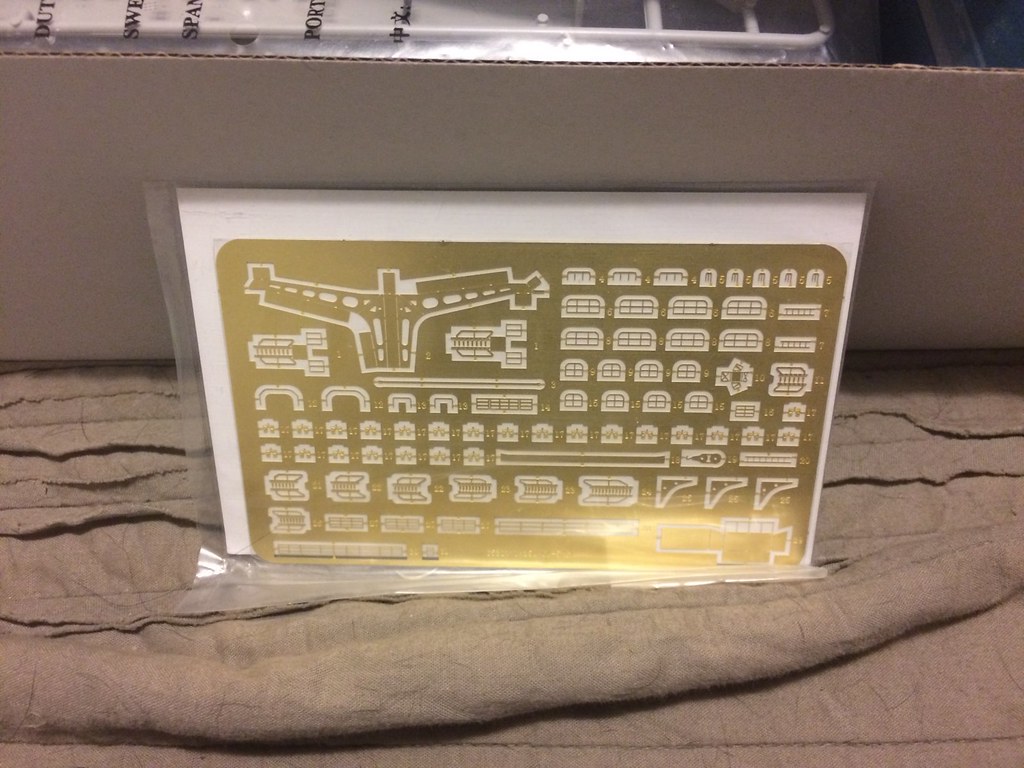
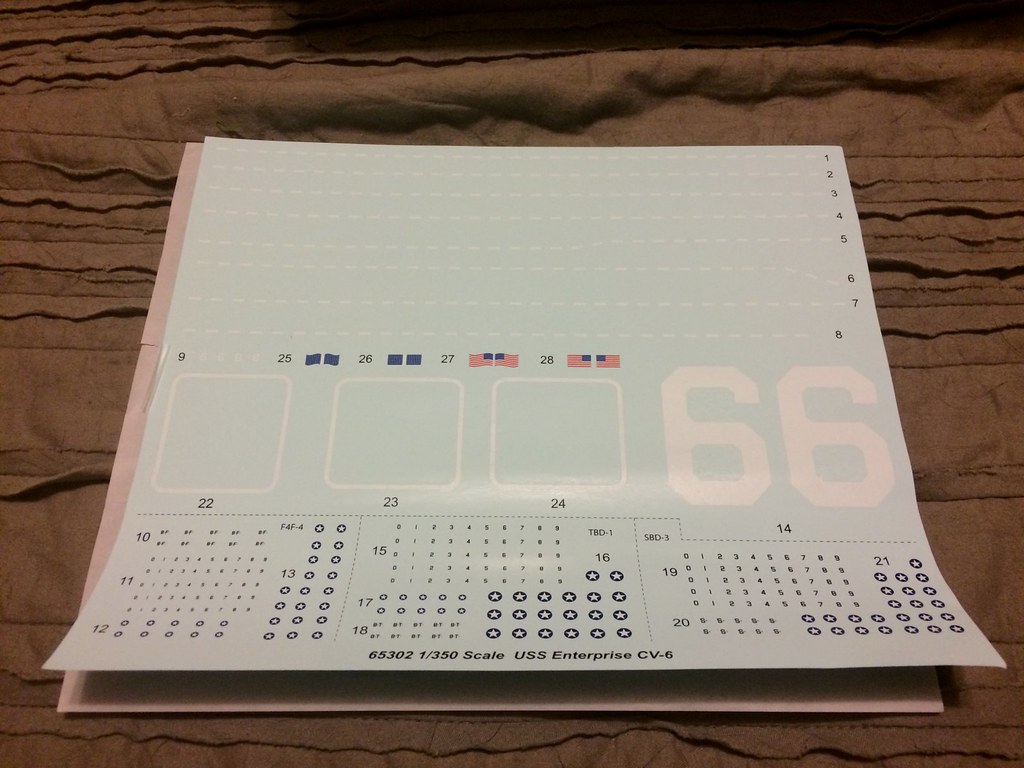
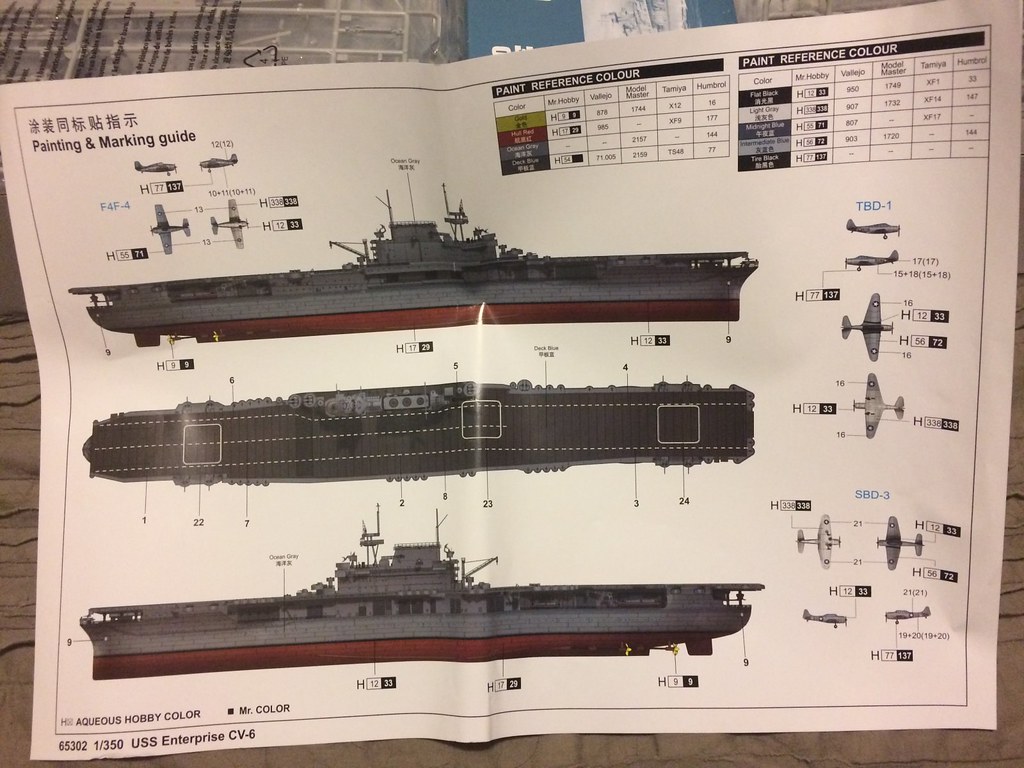
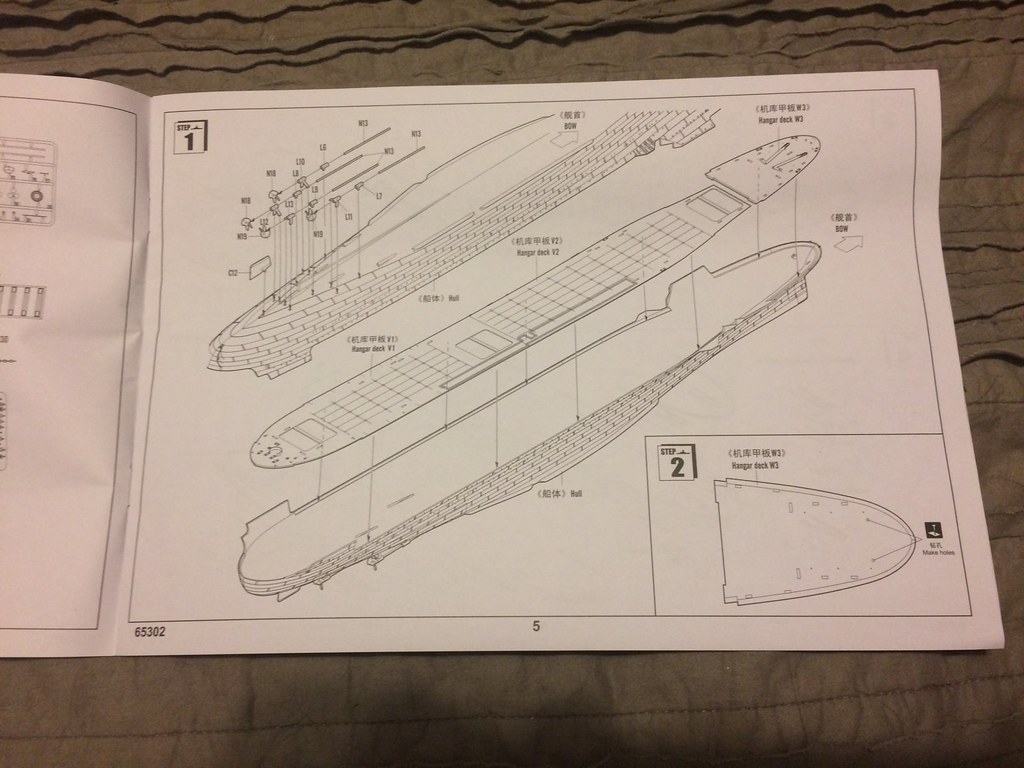

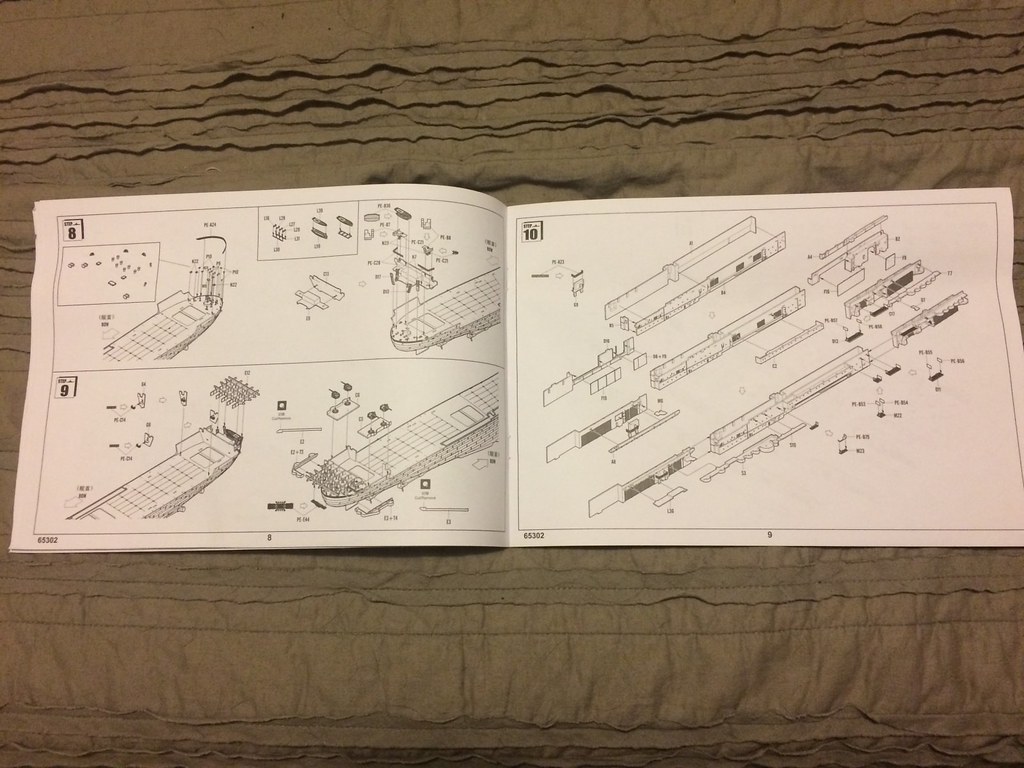
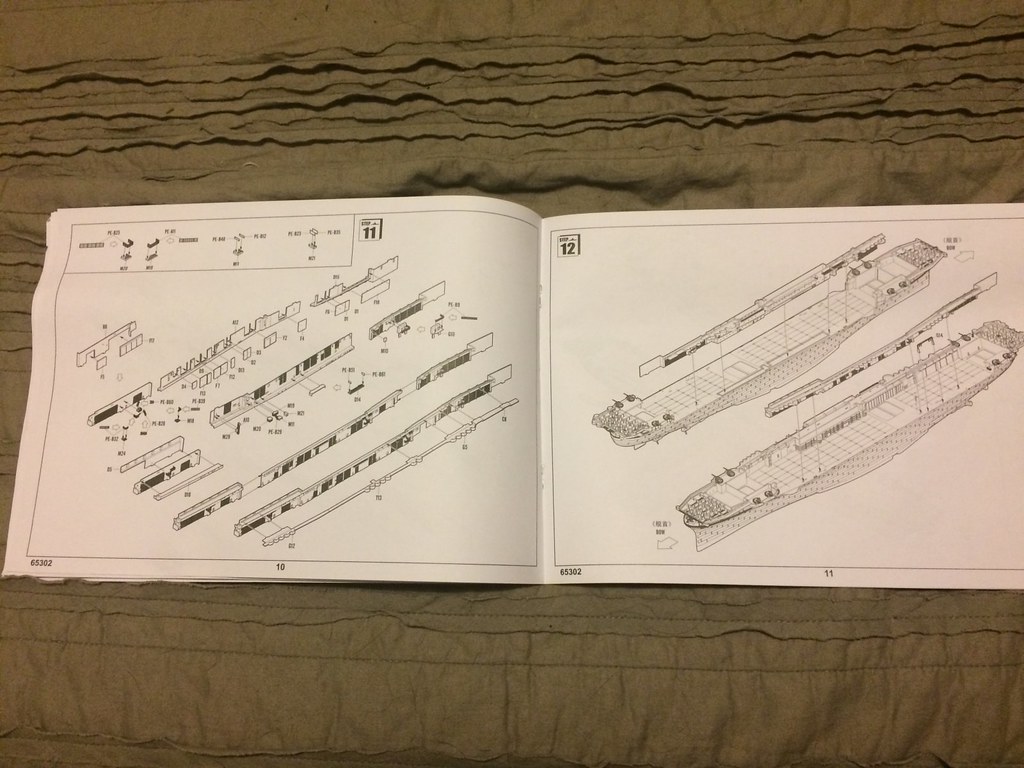
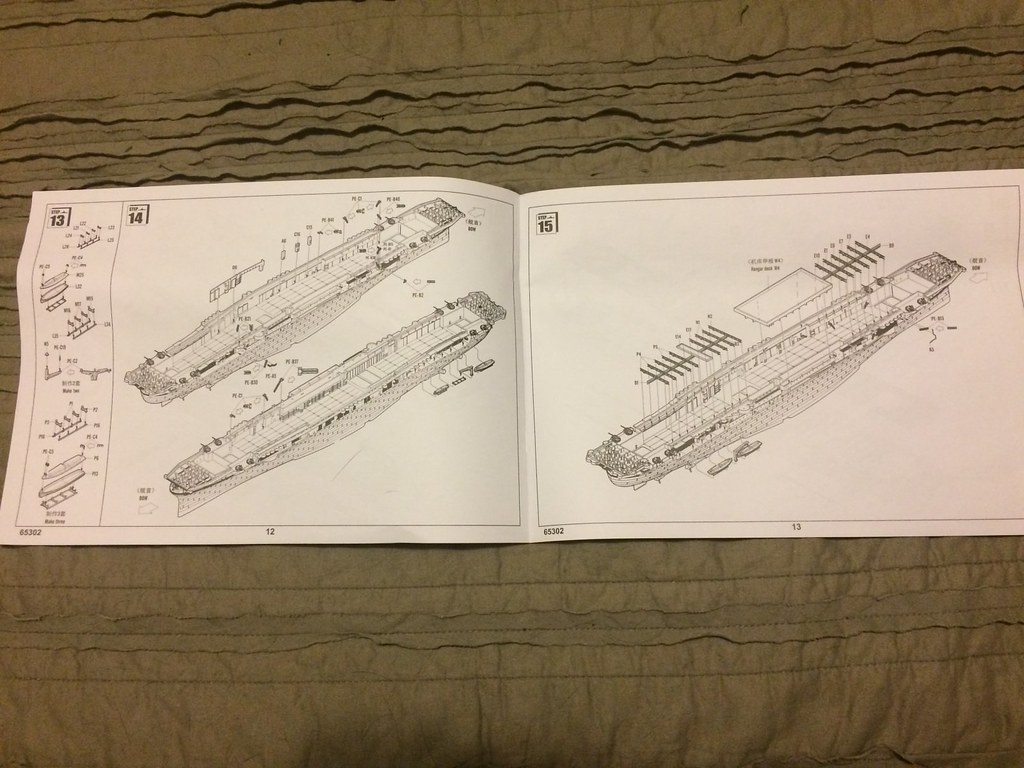
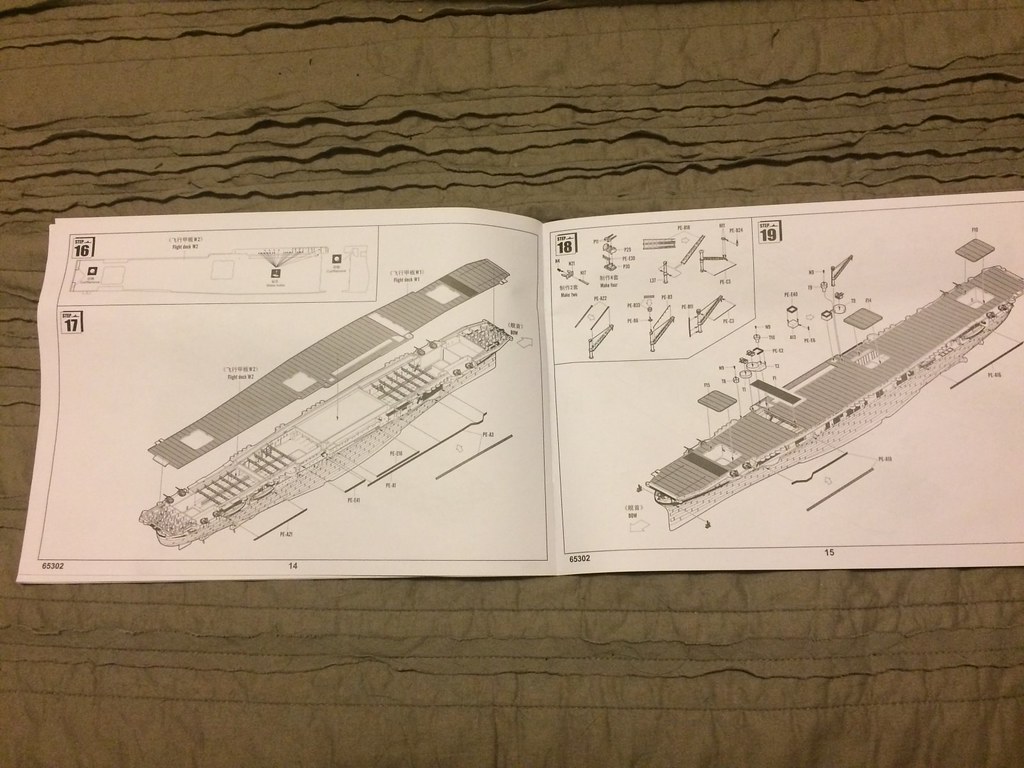

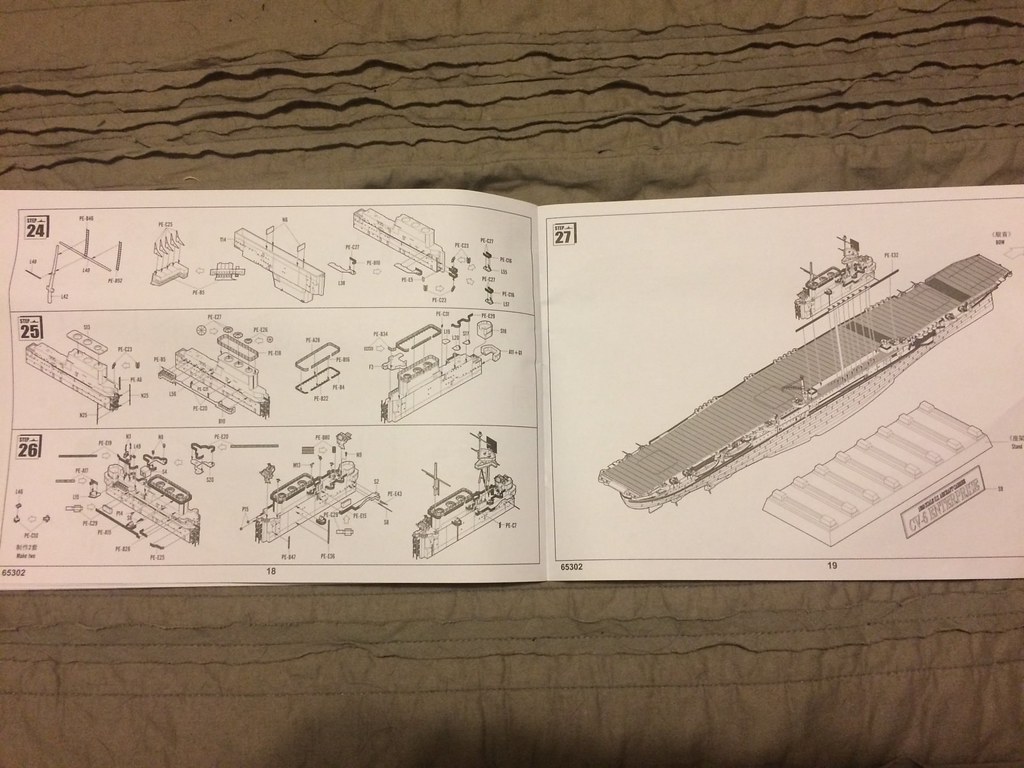
The Build - the hull, with props, supports, and shafts, and masking and painting - April 12, 2017
I started the model by adding the shafts, supports, and rudder, and then painting the vessel. I am using the Hull Red normal to US World Wr II ships, and using a bit darker gray for the enterprise as she was seen in 1942. I used Model MAster Flat Dark Gray for the vertical surfaces, and will use neutral gray for the weather deck. I will use the Blue Wood deck color for the flight deck.
Once the parts were added I msasked off the red, then the waterline in black, and then the upper hull in the darker gray.
Here's how that looked:
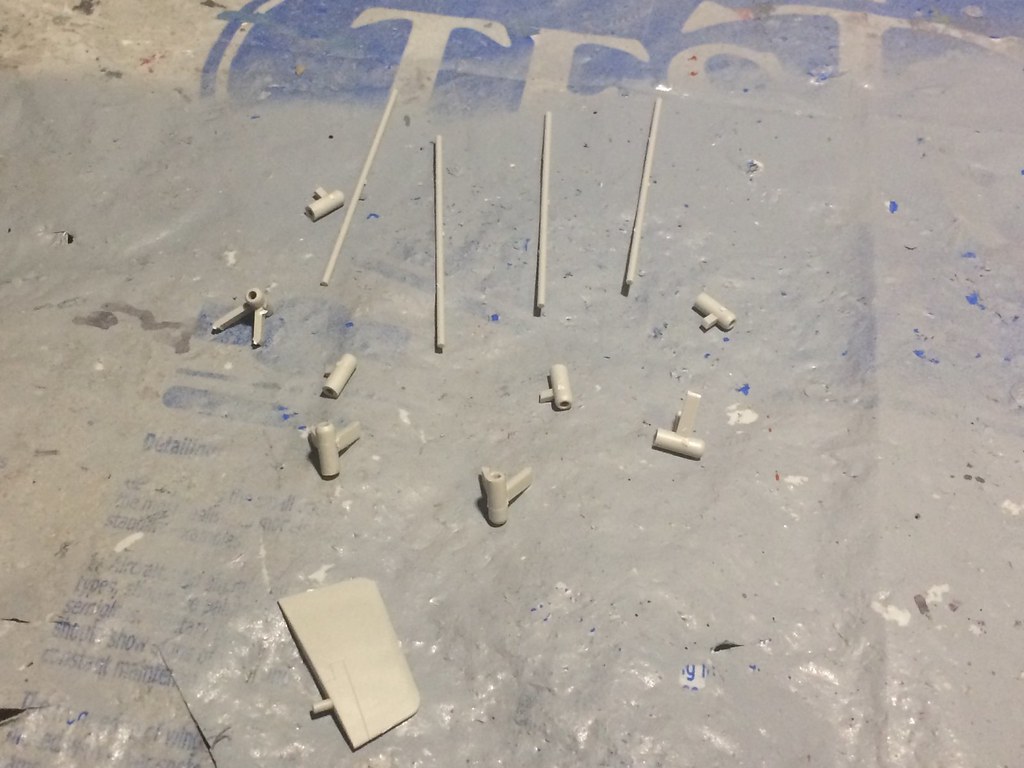
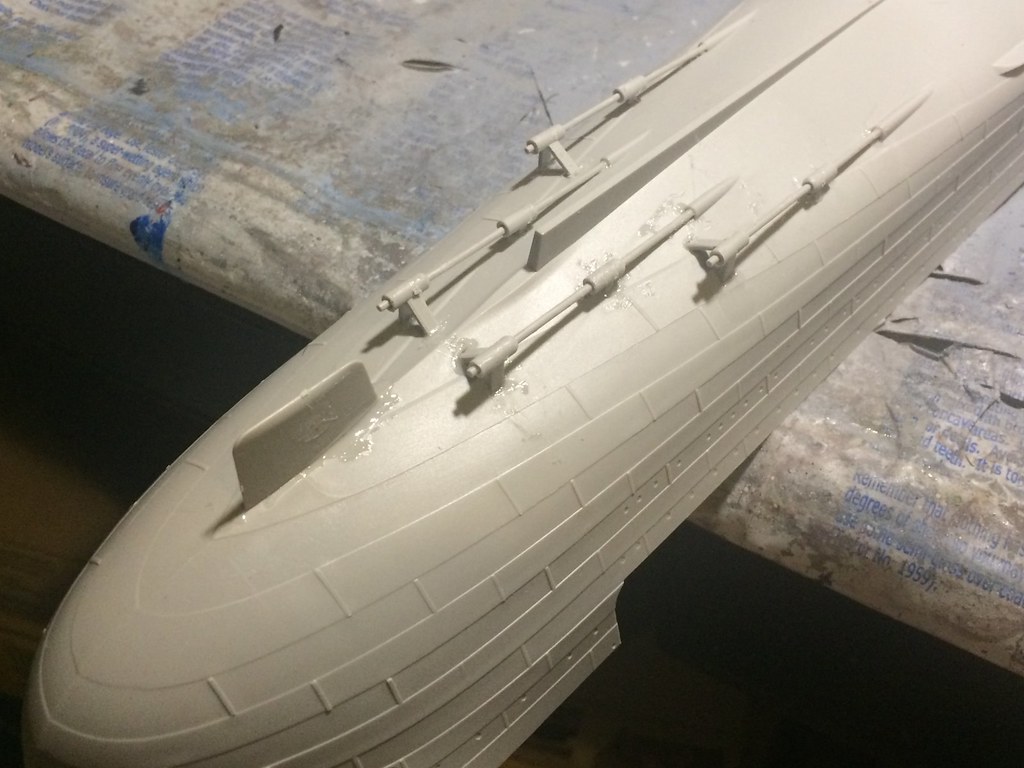
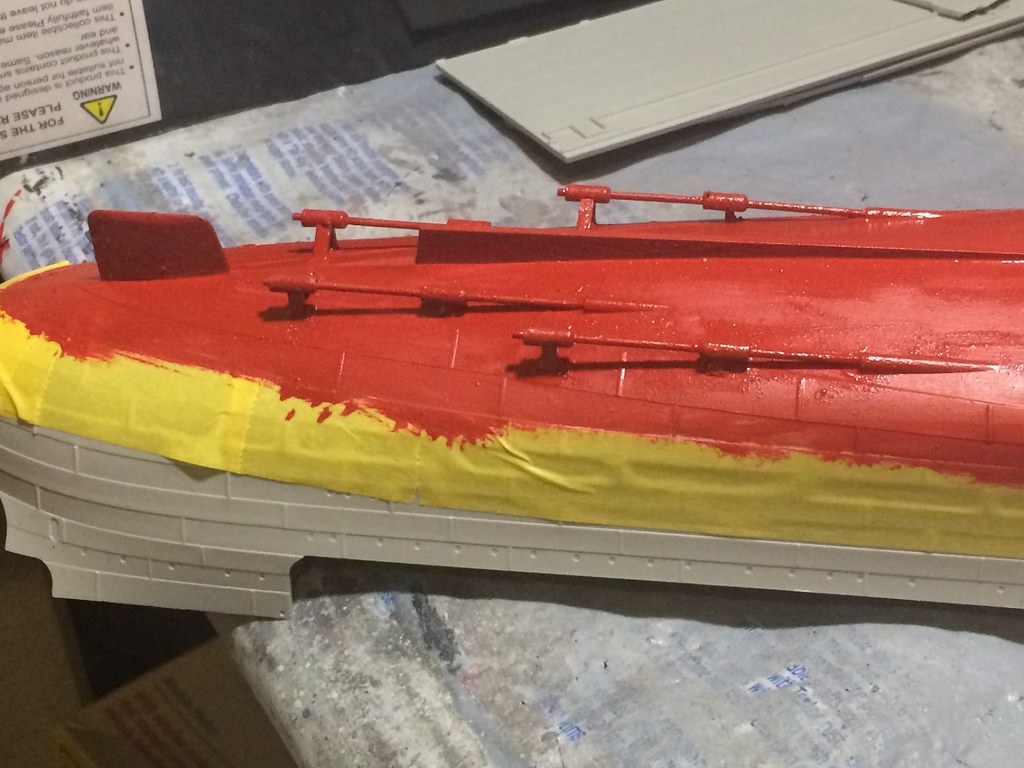
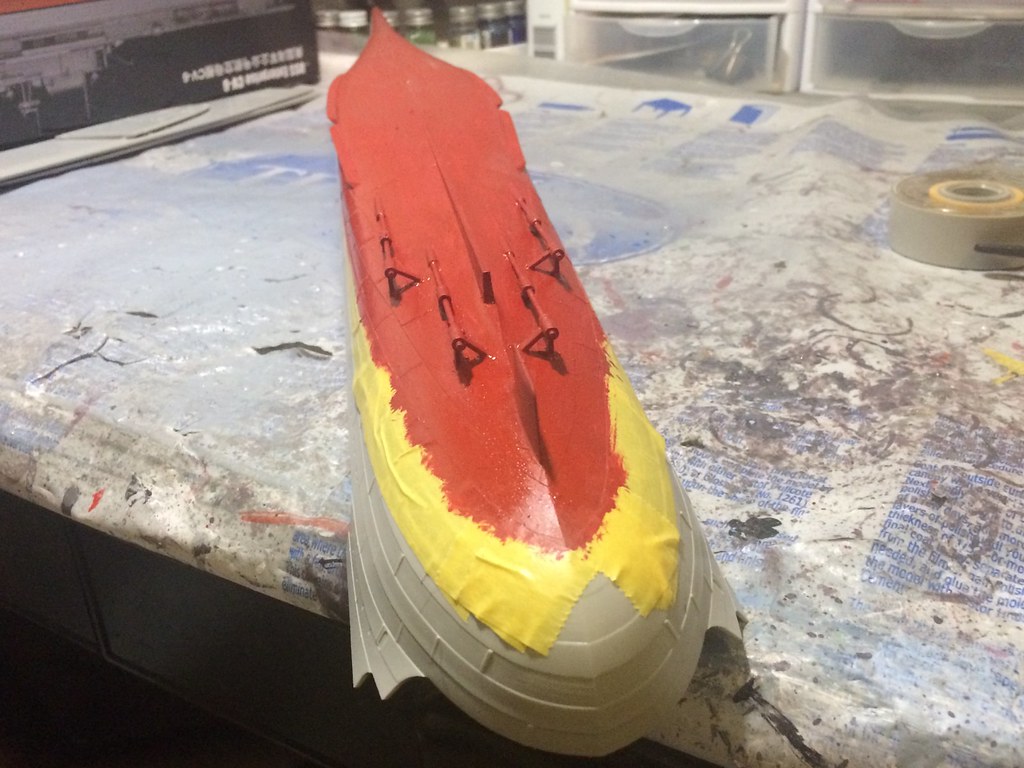
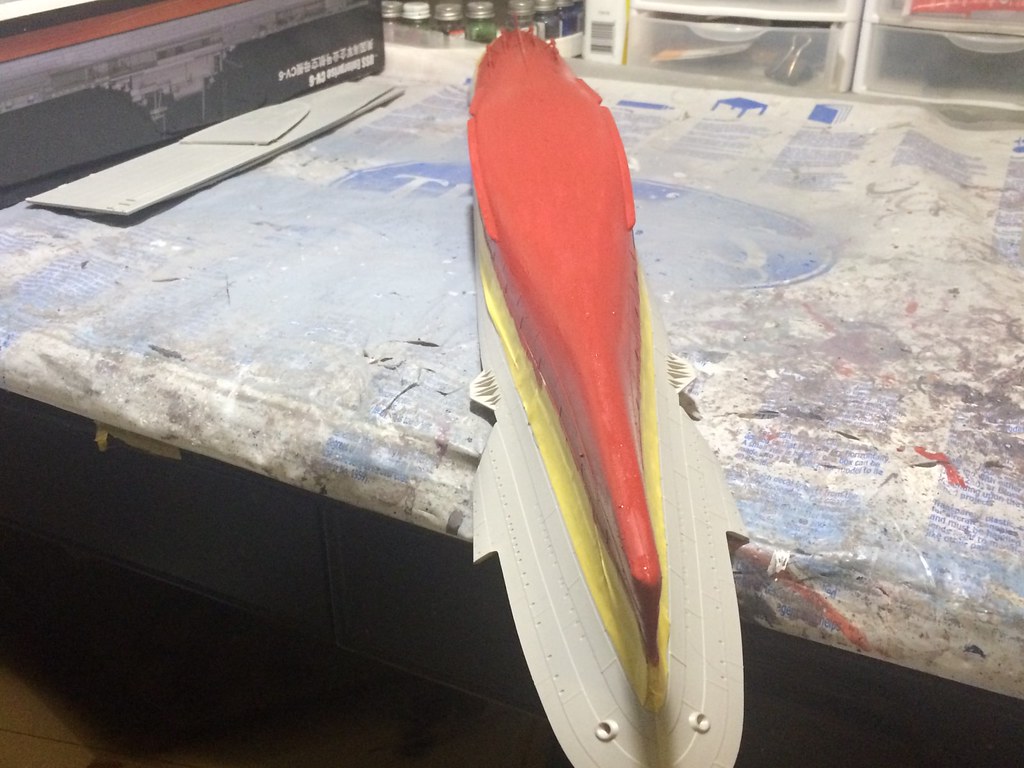
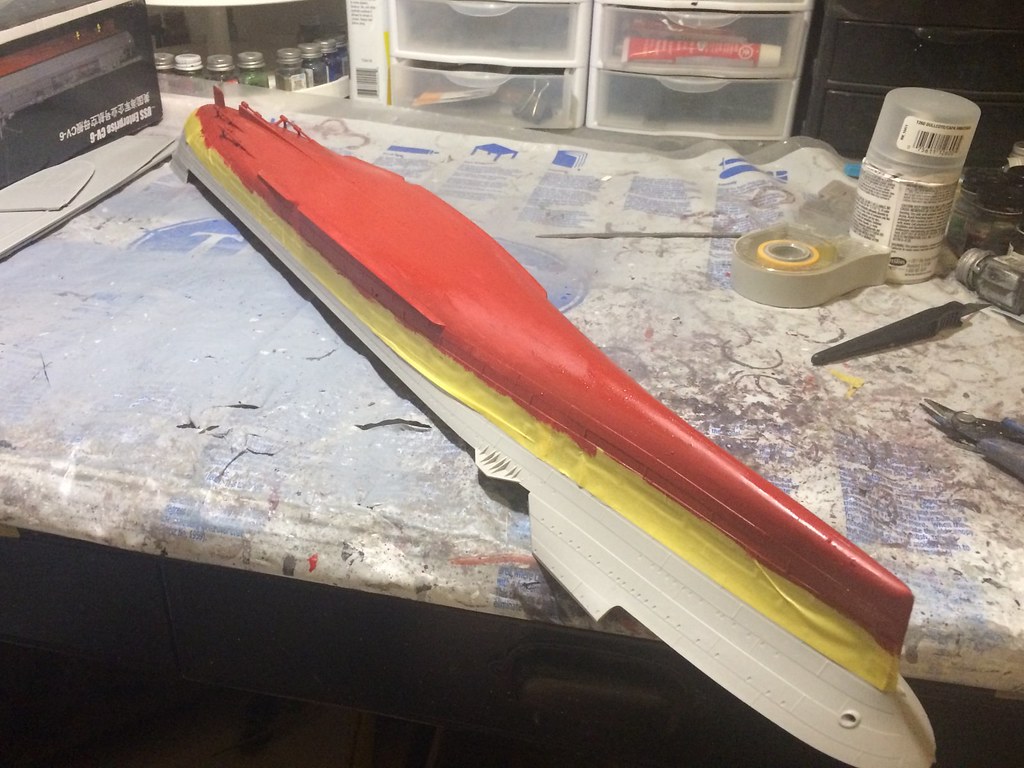

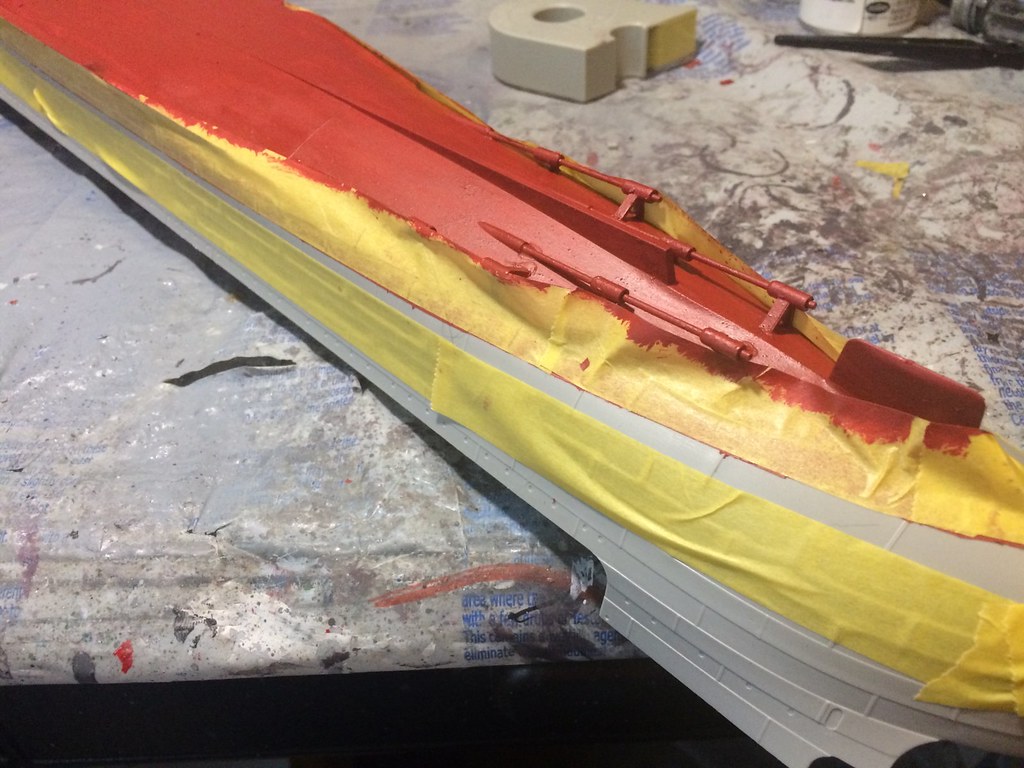
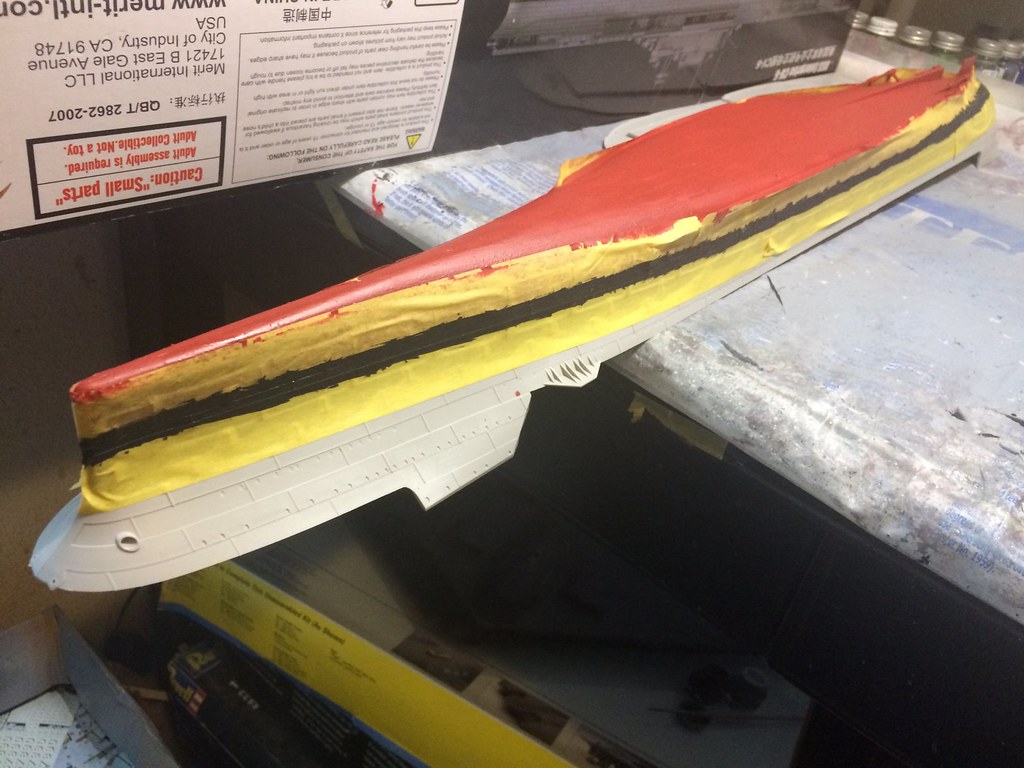
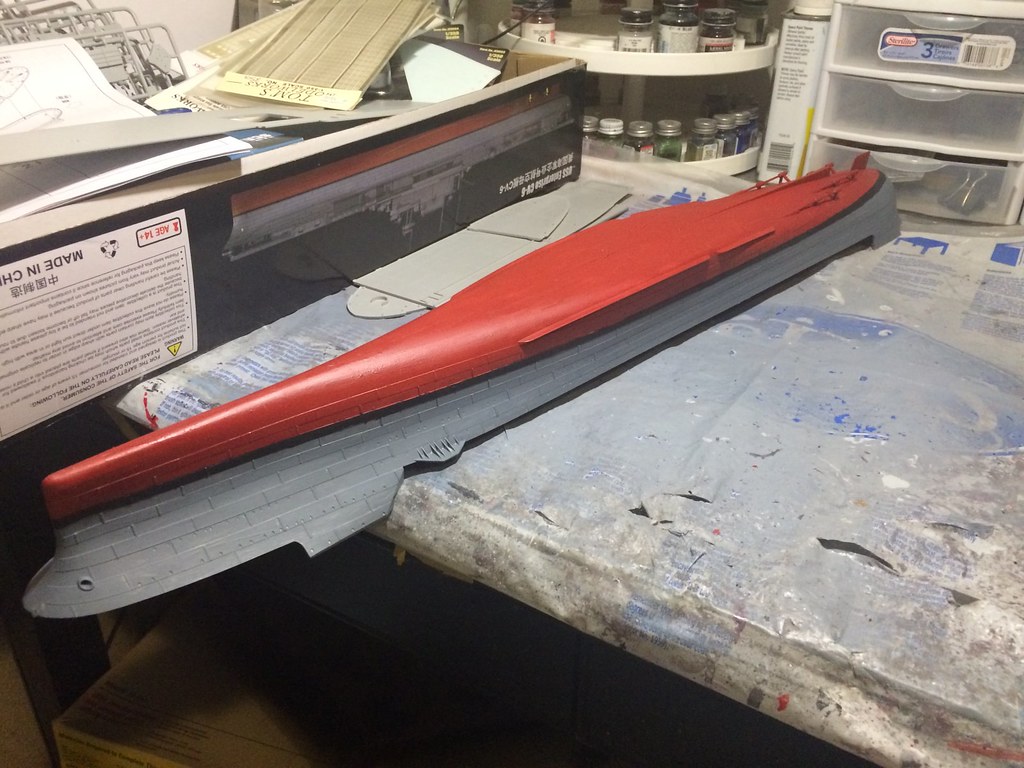

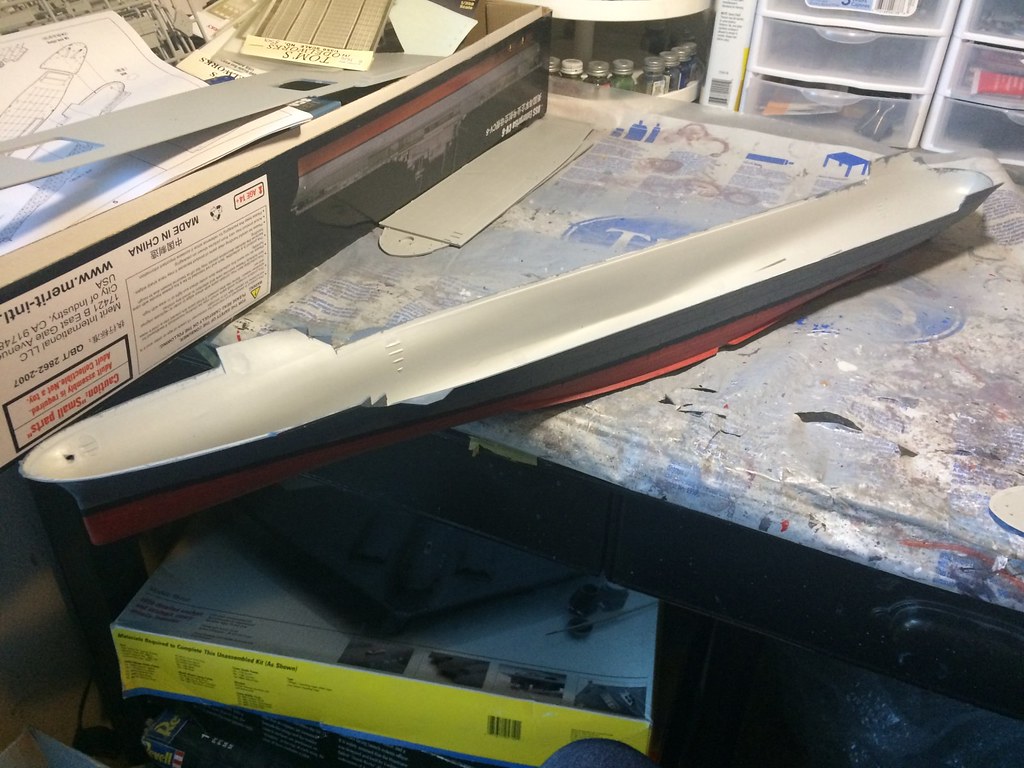
The Build - Adding the hanger, bow, and stern lower decls, and then building out the bow decks - April 15, 2017
I added the decks for the bow, stern, and the deck that will ultimately be detailed into the hanger deck.
I then [painted all of the detail parts that would be needed for this portion of the build...and there were a lot of parts.
I then built up the bow decks of the ship. Lots of detail on these decks, and the photo etch metal gets into play early on. This inludes the four five inch anti-aircraft guns on each end of the ship. Here's how that went:
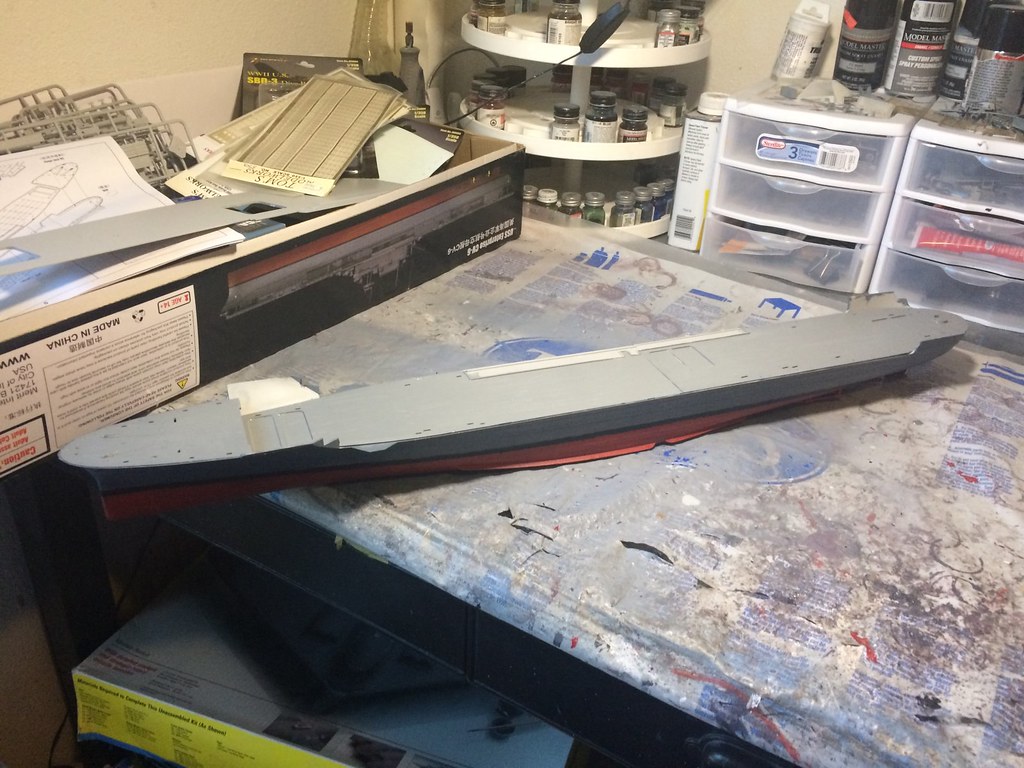
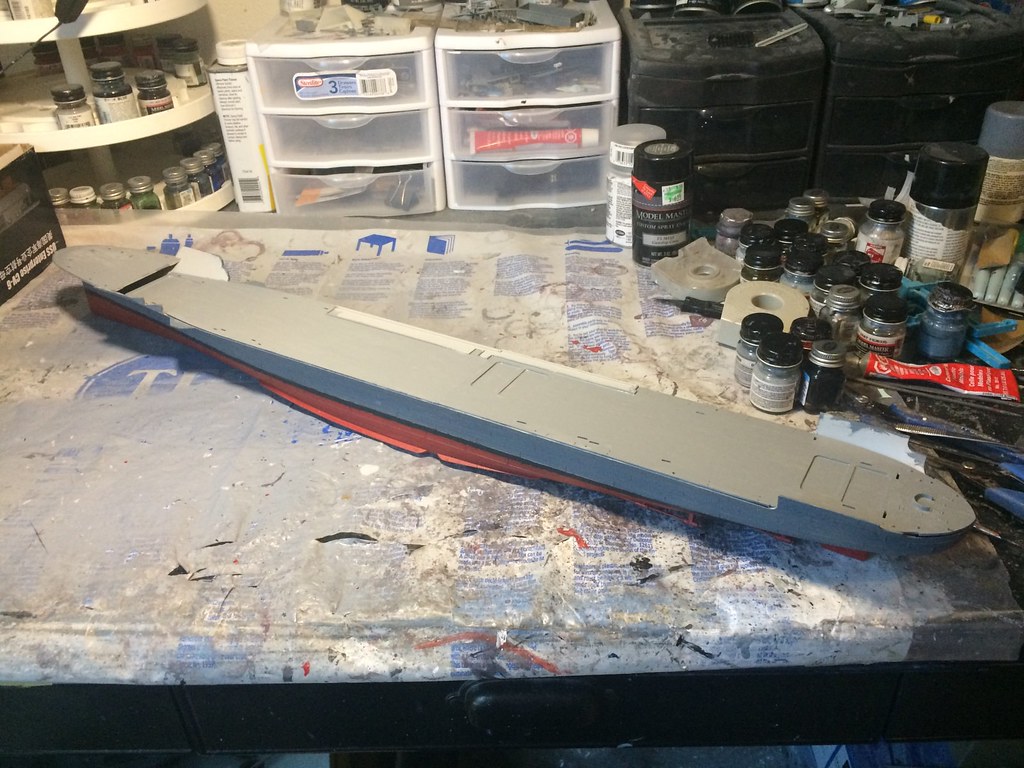
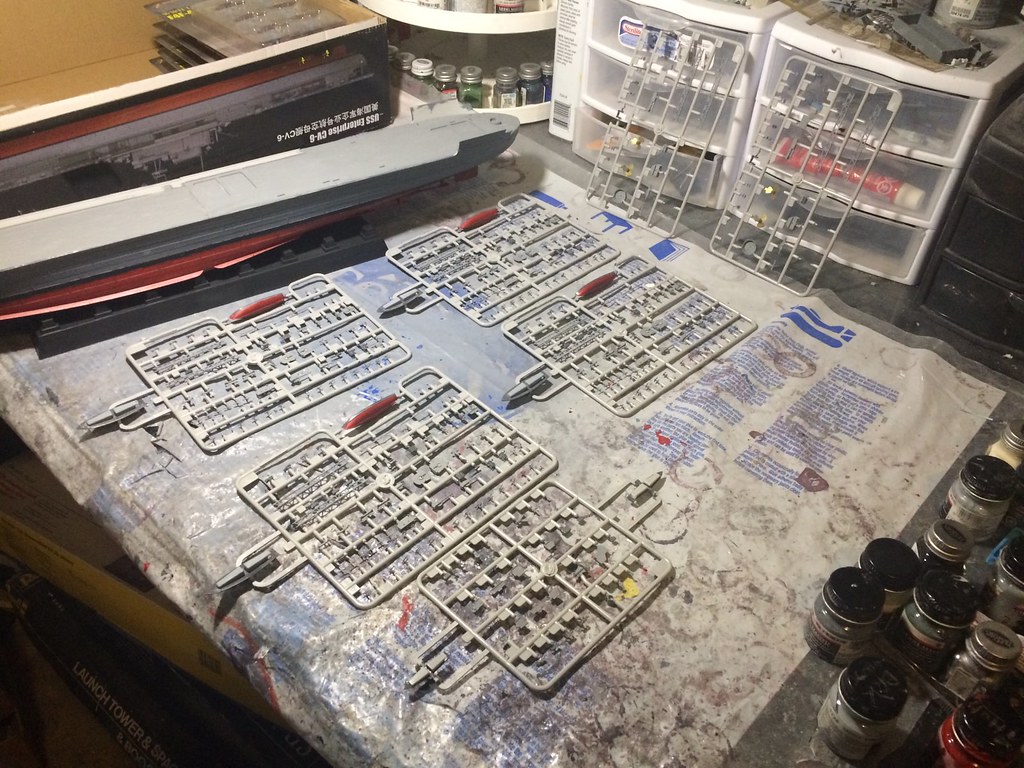
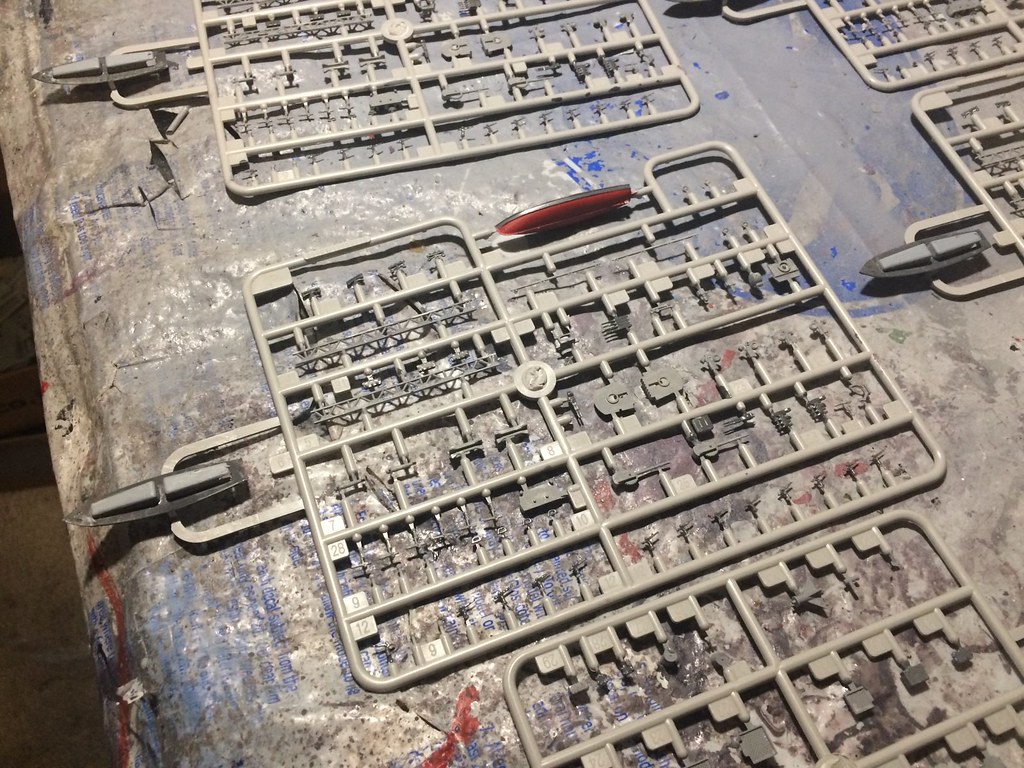
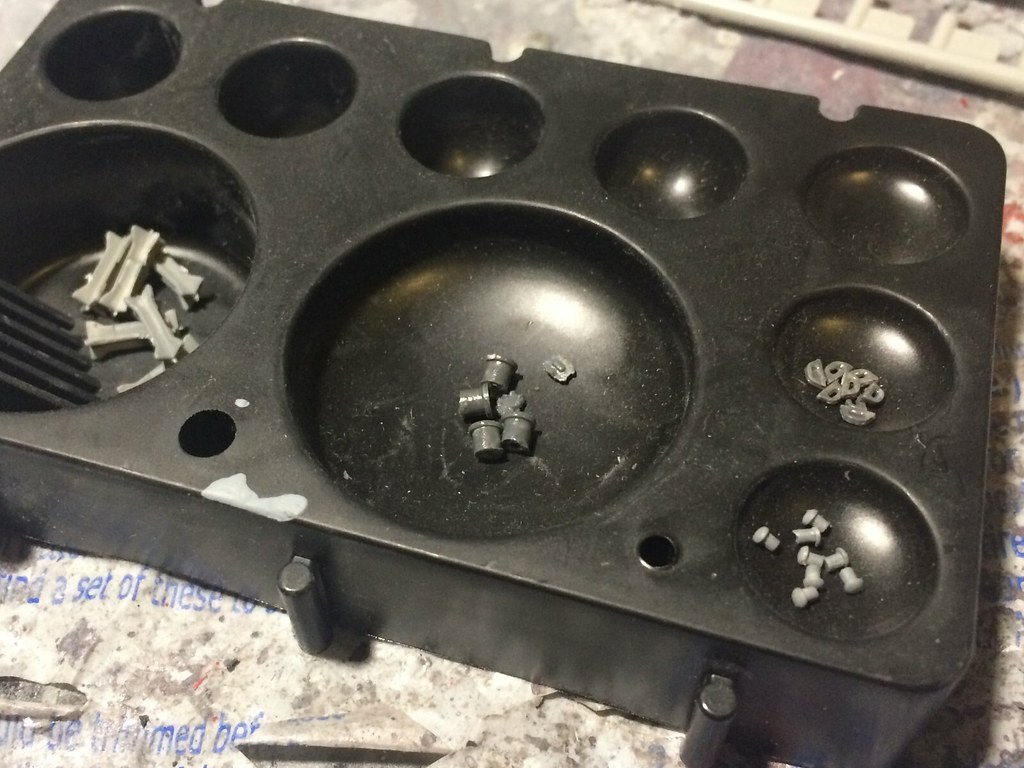
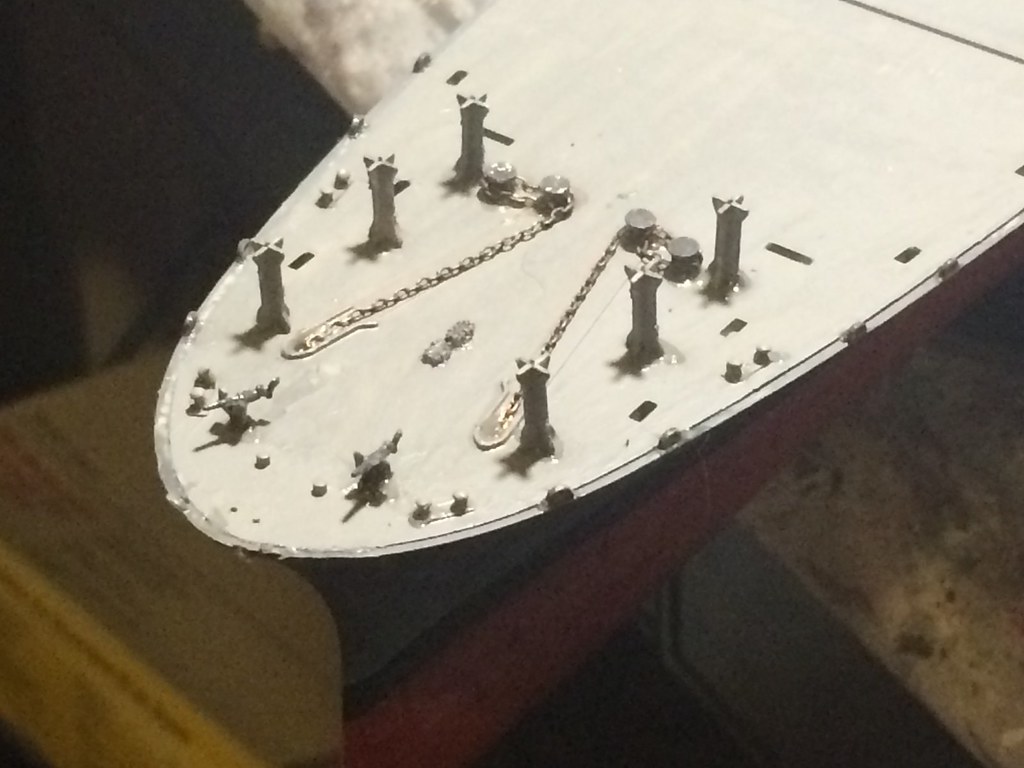
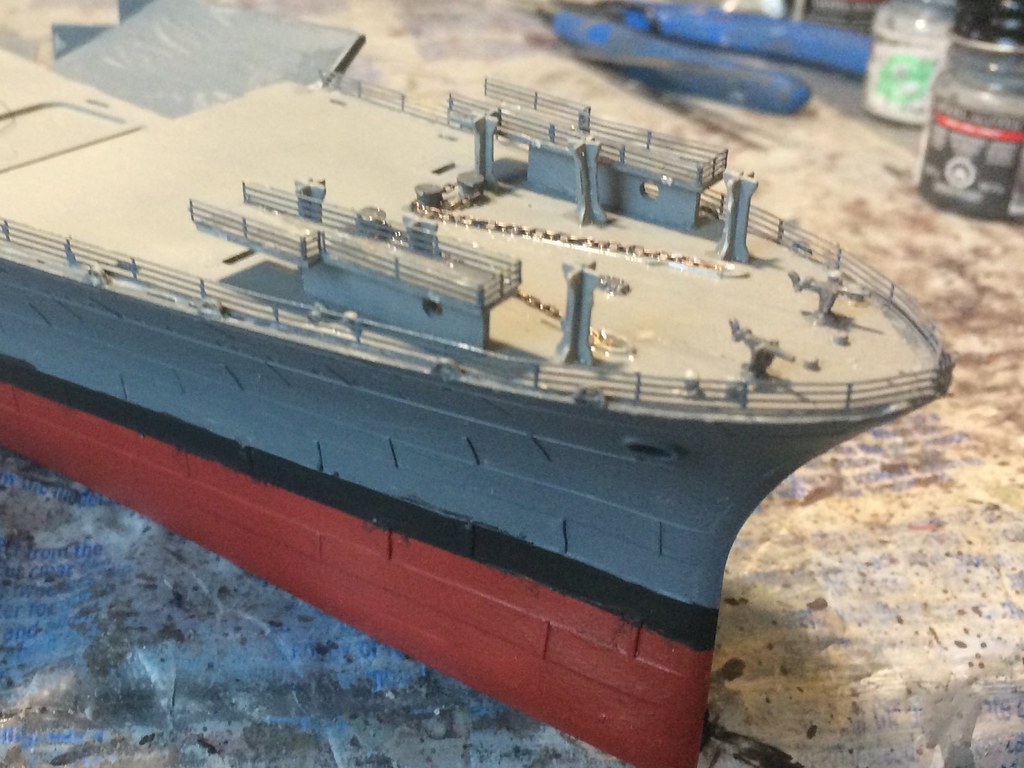

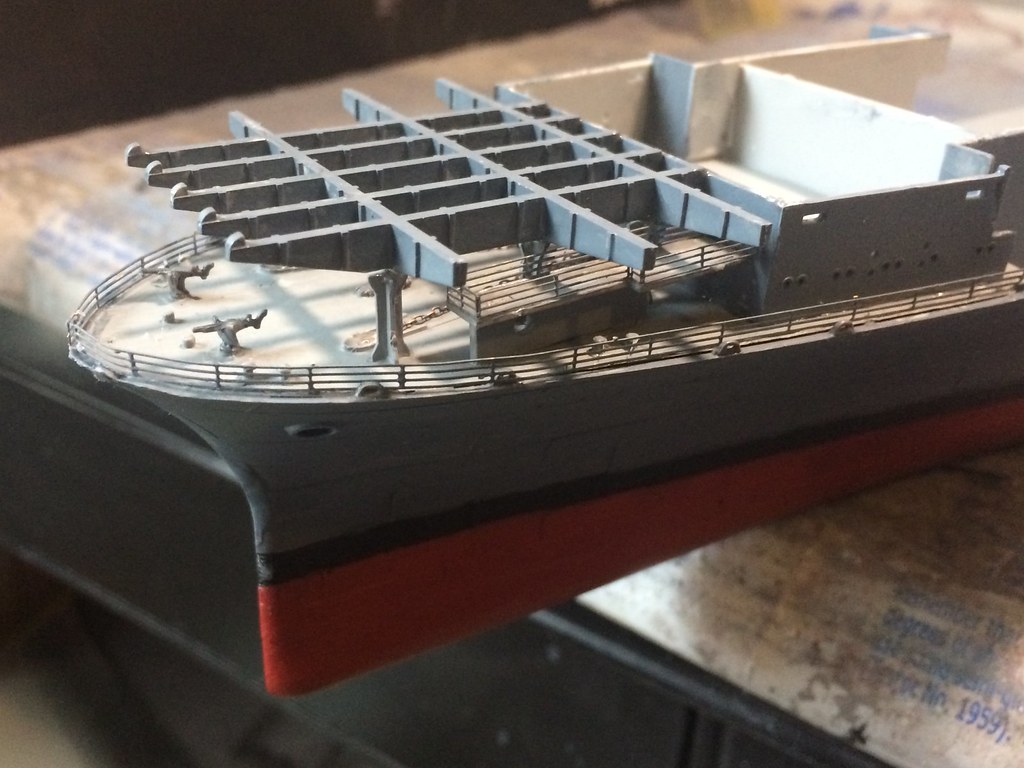
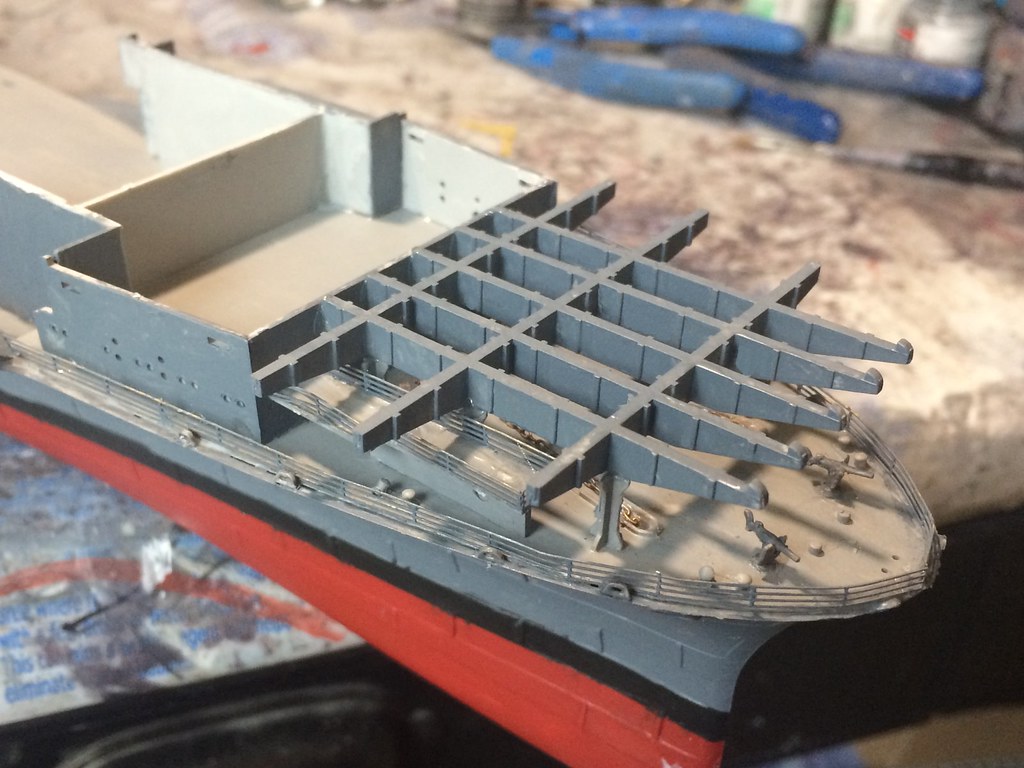
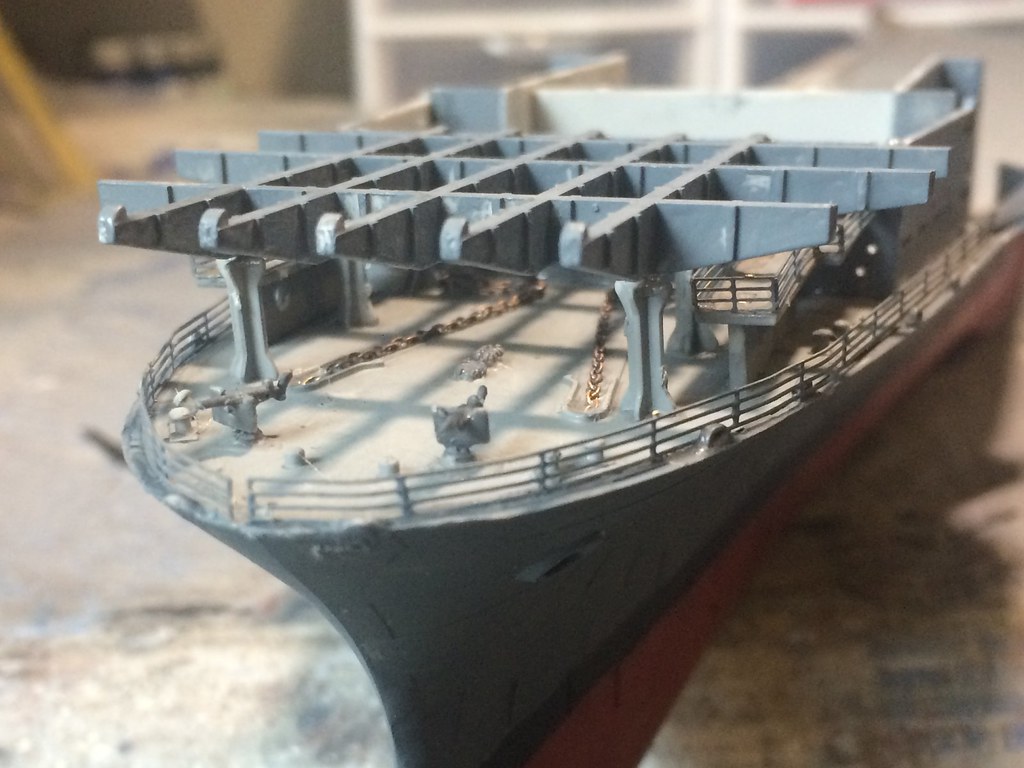

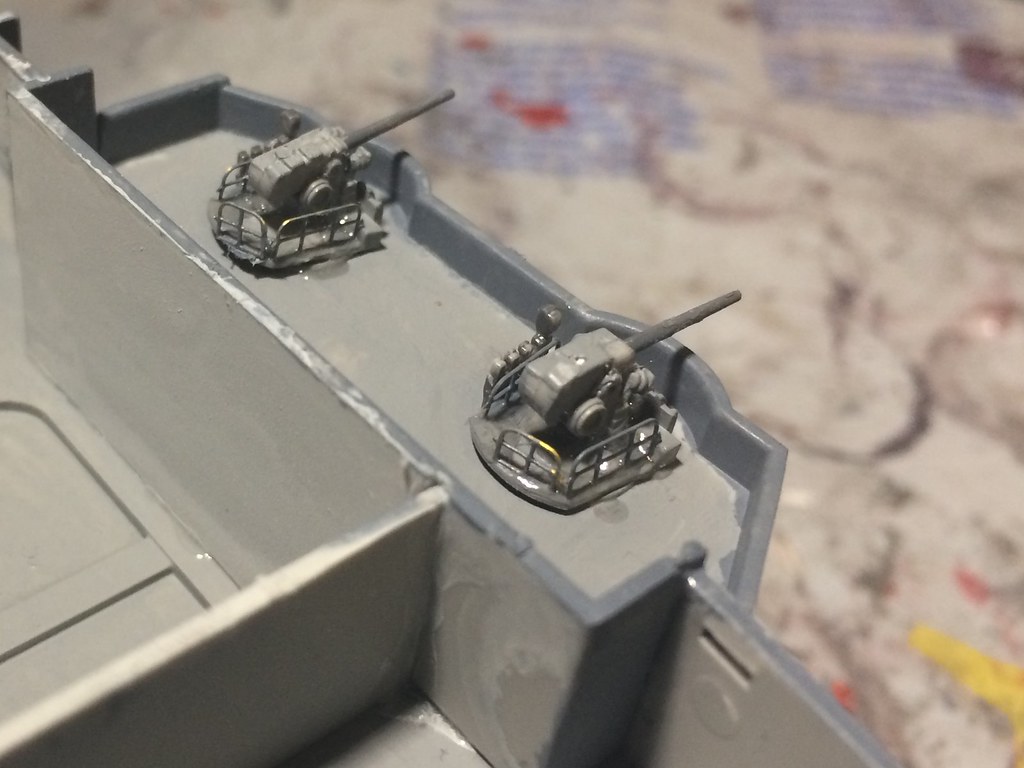
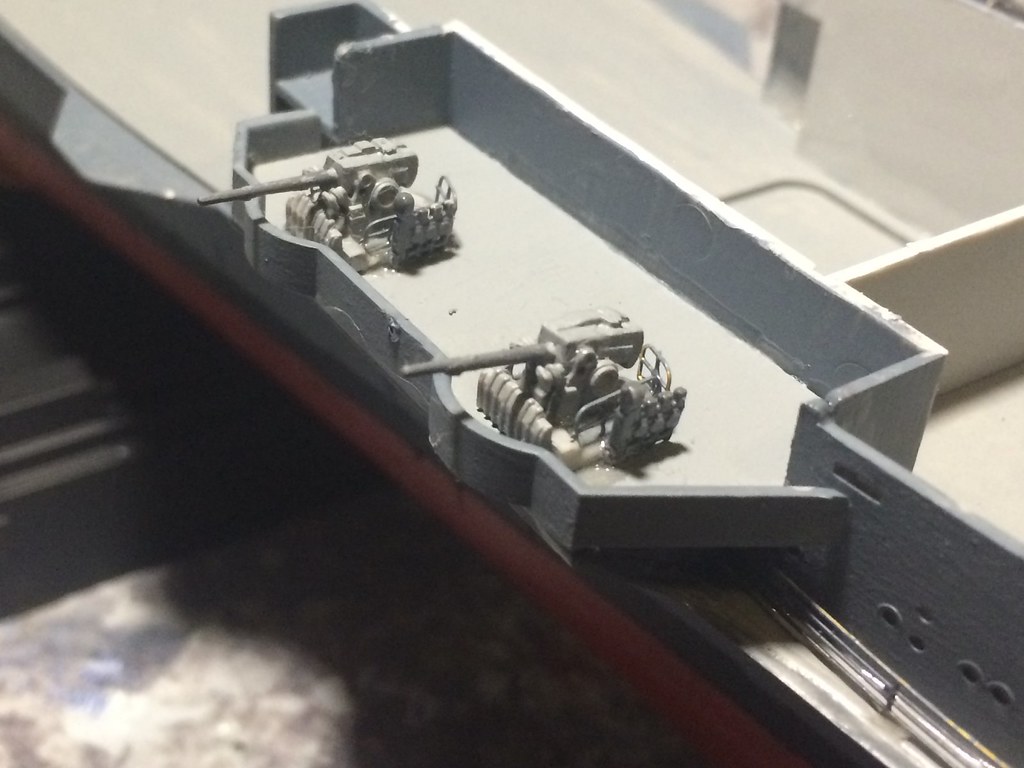
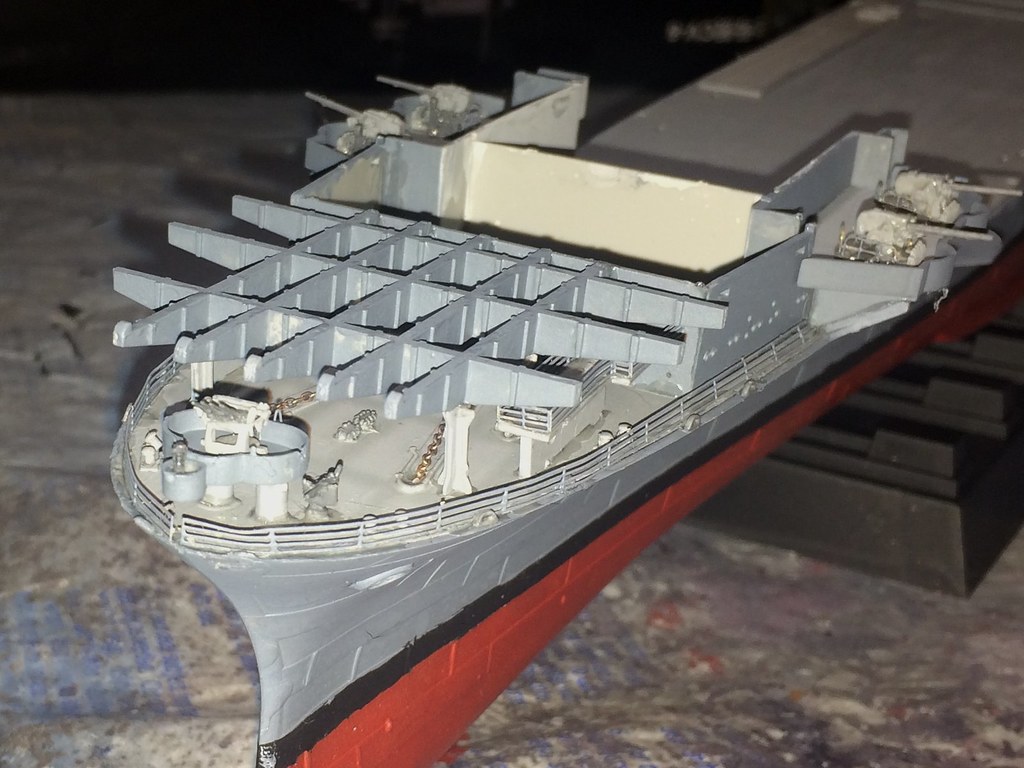
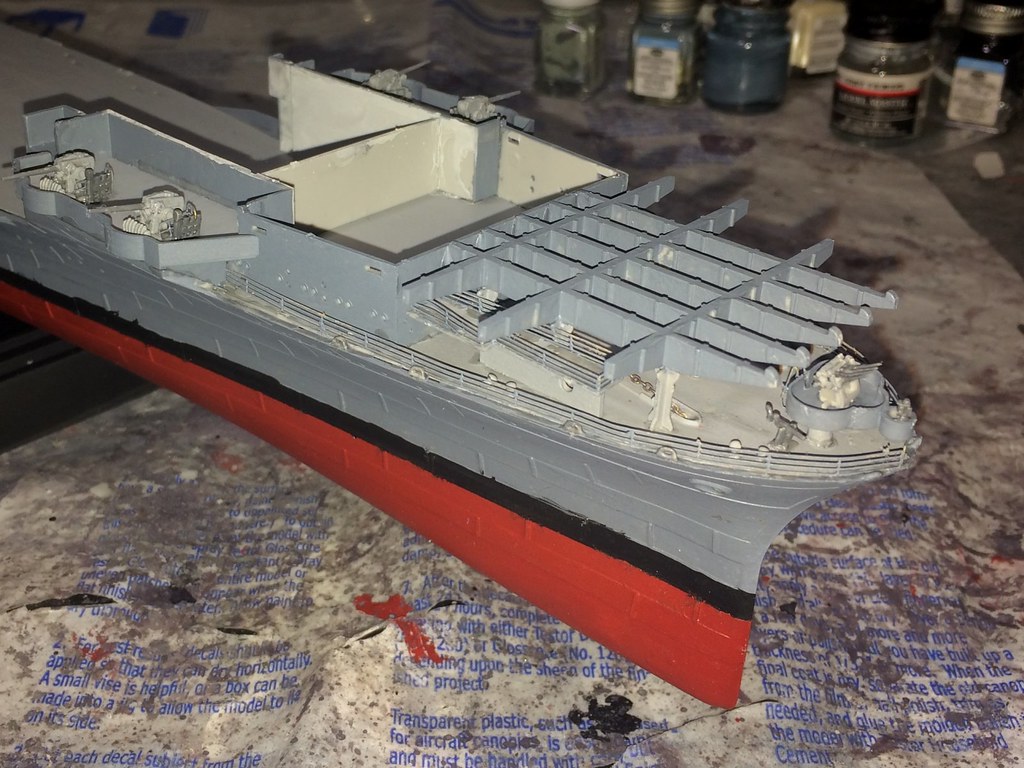
The Build - Stern assembly - April 16, 2017, 2017
The bow of this vessel has a lot going on. A lot of parts at the bow, but Once I completed the bow, it was time to do the same thing for the stern of the ship.
Here's how that went:
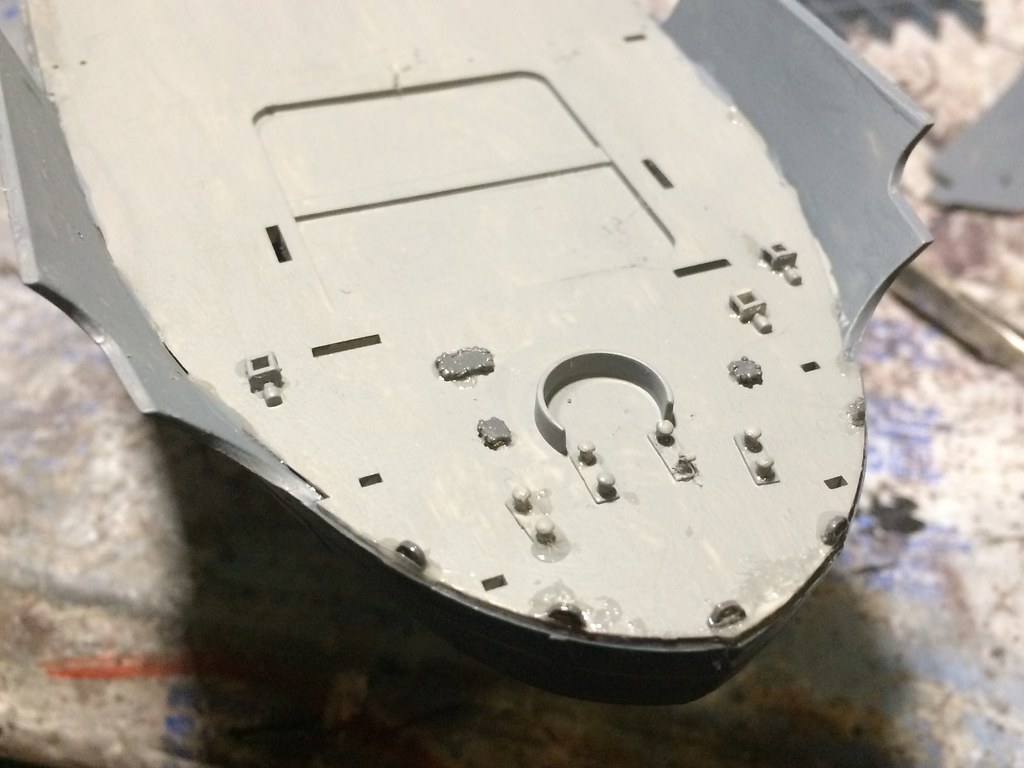

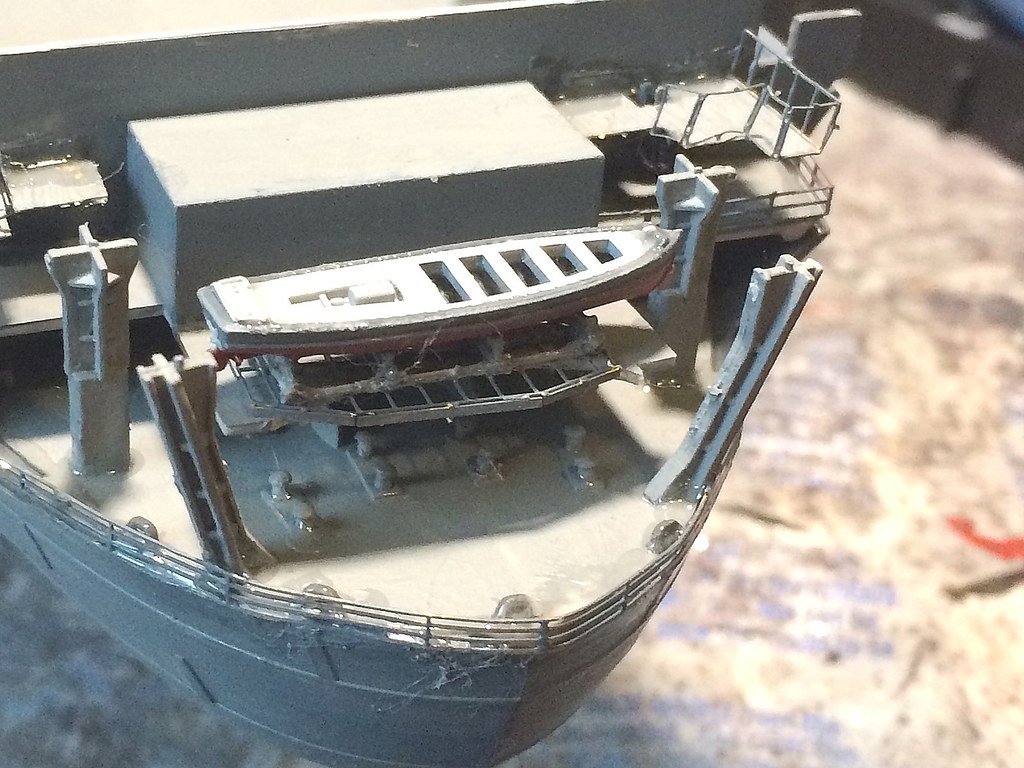

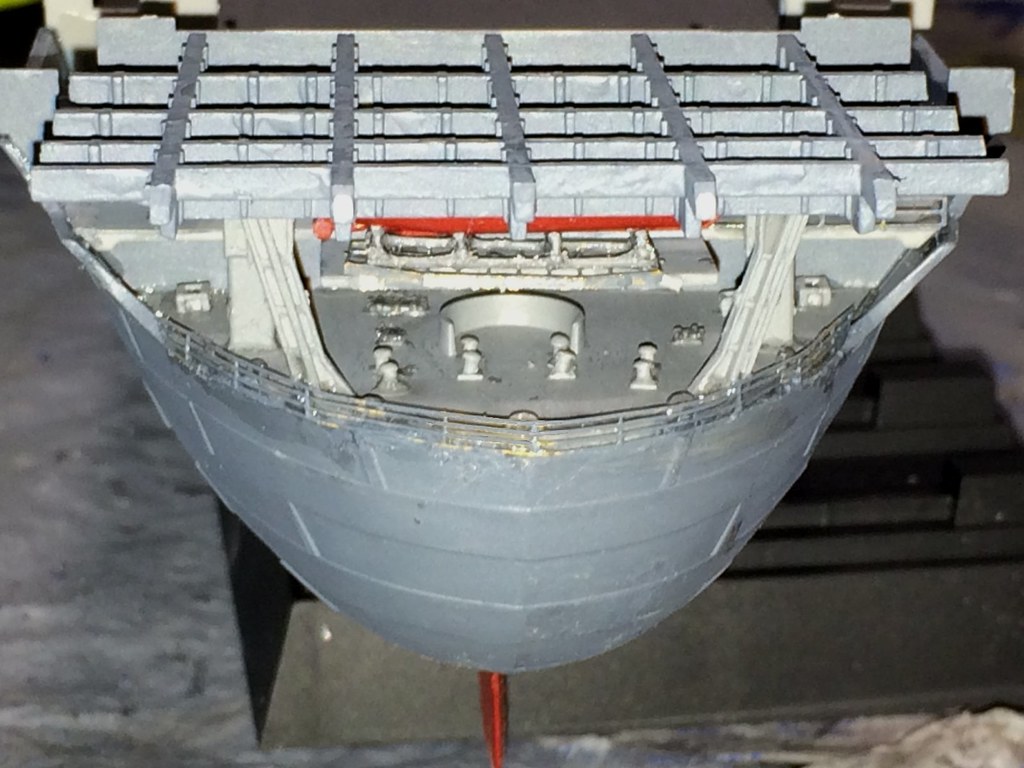
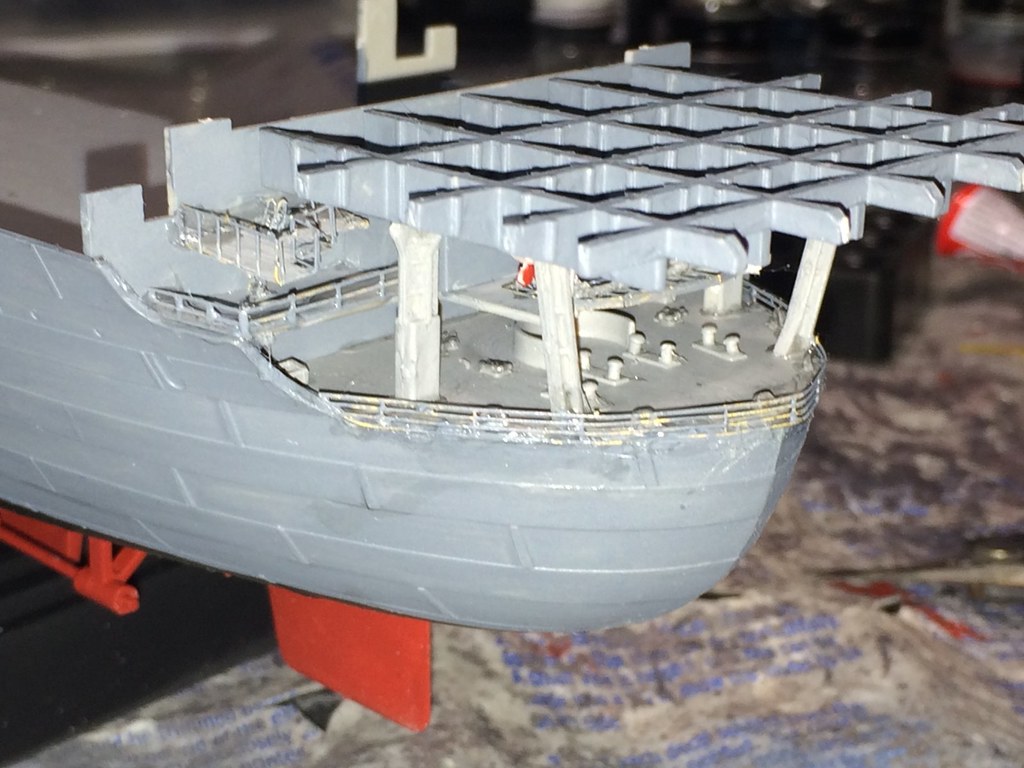
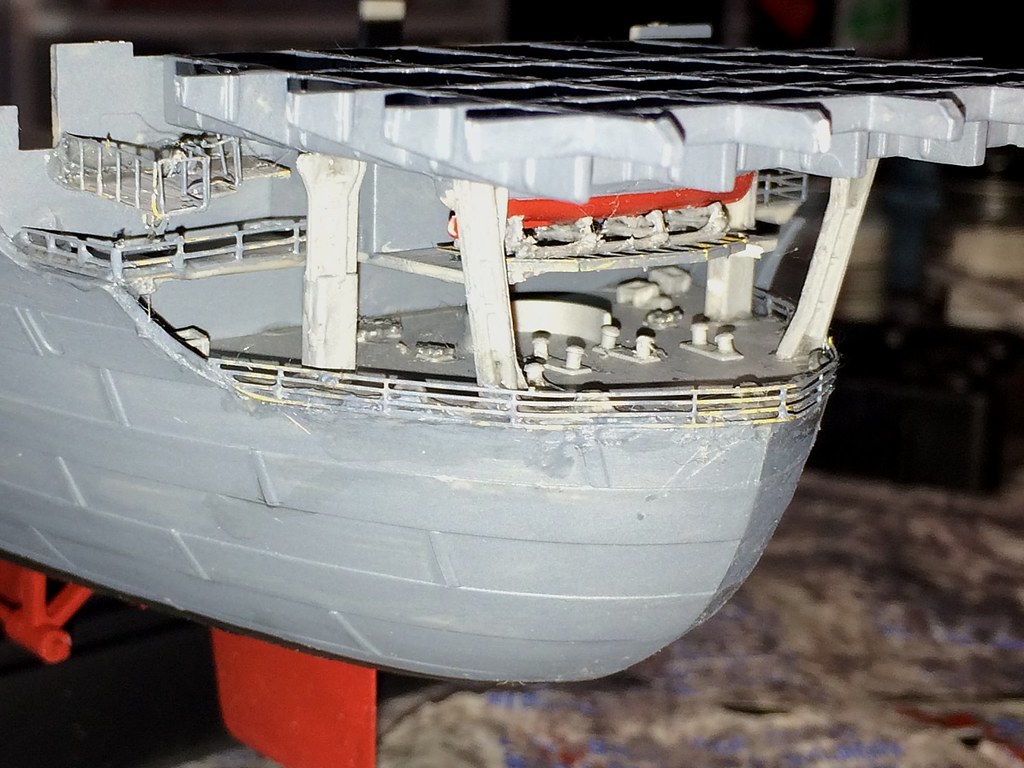
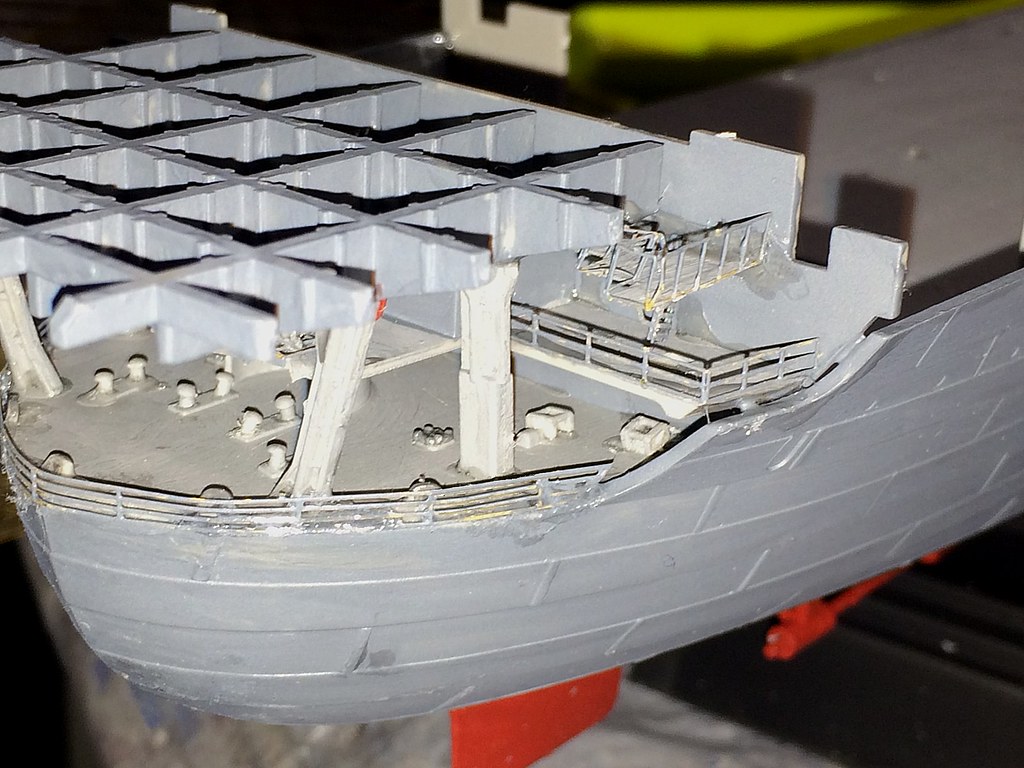
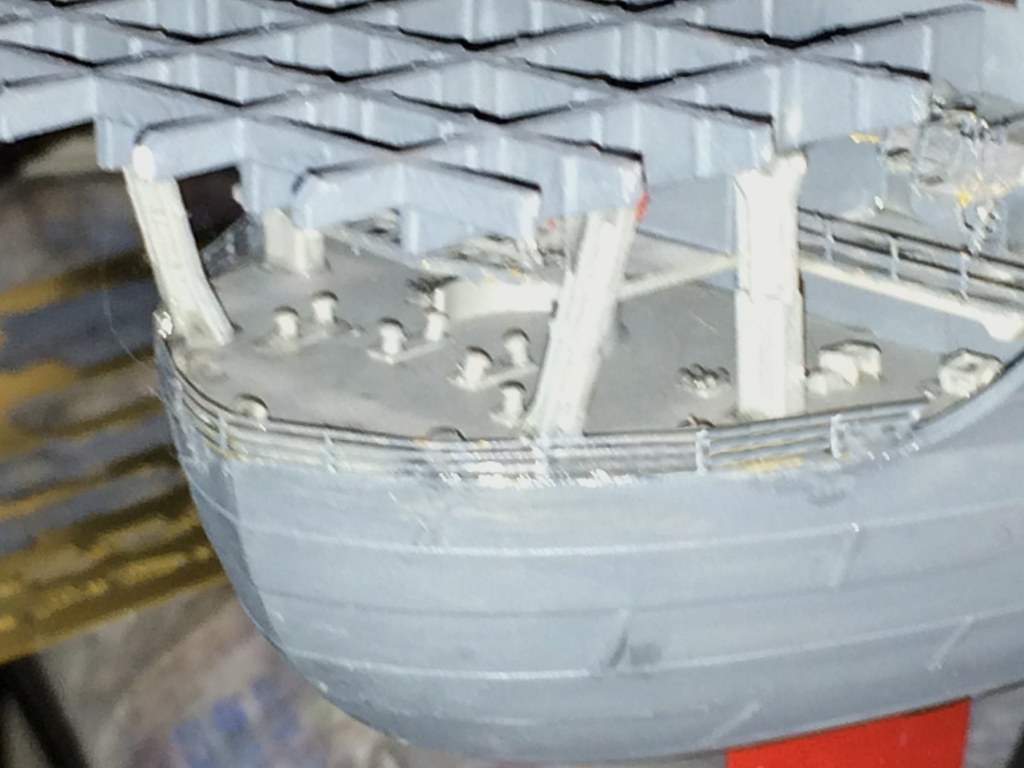
So here' how both ends looked:
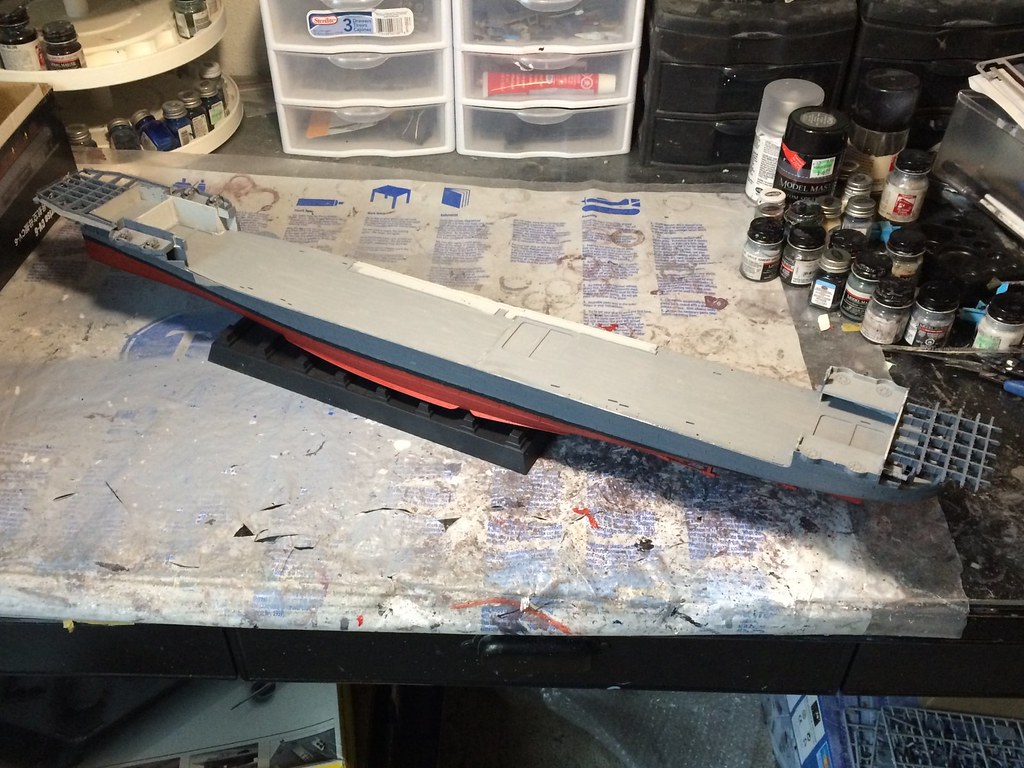
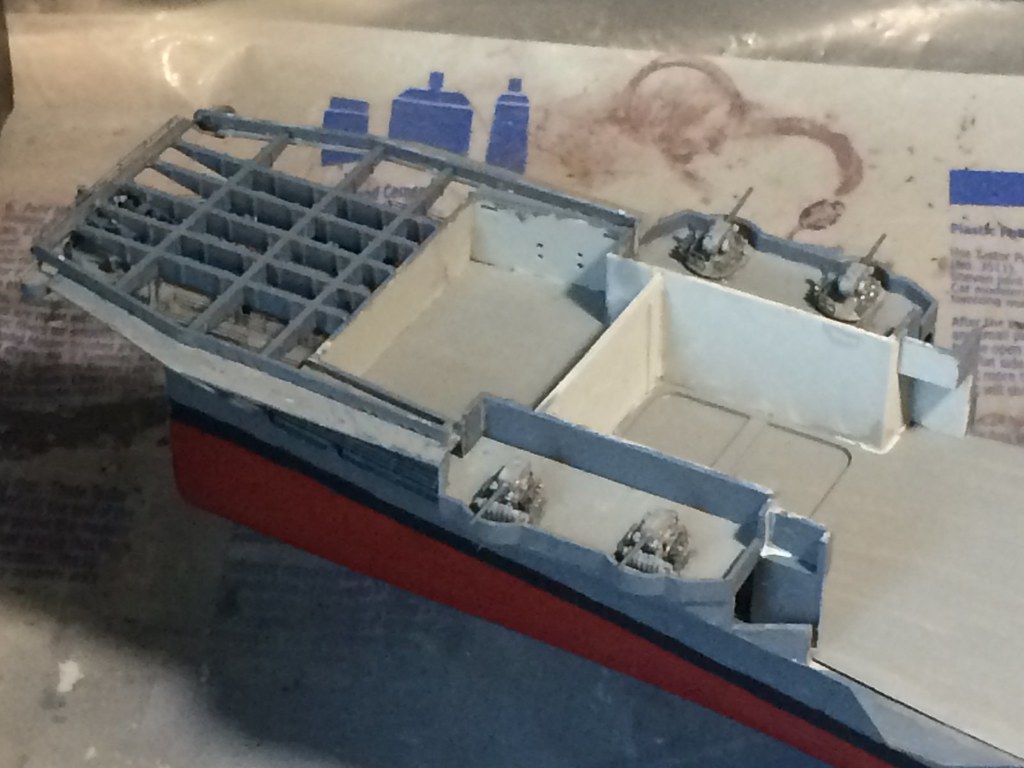
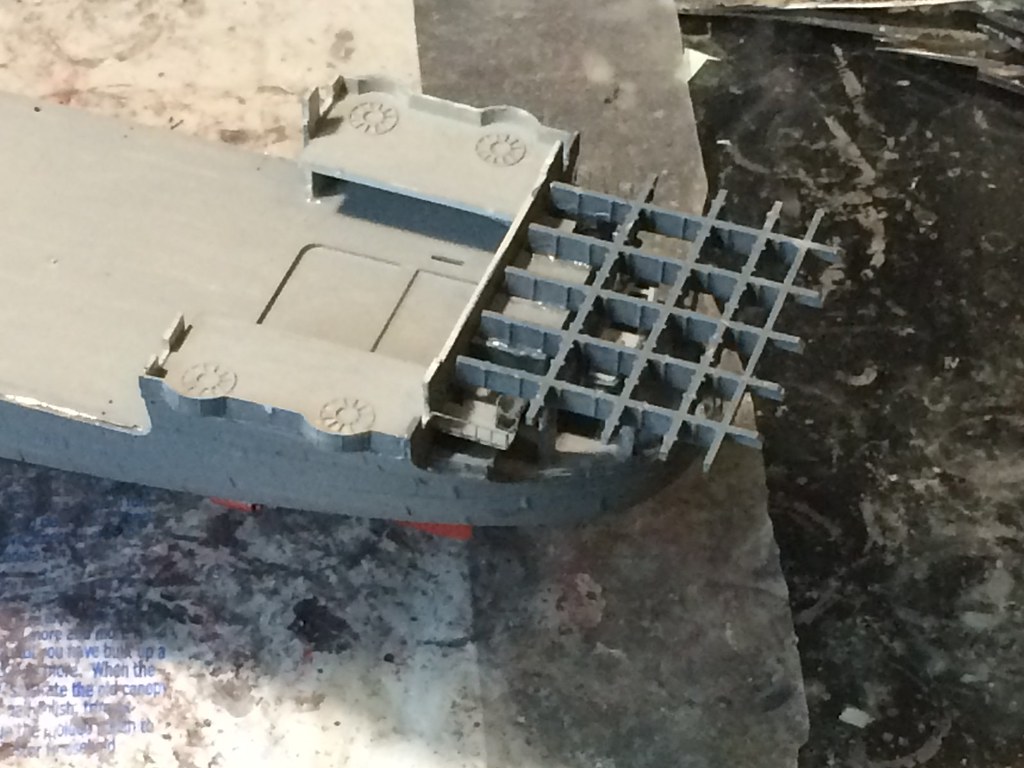


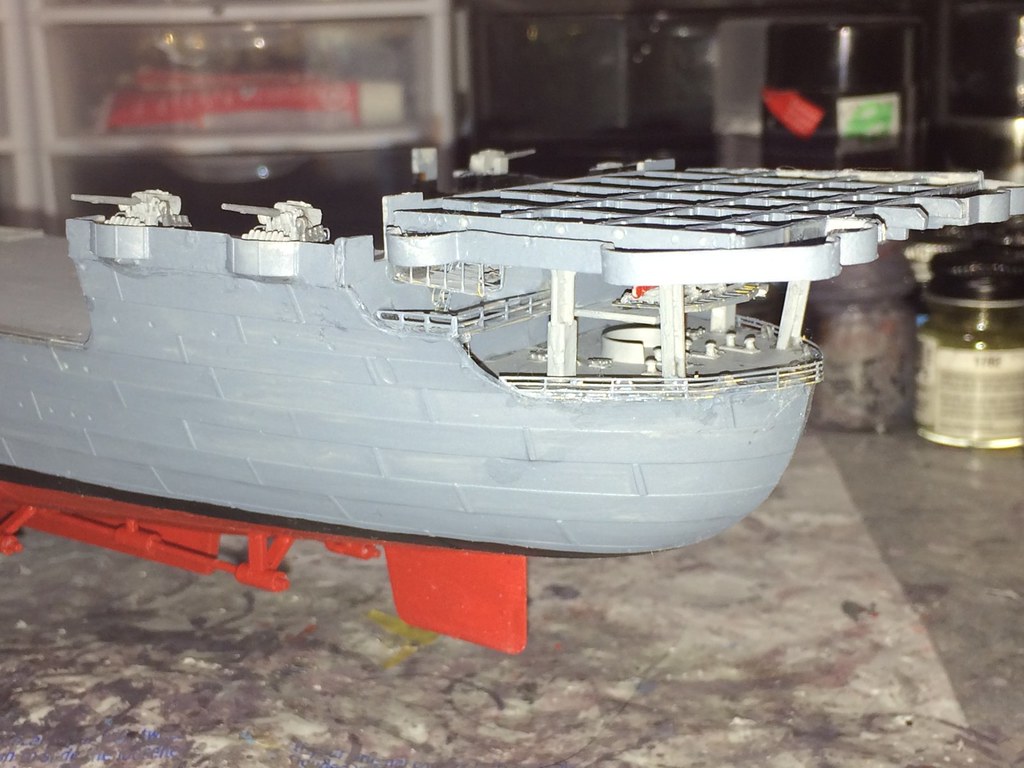
The bow and stern portions of the vessel are looking very nice at this point.
The Build - Hanger Deck main assembly - April 20, 2017, 2017
he hanger deck is a fairly large build, involving putting together the detaild inner walls for the hanger and the outer walls for the outside of the ship below the flight deck.
I put together the various wall assemblies on each the, the port and starboard, and then added them to the hanger deck level. I then added some of the detail on both the outside of the vessel, and inside in the hanger deck itself. I painted the hanger deck itself a nuetral gray, and painted the vetical surfaces inside the hanger deck a light gray.
The vertical surfaces on the hull are all in the Modle Master dark grey I am using.
A lot of assembly required:
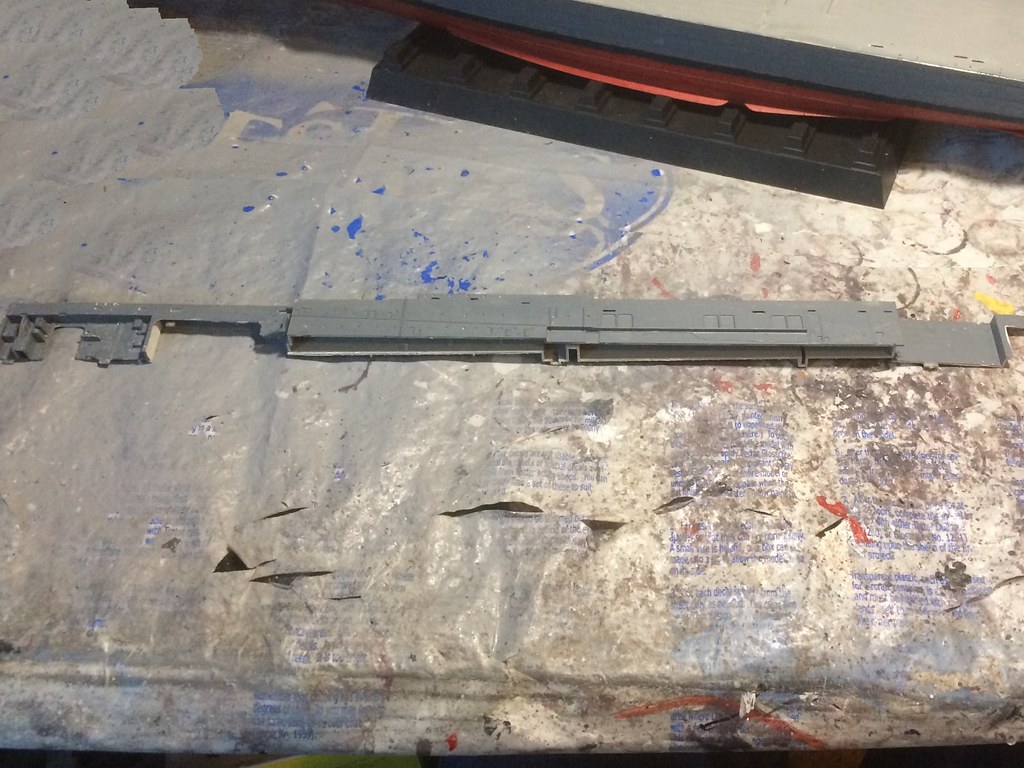

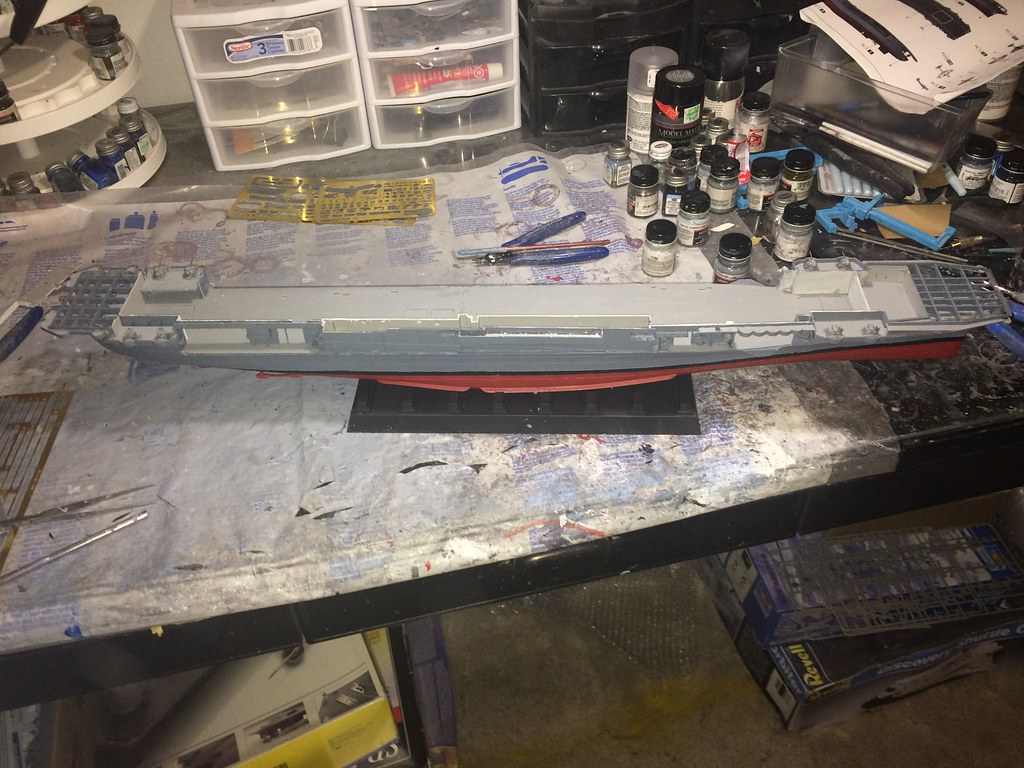
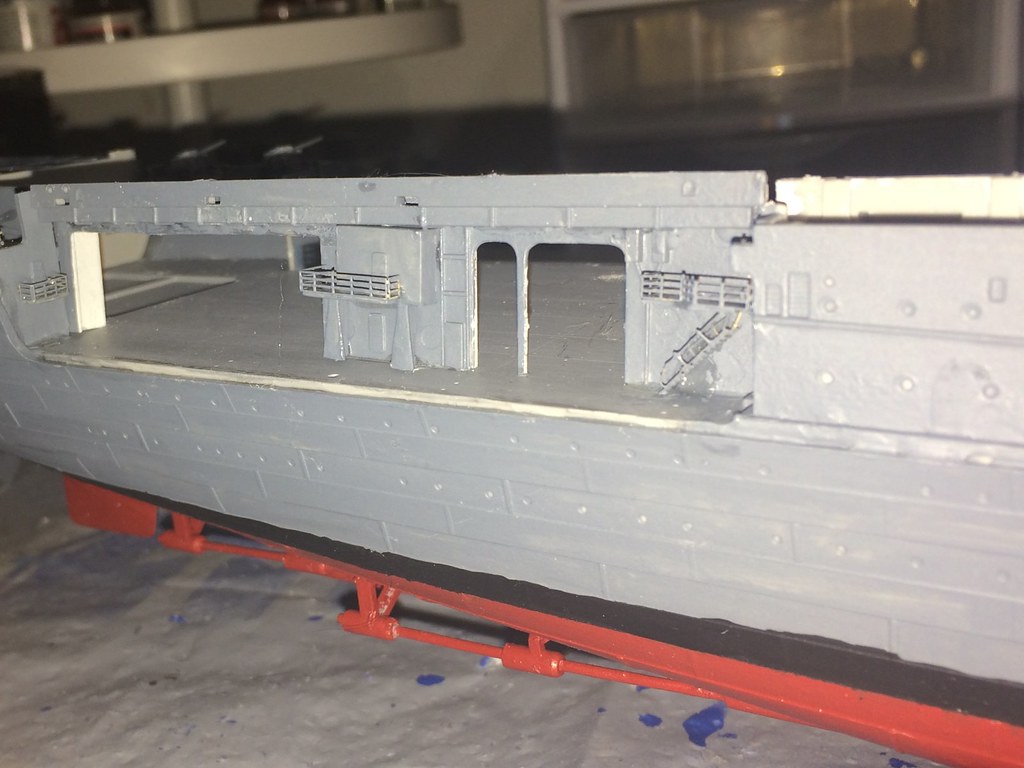
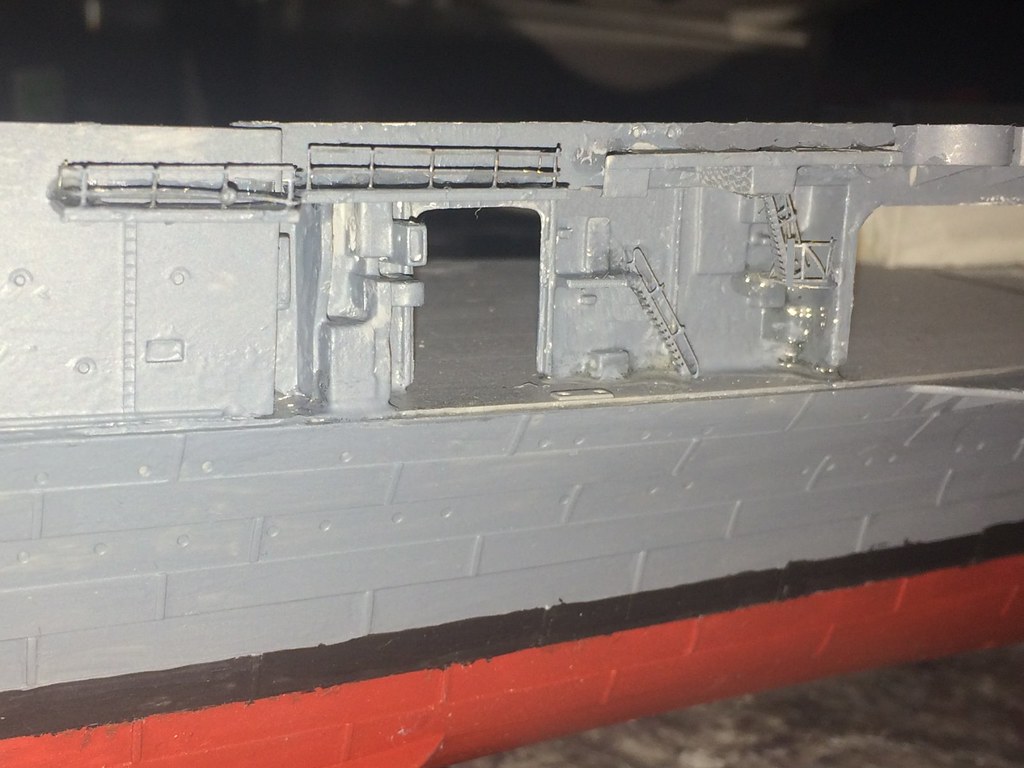
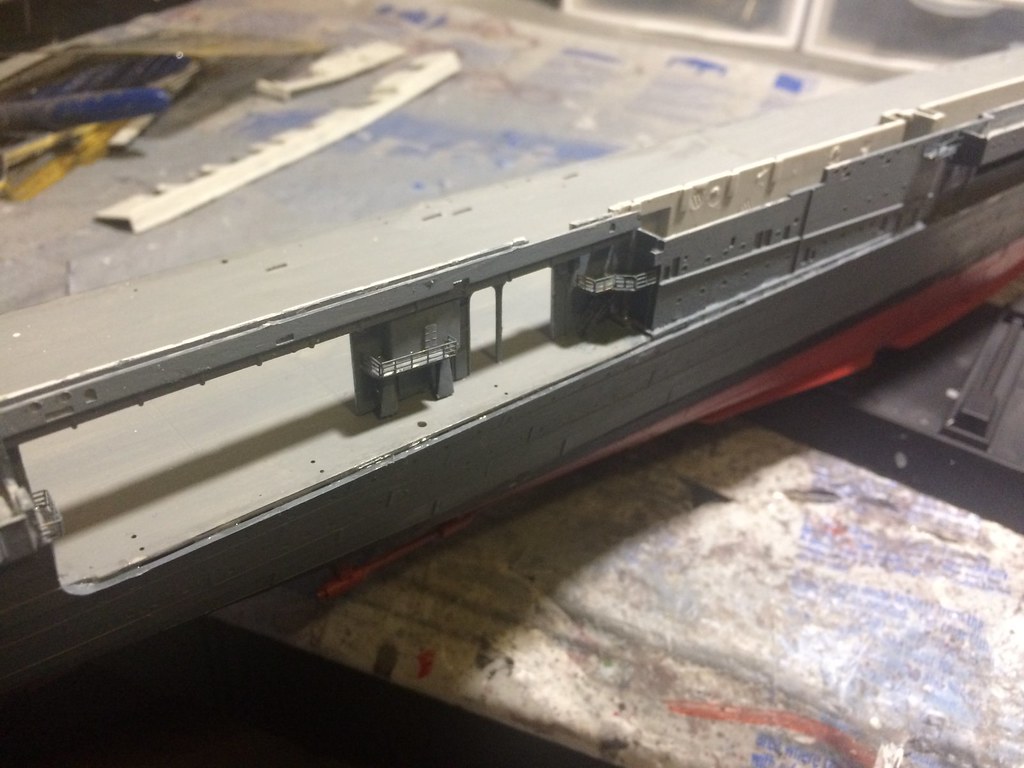
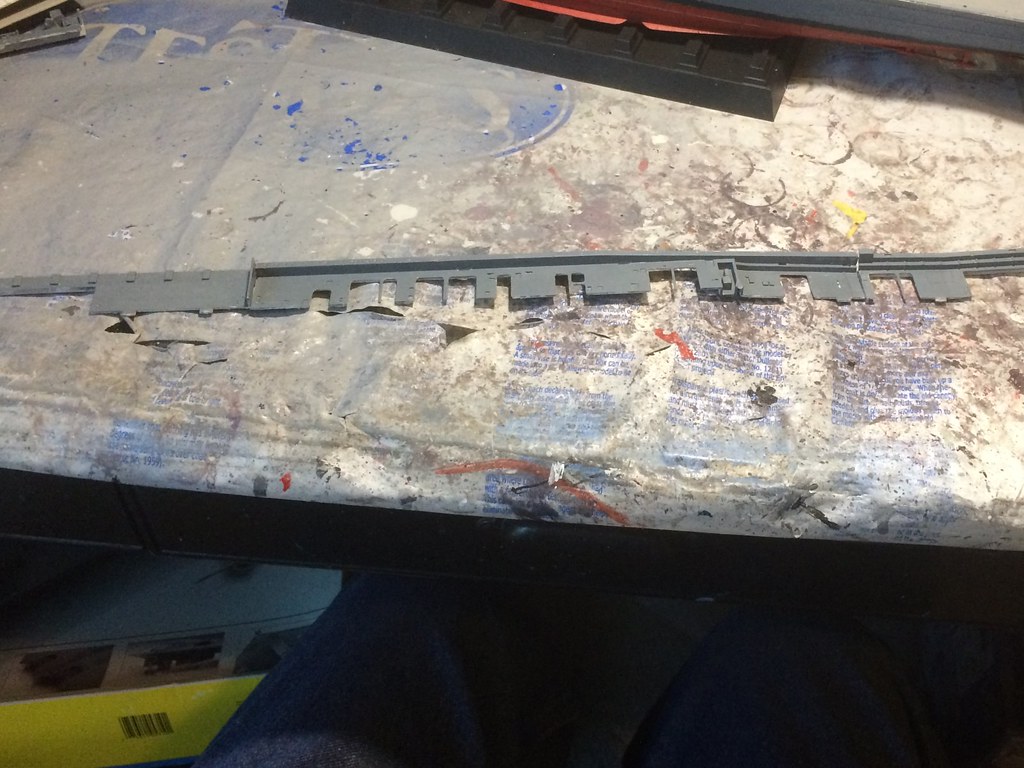
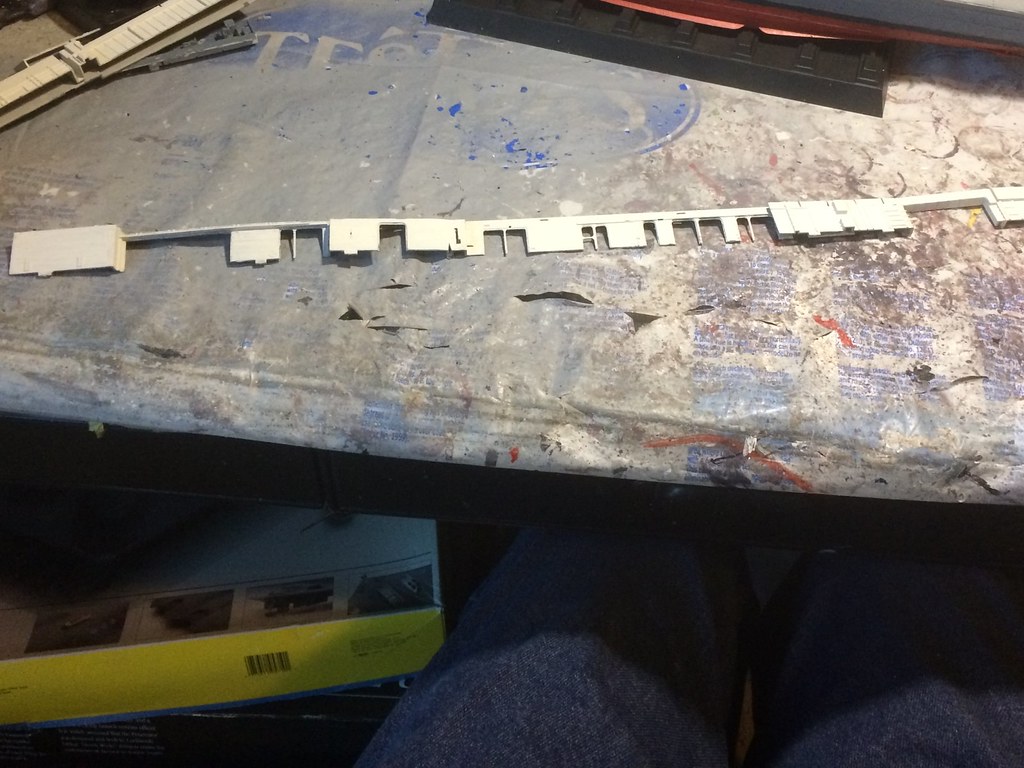
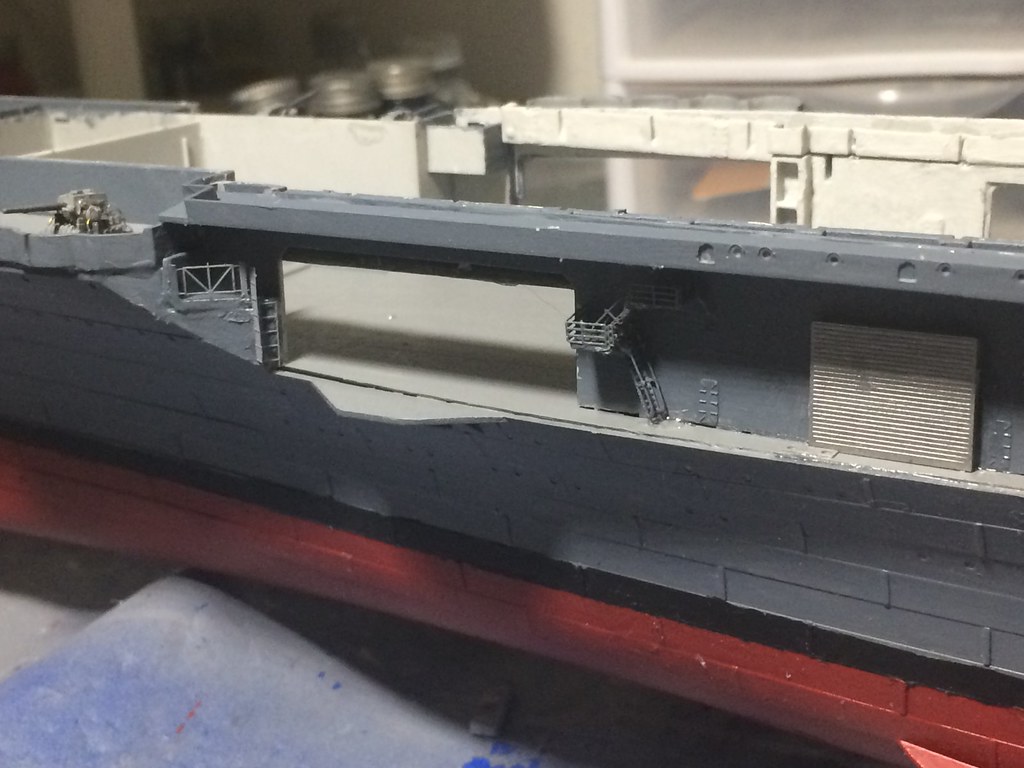
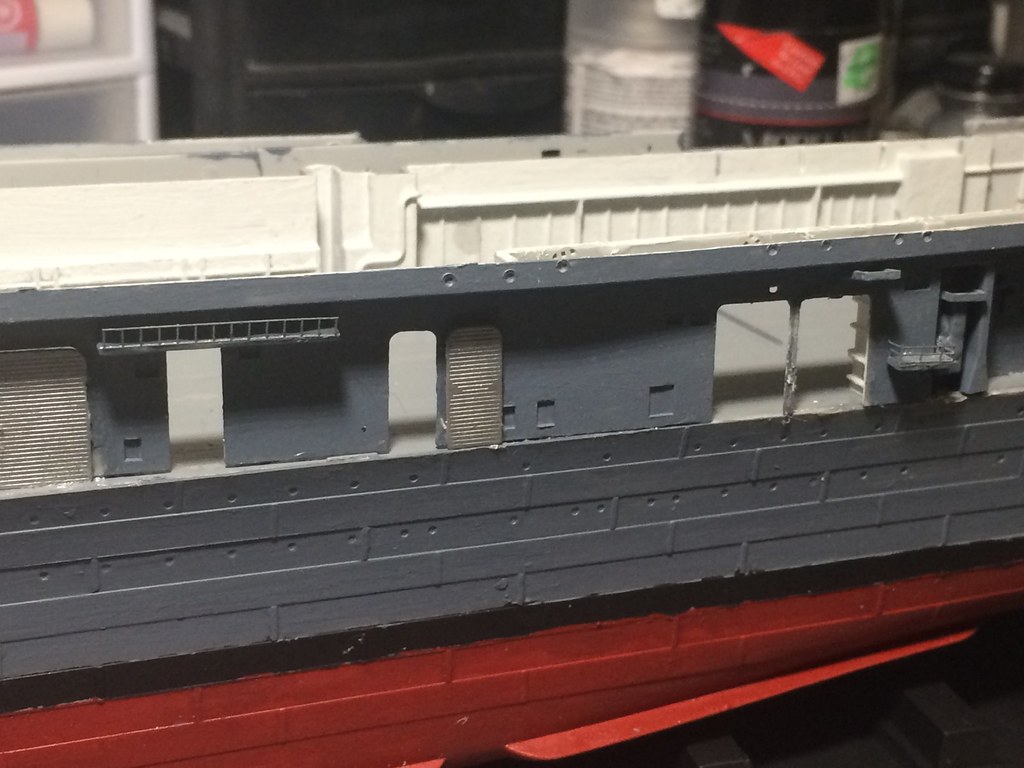
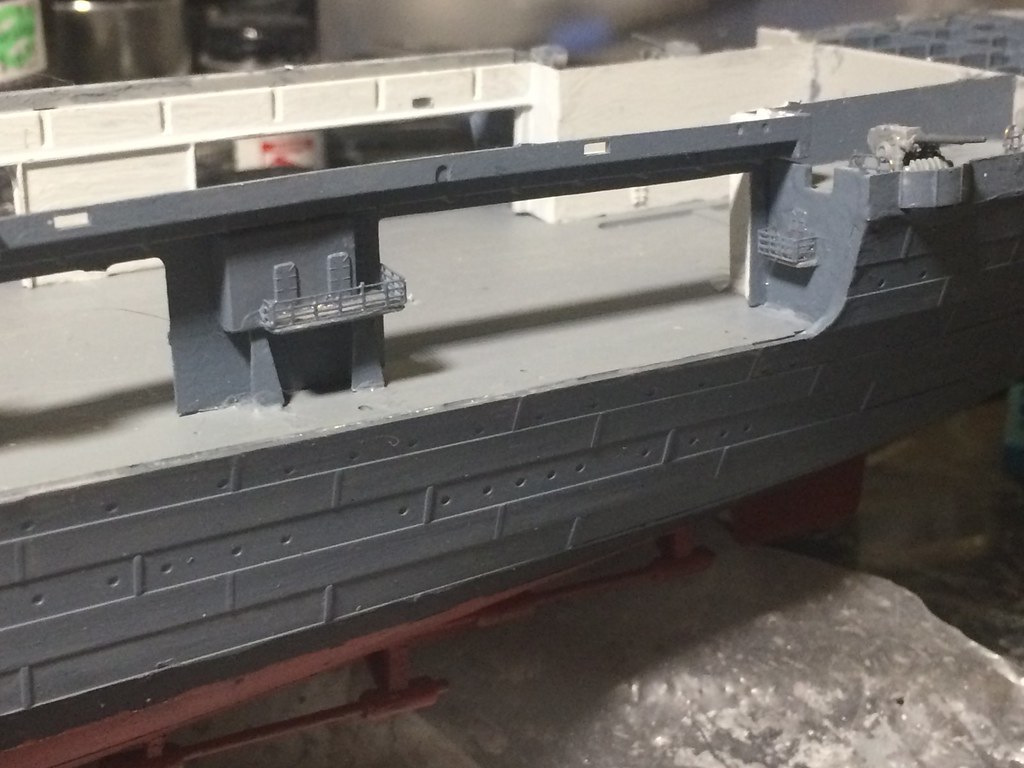
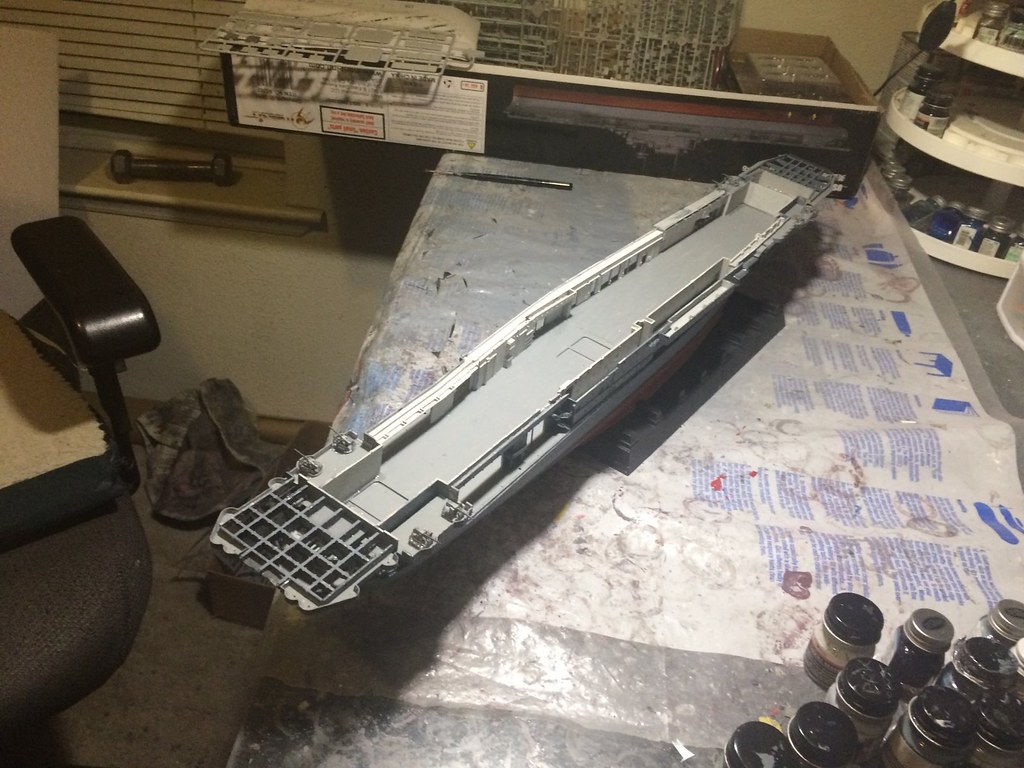
I then added some of the detai ecks, just below the flight deck, where a lot of the anti-aircraft weapons will be ;located:

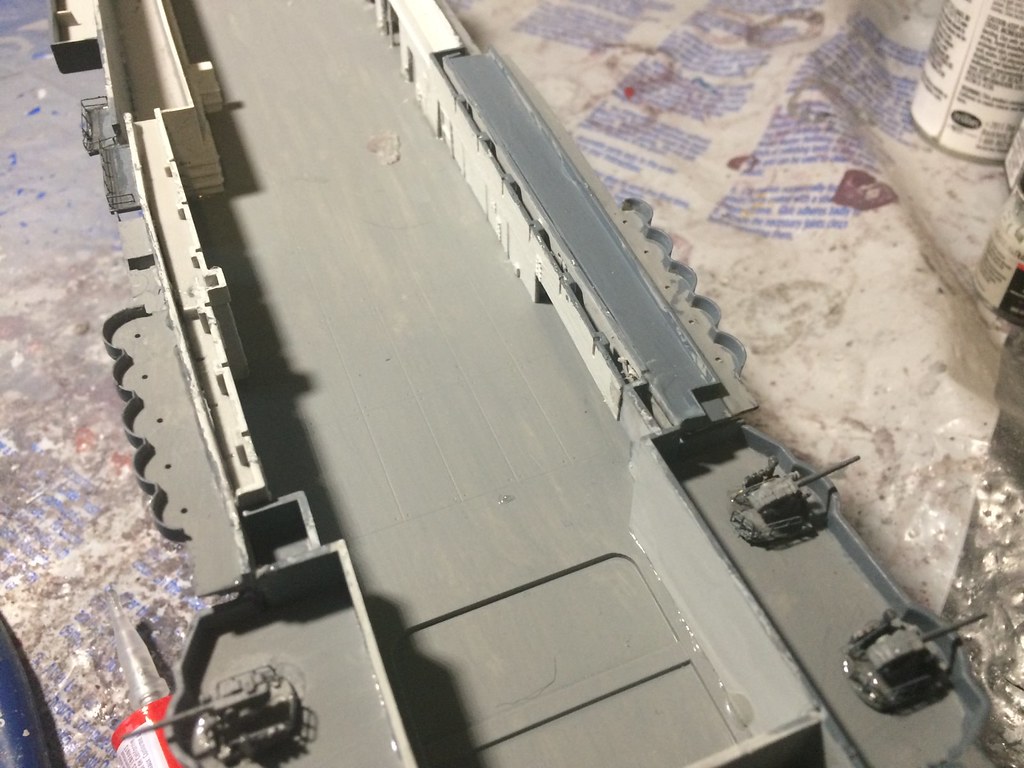
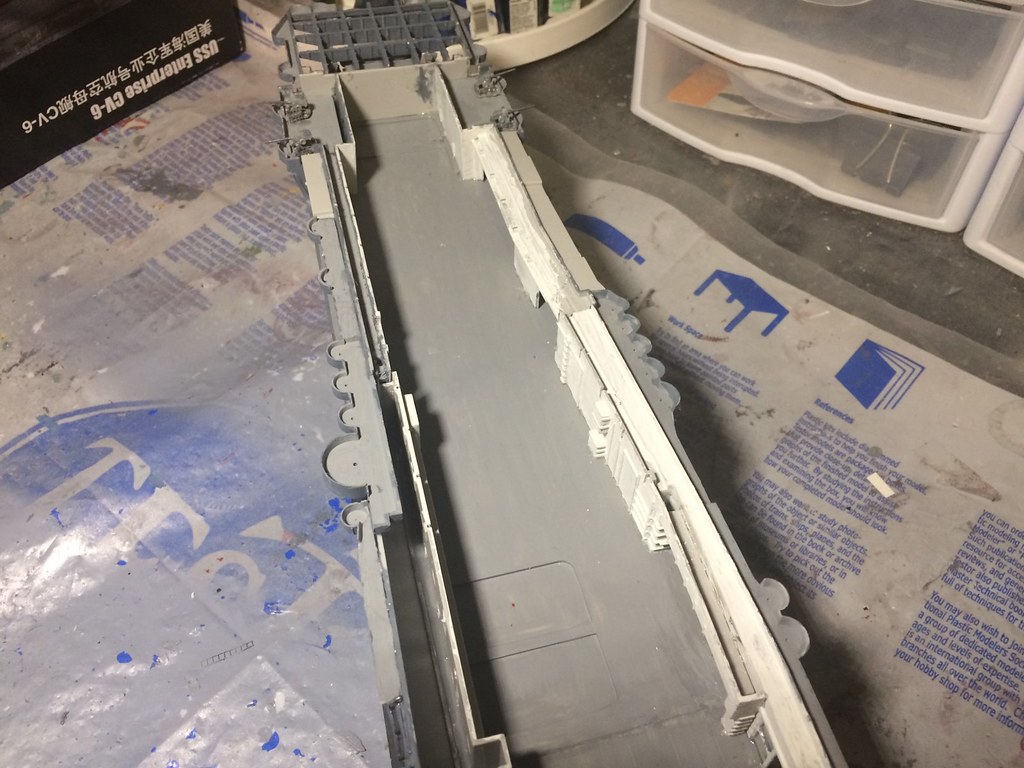
The Build - Detailing the inner Hanger Deck - April 22, 2017, 2017
At this point it was time to add the details to the hanger deck itself, including the part of the air wing I wanted to have inside the hanger.
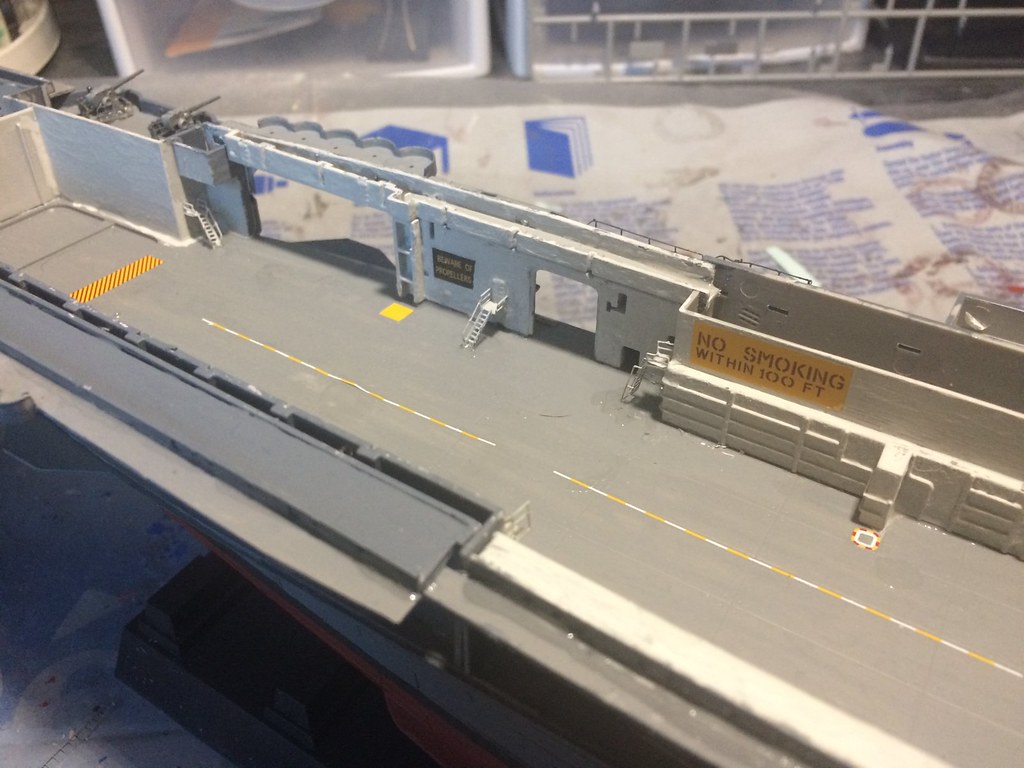
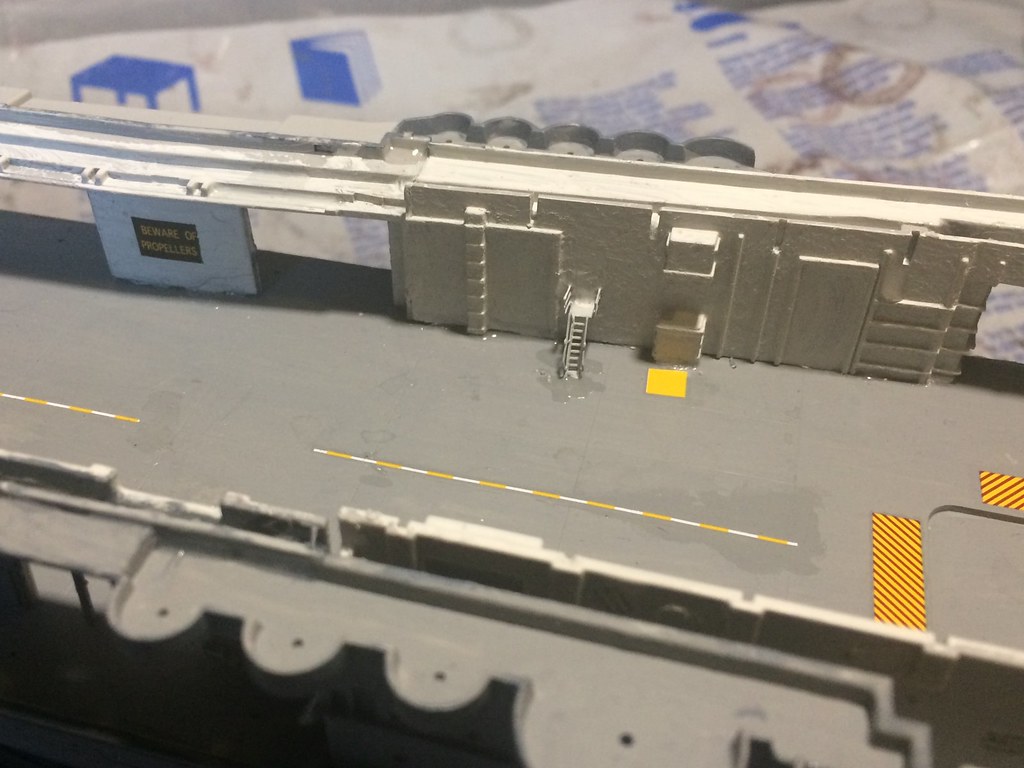
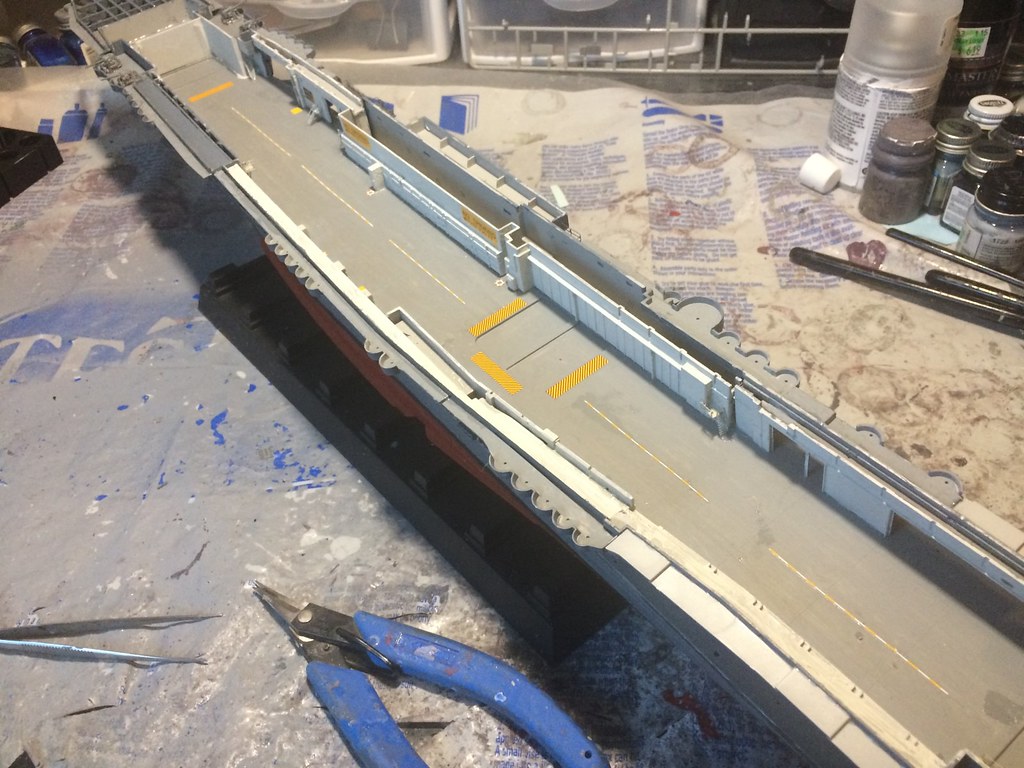
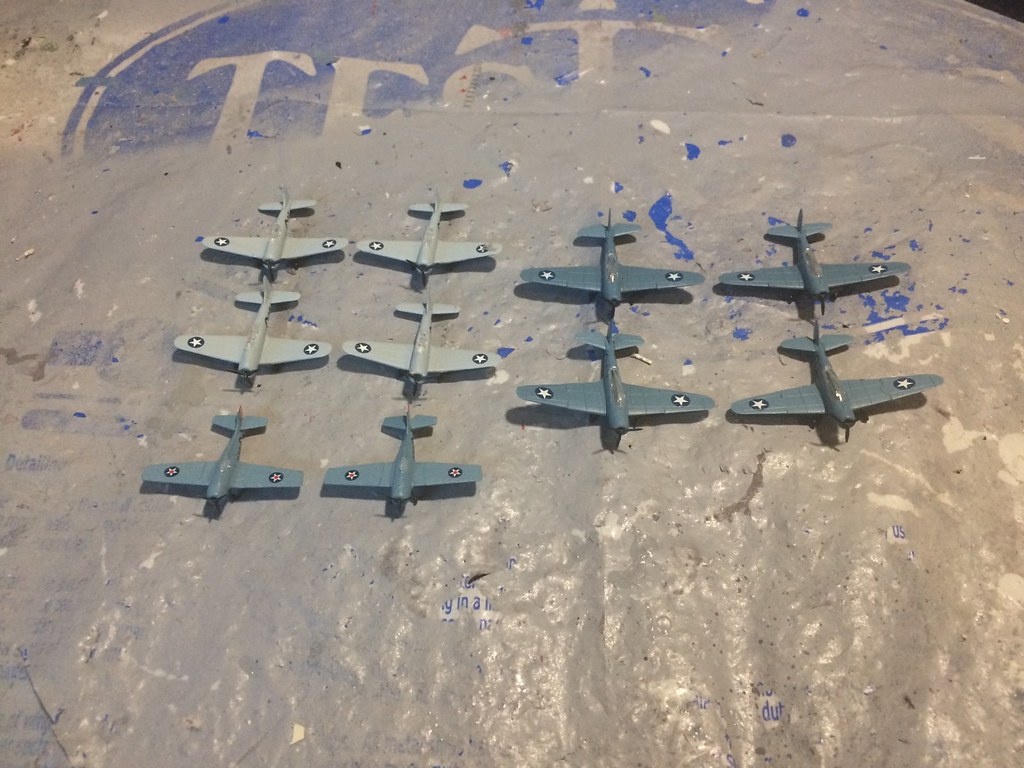
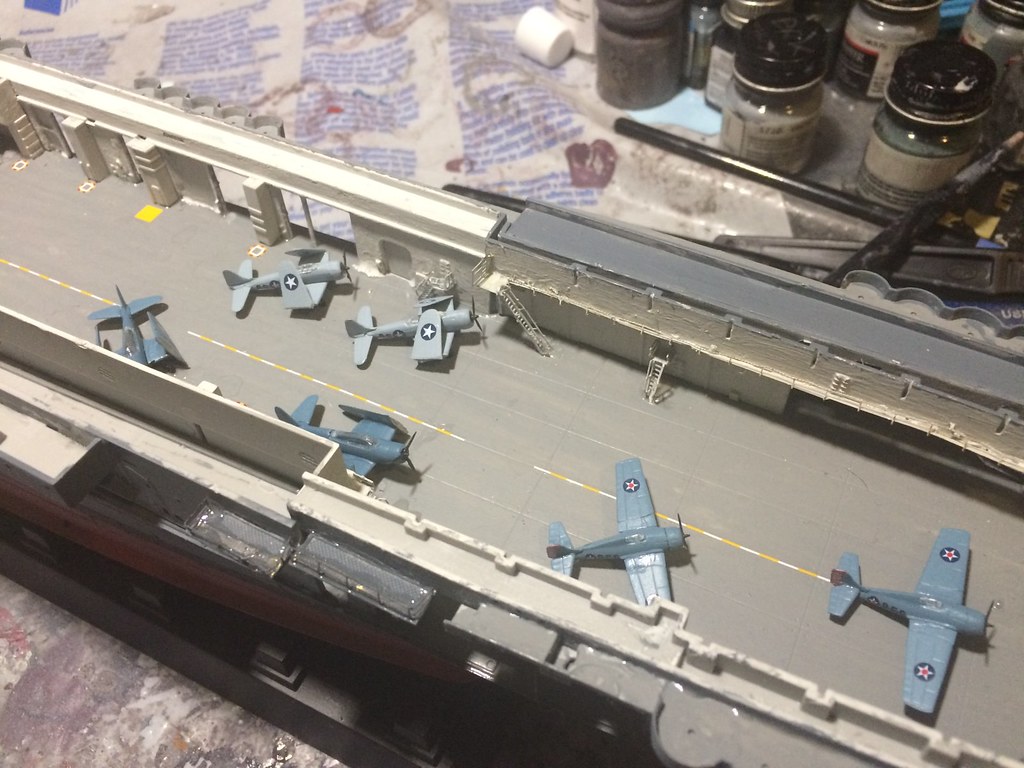
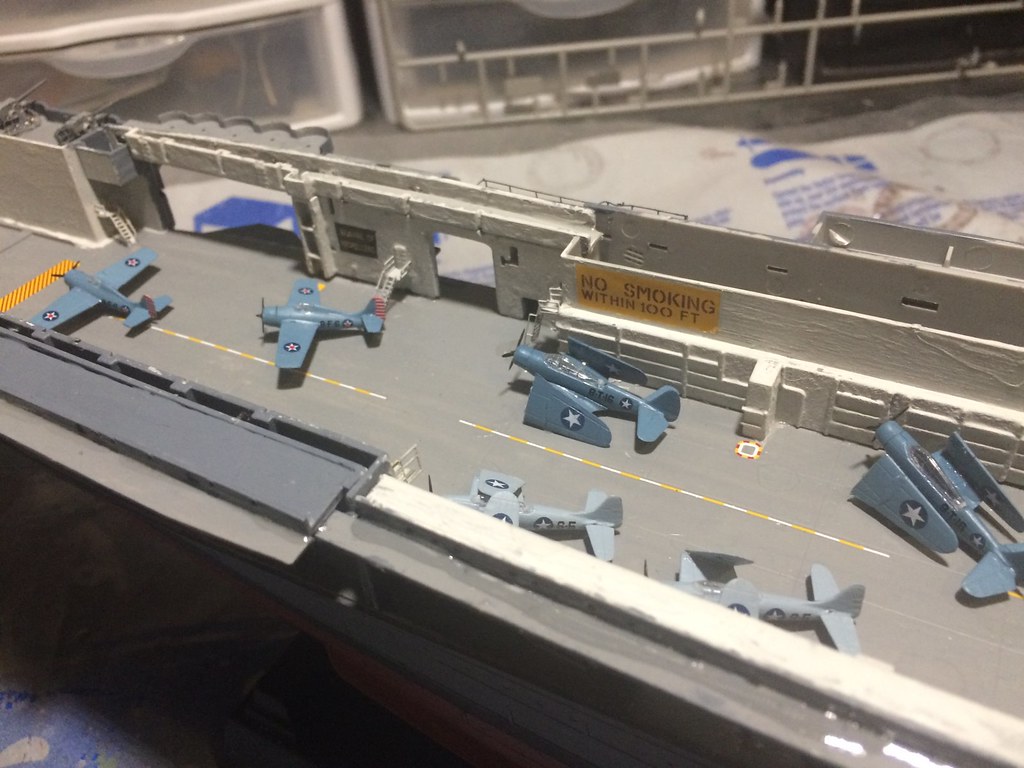
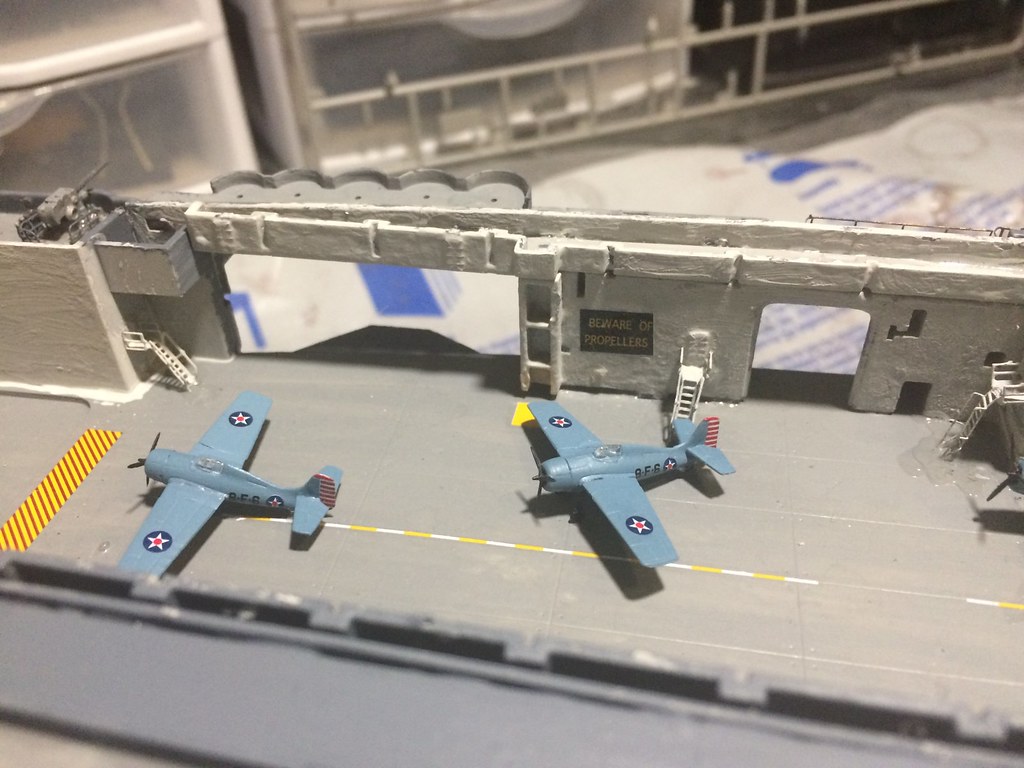
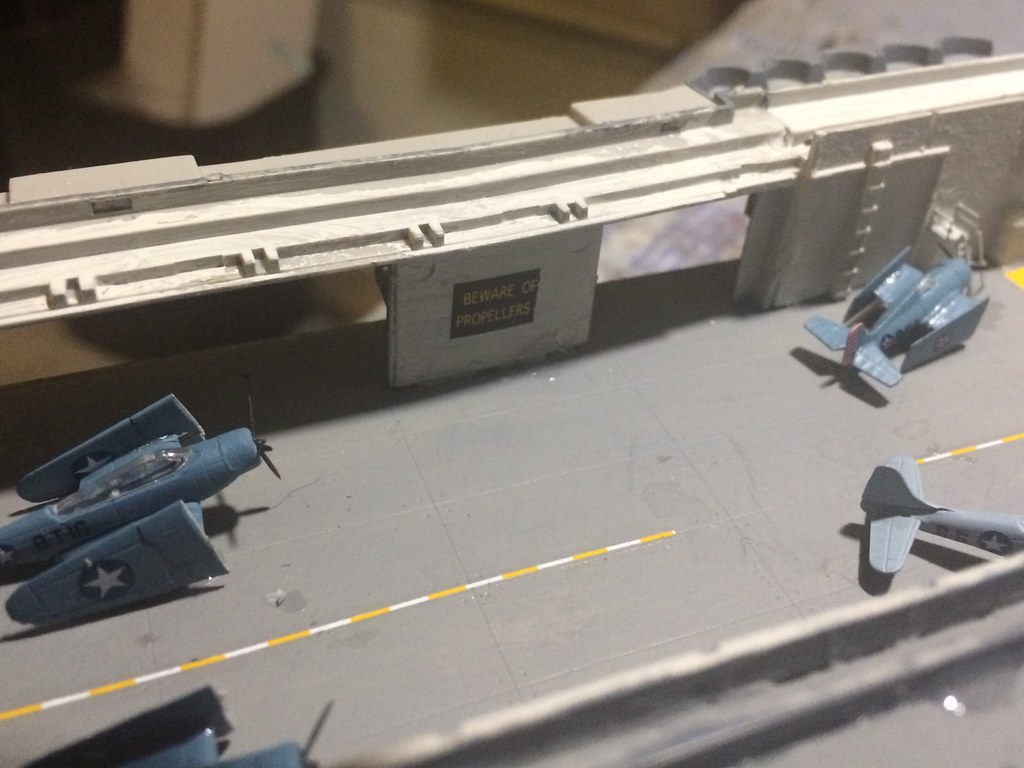
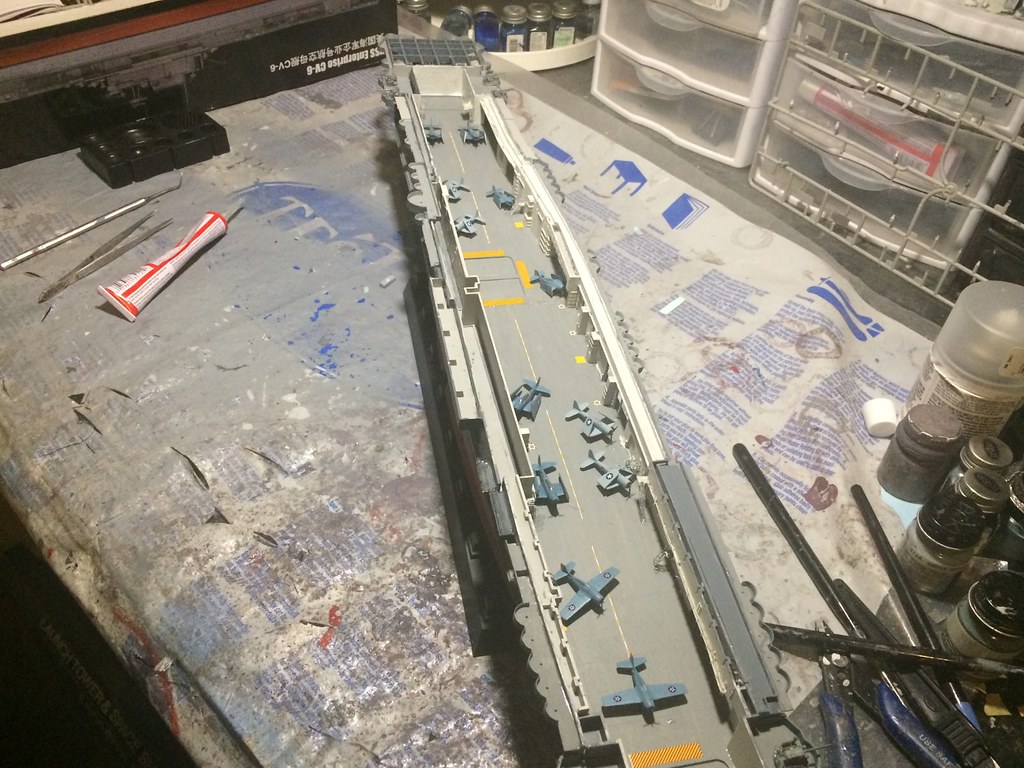
I ultimately placed 12 aircraft in the hanger deck. Four Wildcat fighters, four Avenger Torpedo bombers, and four Duantless dive bombers.
This will allow me to place eighteen aicraft on the flight deck.
The Build - Sub-structure for the flight deck, and then adding the flight deck - April 25, 2017, 2017
At this point I needed to add the structural support for the flight deck, a good deal of which is visible from within the hanger deck.
I moxed my dark grey, blue, and gubnshio greys to come up with just the right blueish grey deck that the Enterprise utilized.
This allows for some fairly good detail for how these pre-world war II aircraft carriers had been built:
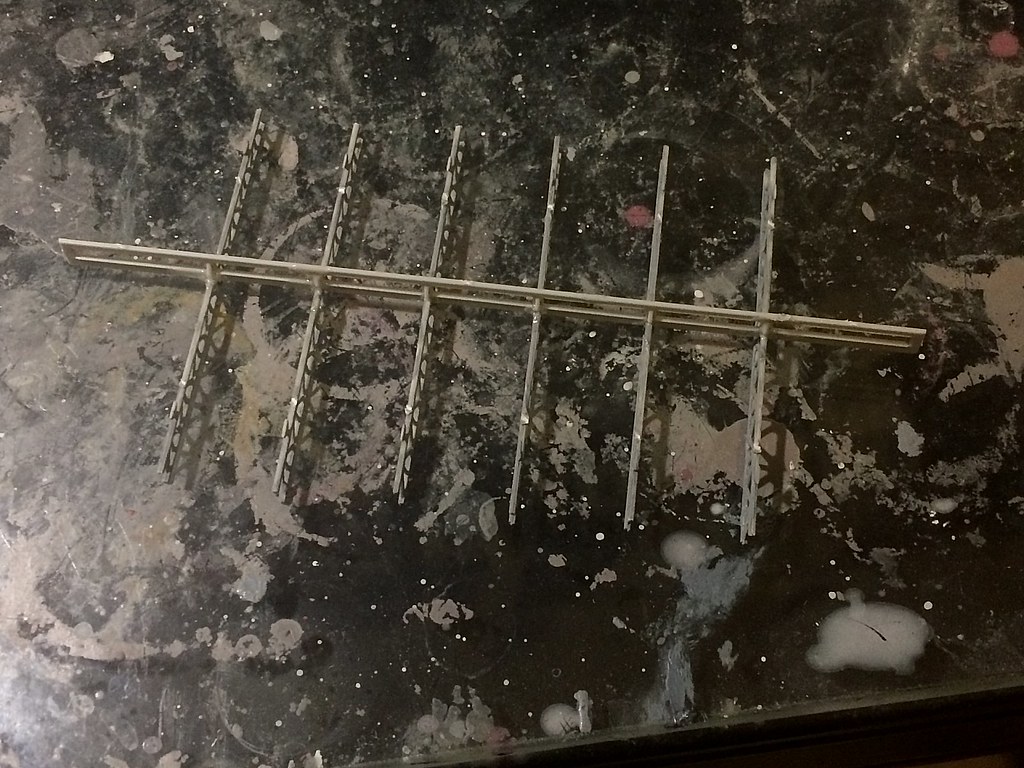

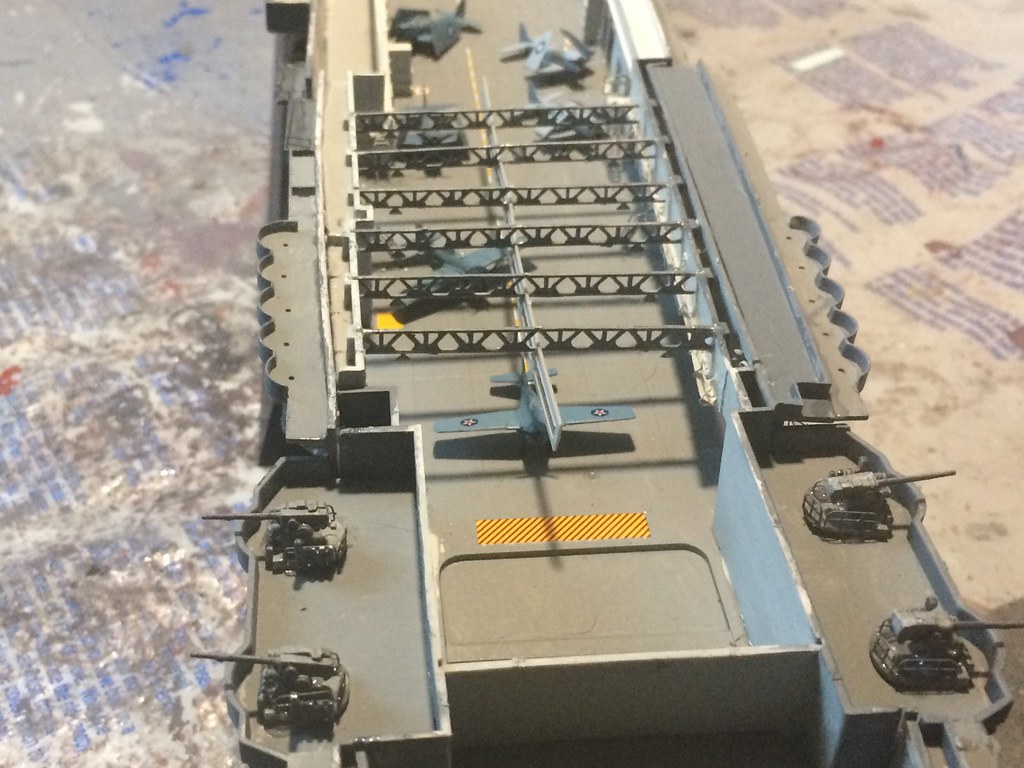
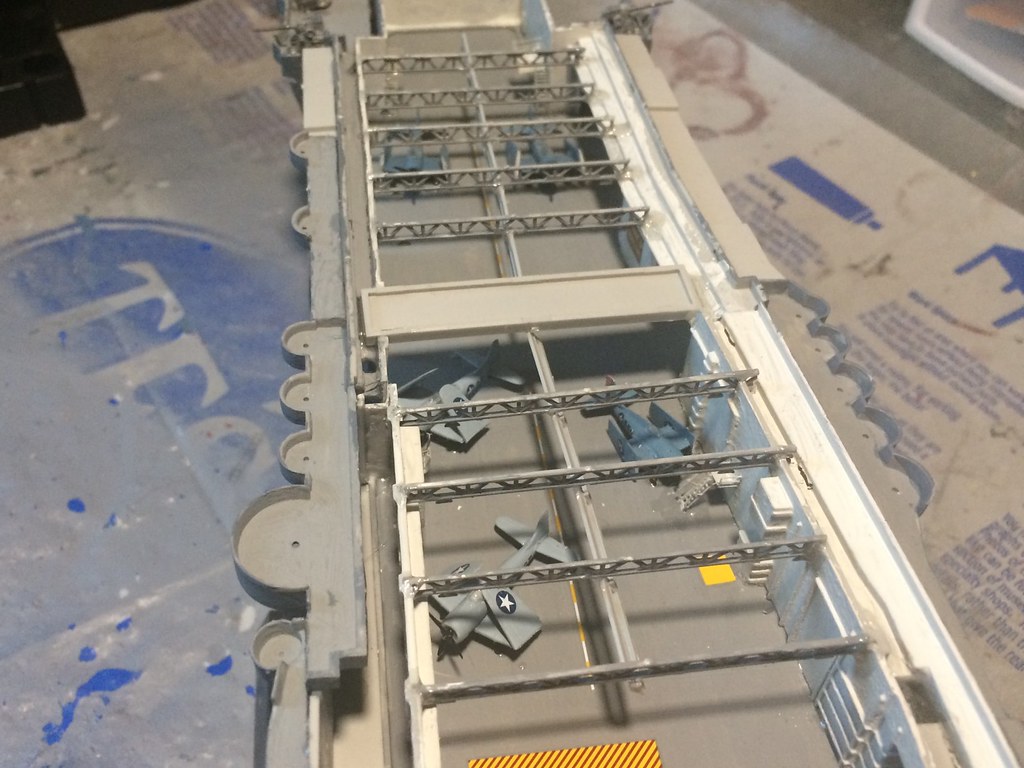

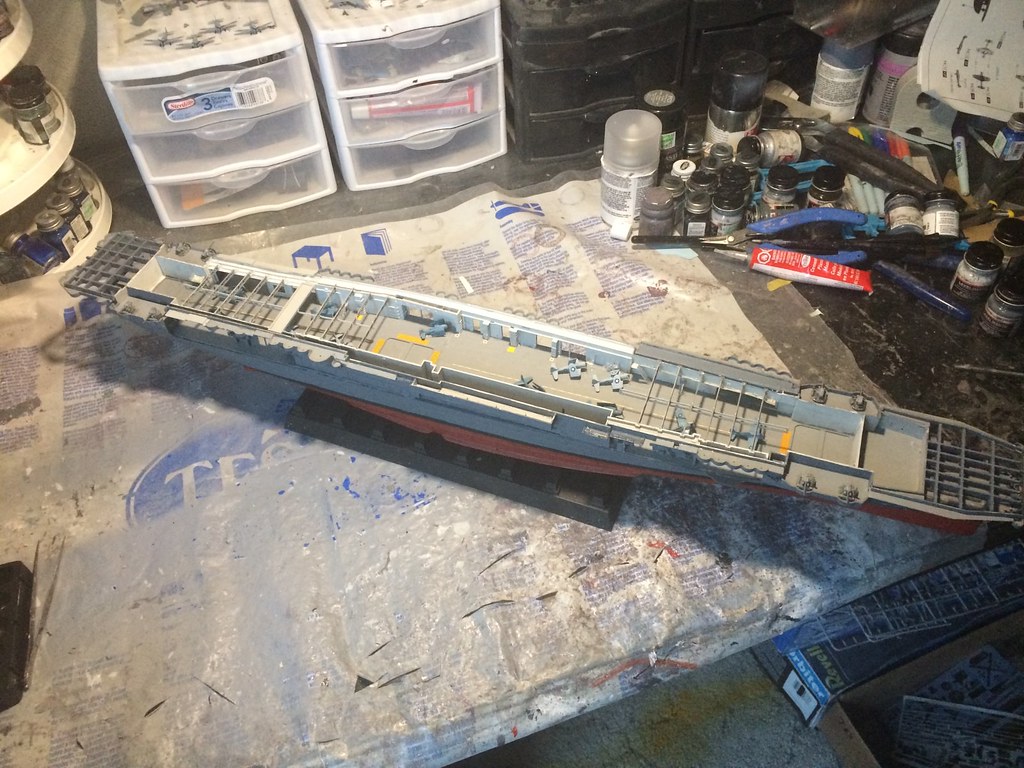
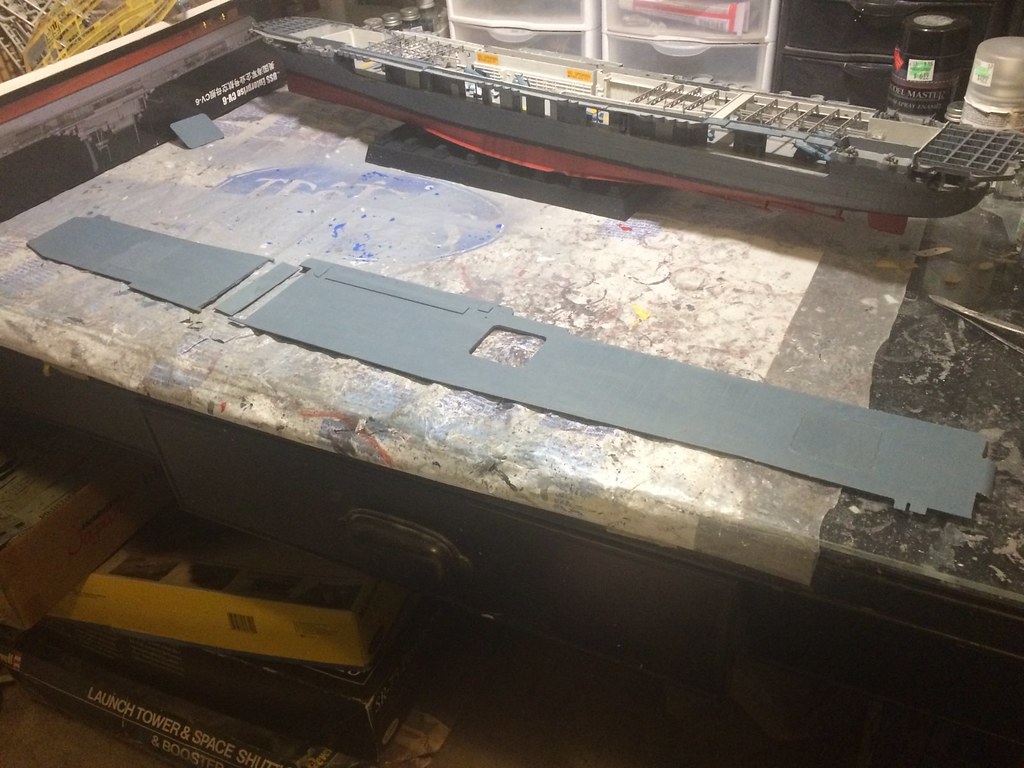
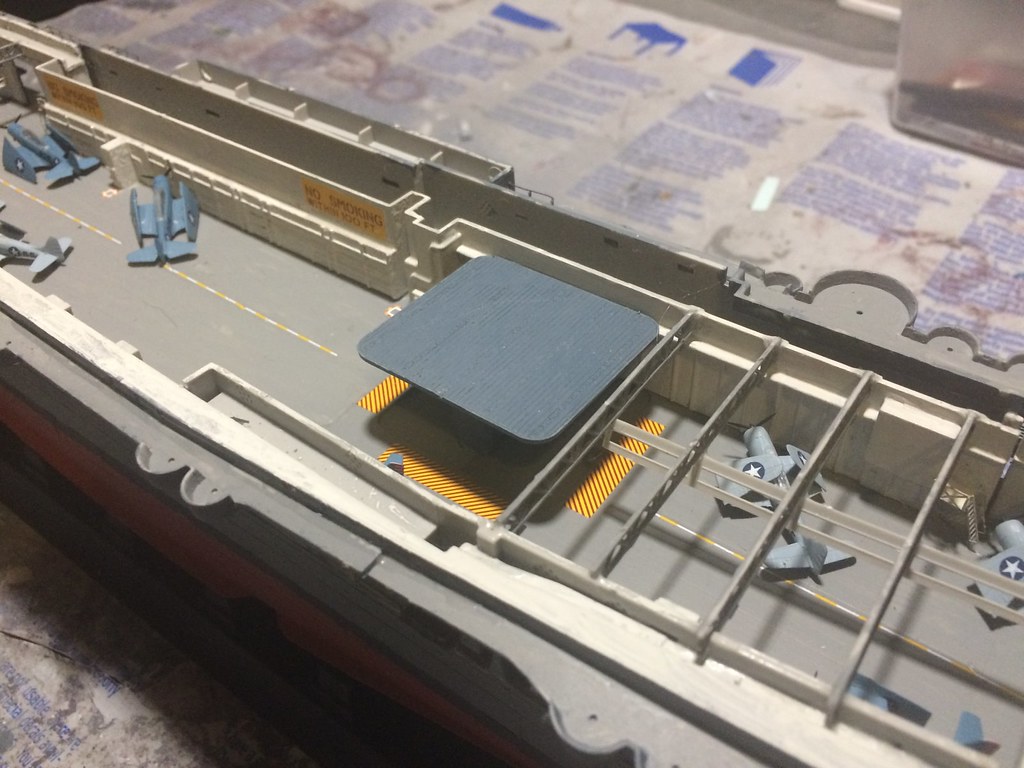
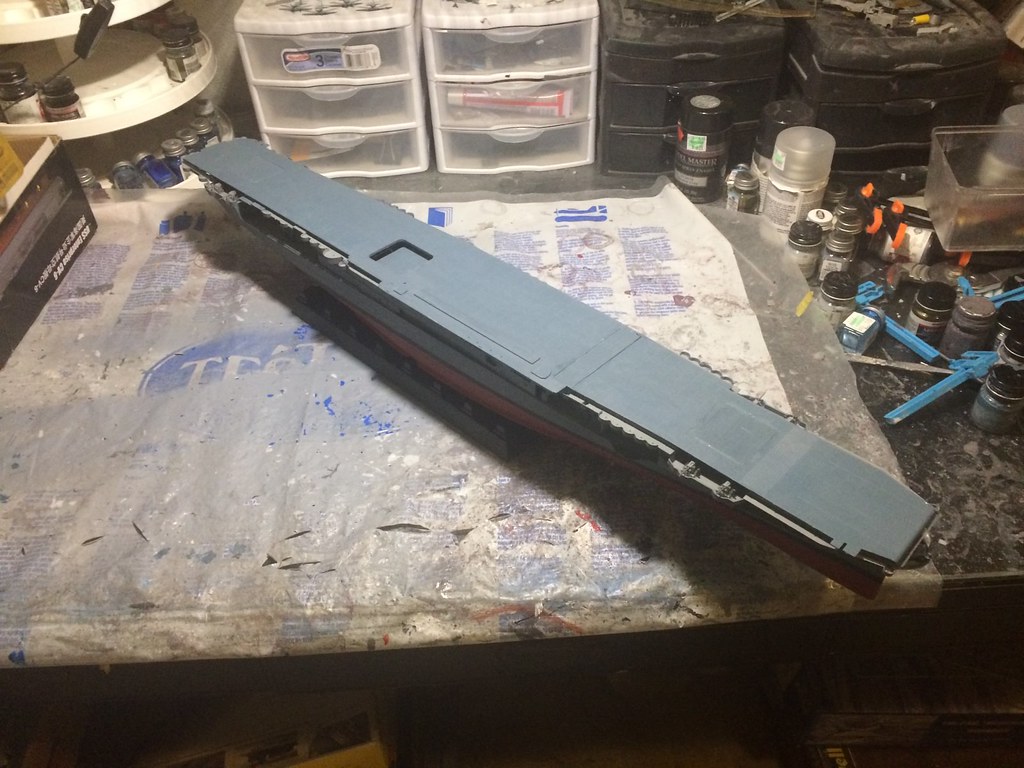
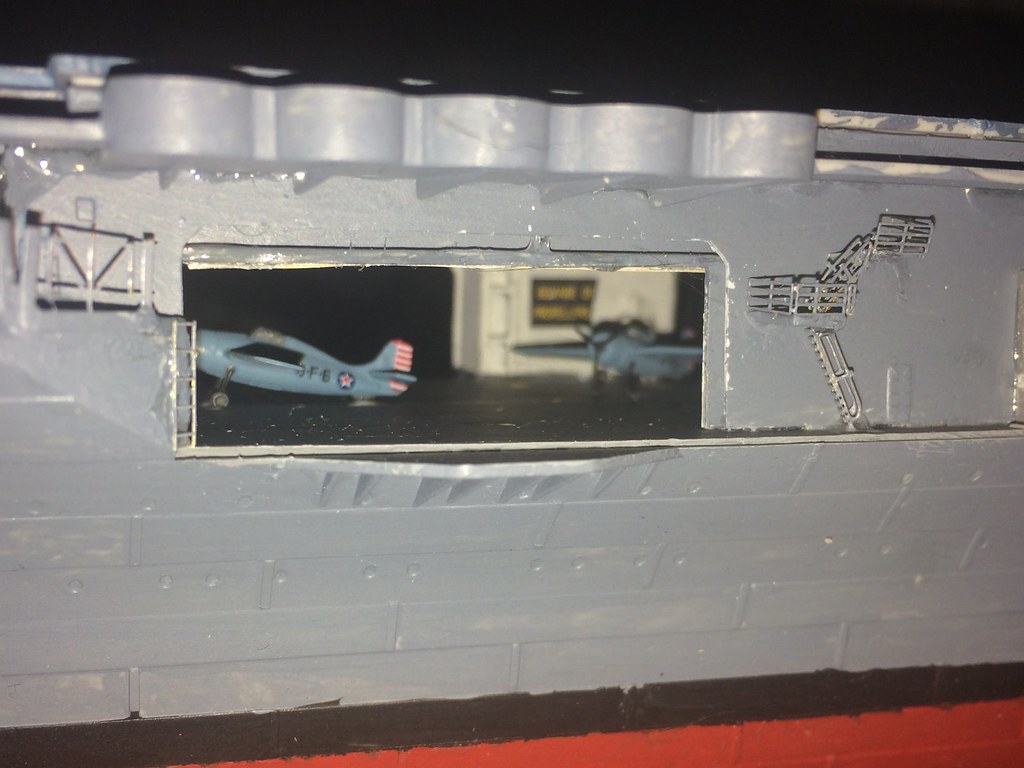
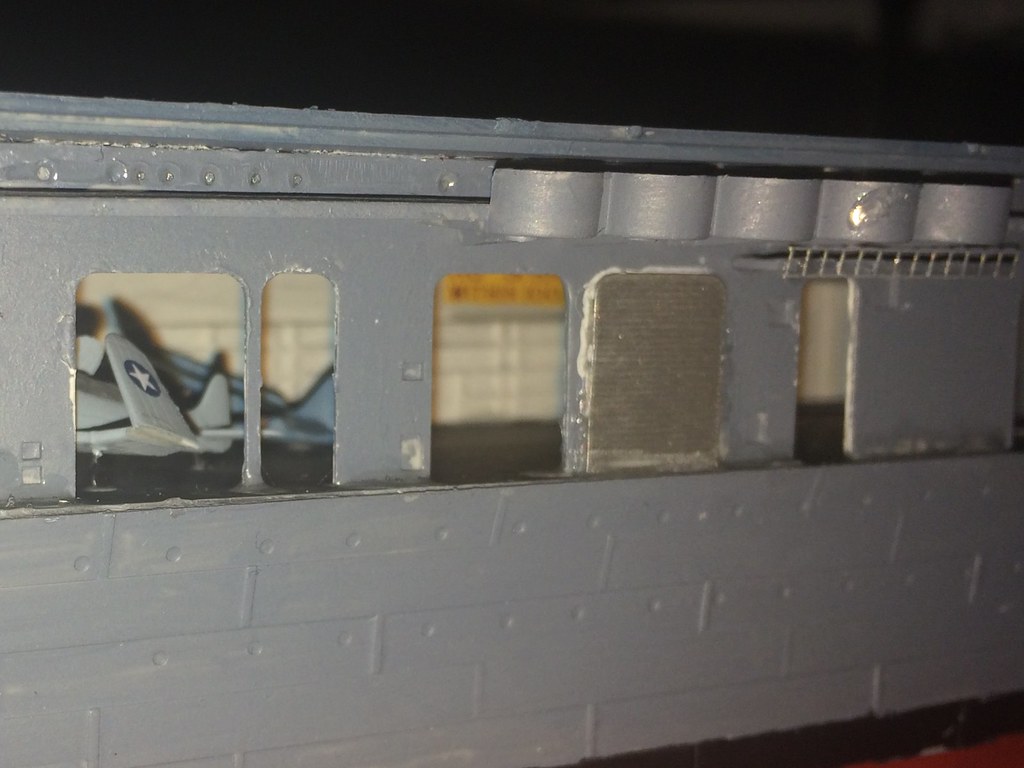
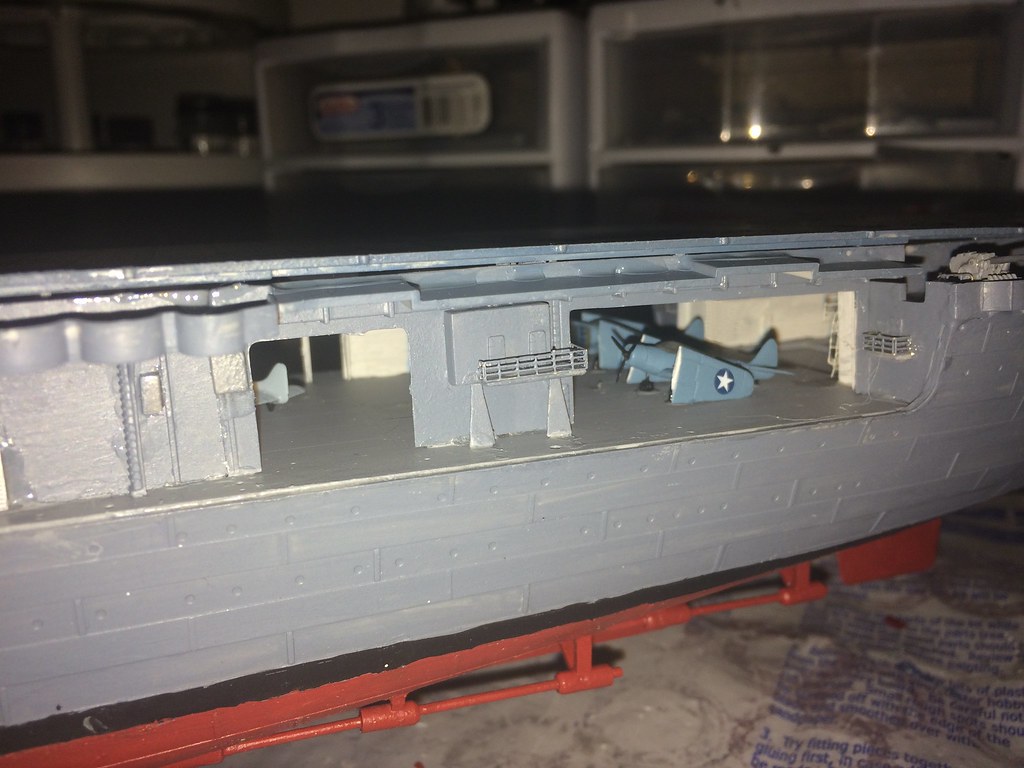
As you can see, the vessel is looking very good at this point with the flight deck added.
The hanger deck looks pretty good underneath too.
I was going to add a lighting system, but with all of the opneing available, most of which I will leave open, I decided to allow people to just either use a flash light, or natural lighting to show off what I did in there.
The Build - Adding the mani structures in front and back of, and the island main assembly - April 28, 2017
I then needed to start on all of the structure around and incompassin the island. The island is very detailed and this will take a couple of sessions at least...inmcuding the quad forty millimeter anti-aircraft guns.
Here's how it went:
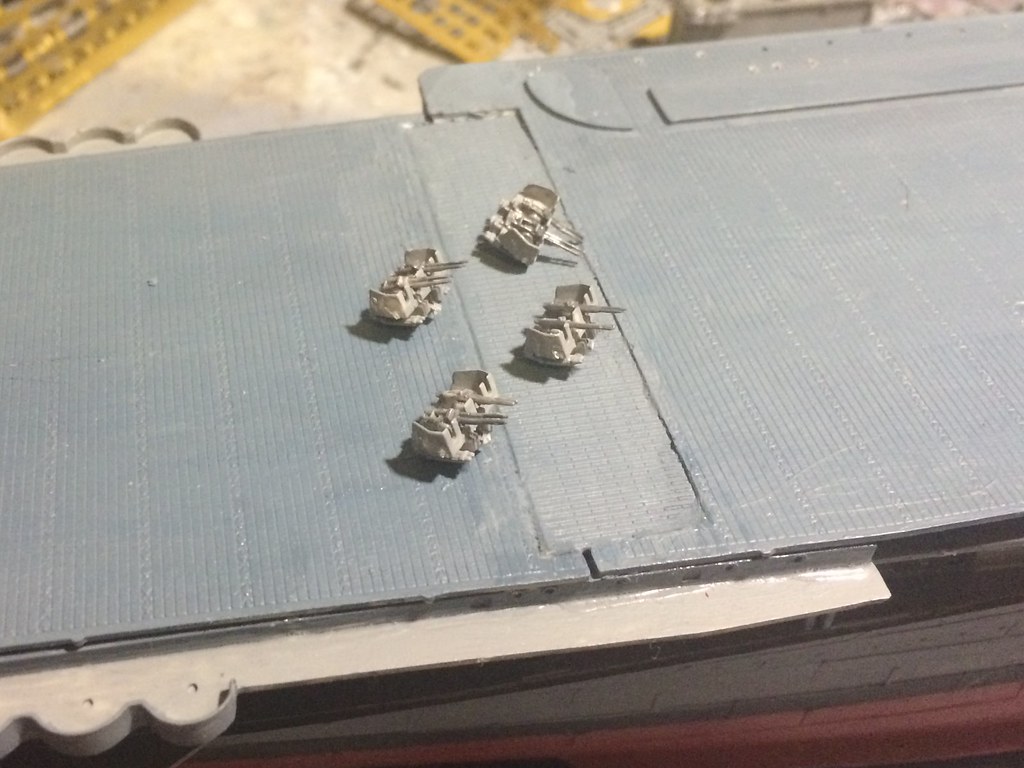
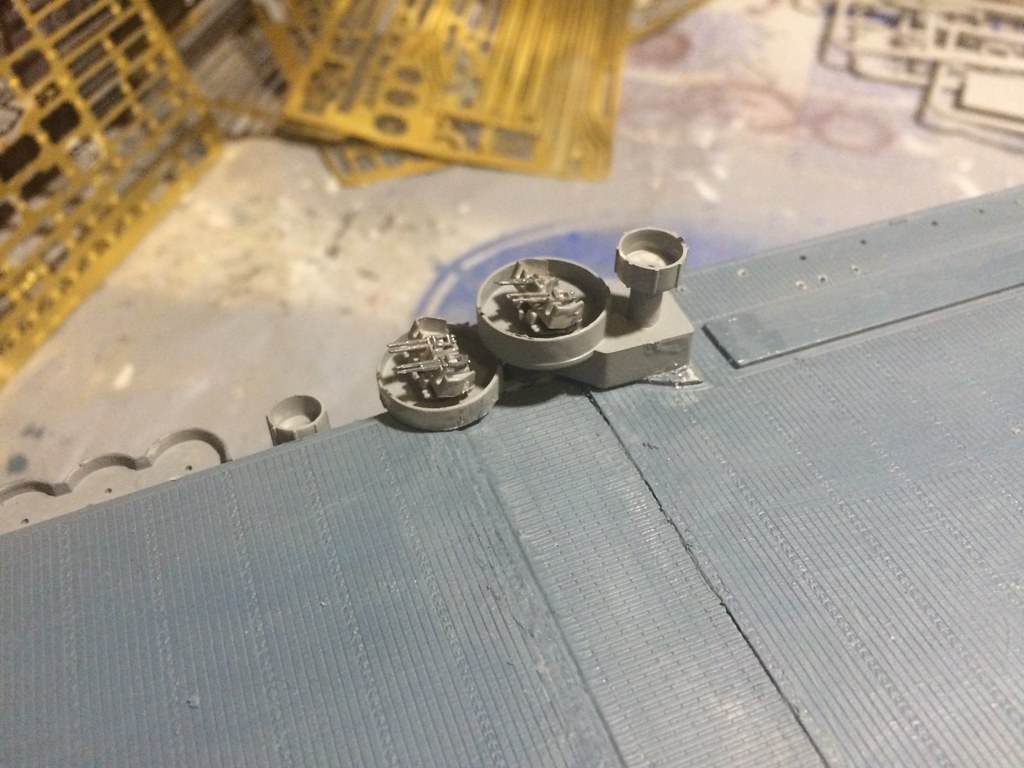
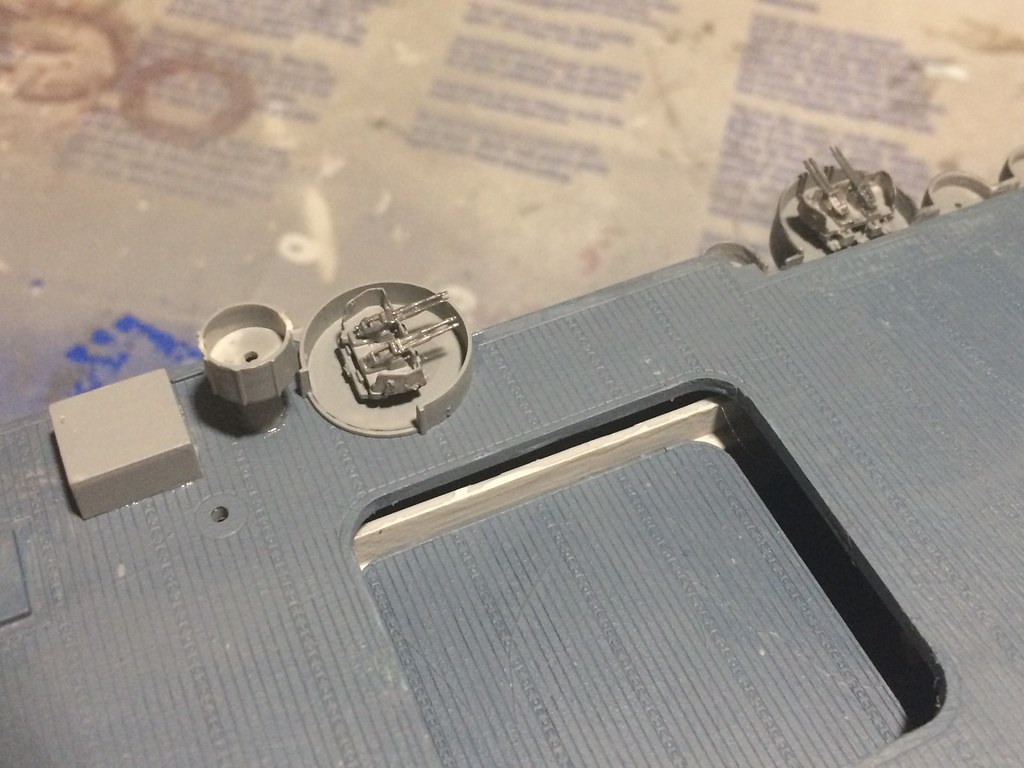
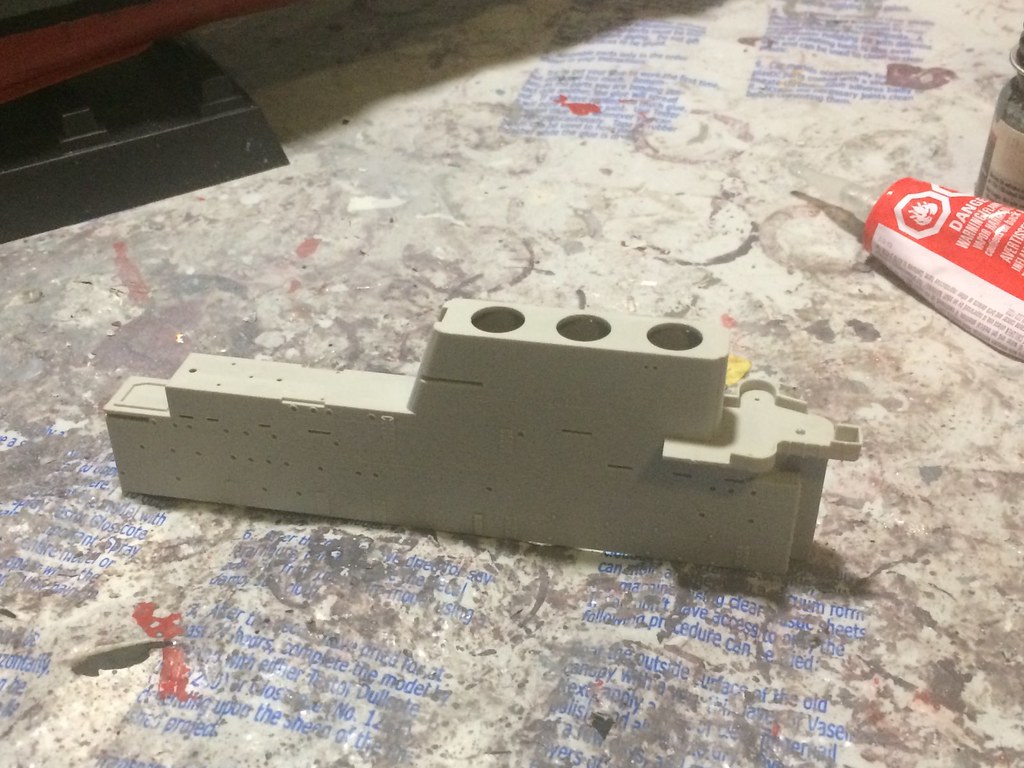
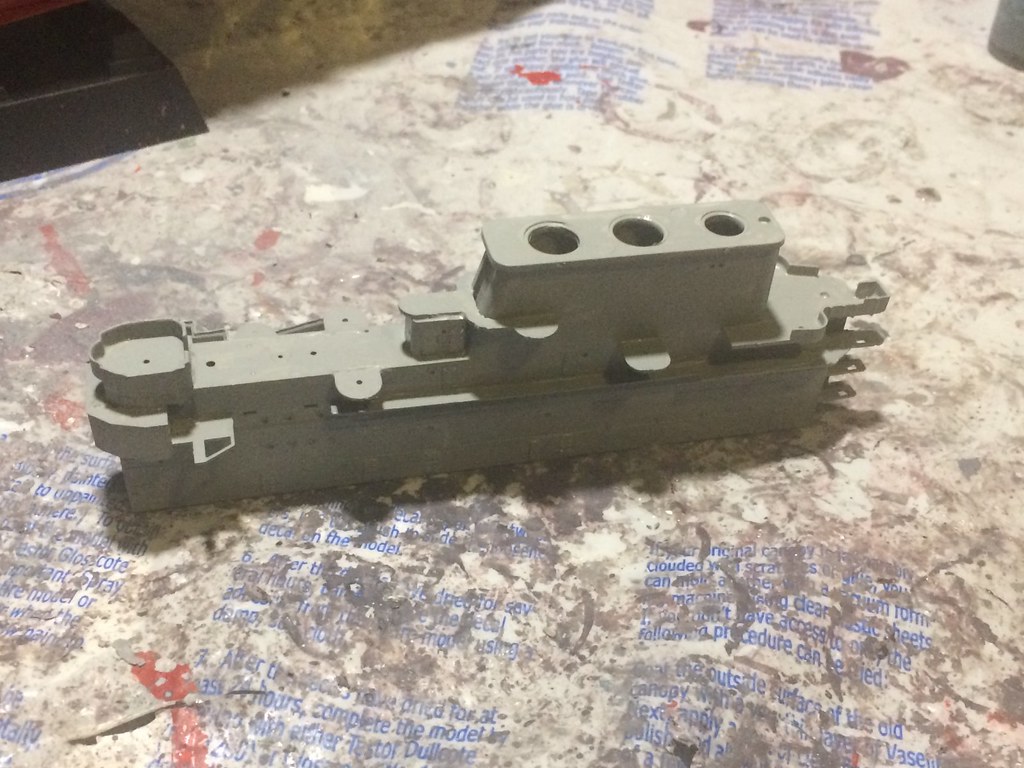
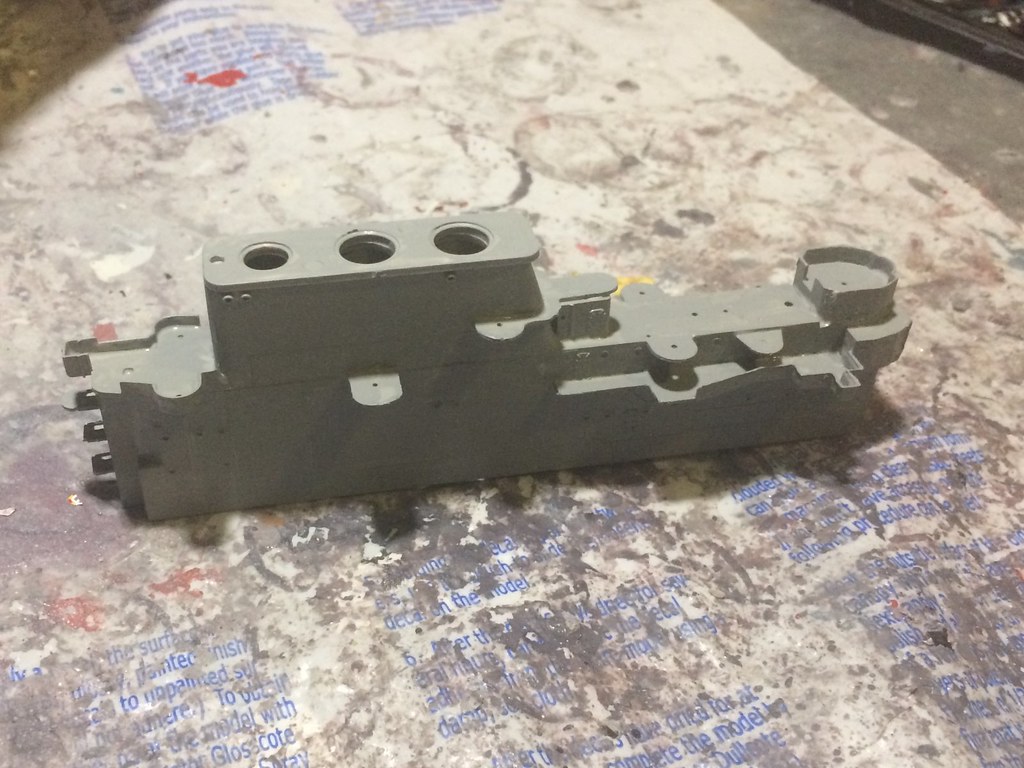
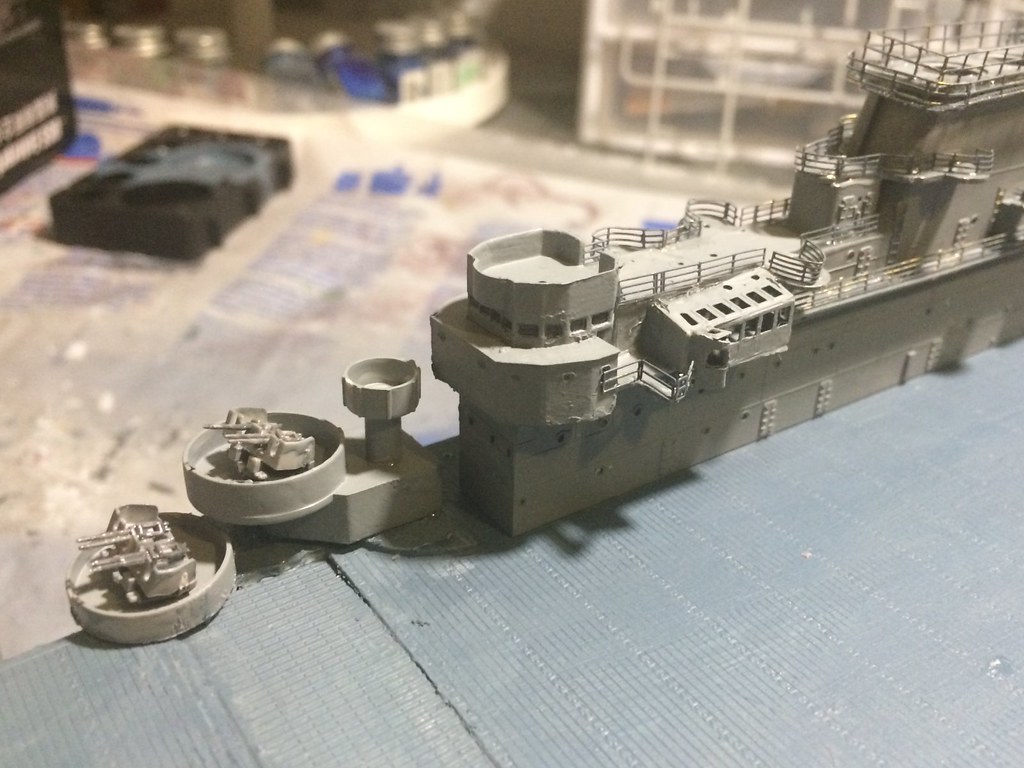
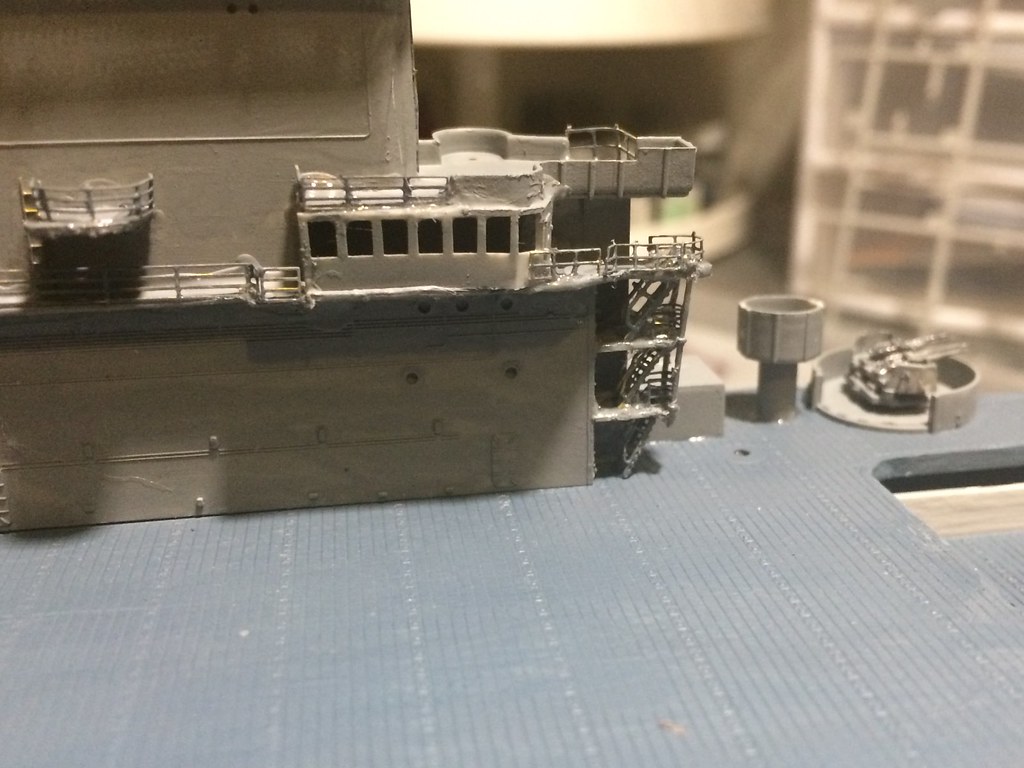

I decided during this session to also build out the ships launches and boats and the cranes, both on the flight deck and on the lower deck outside of the hanger, and did that while building more of the details into the island.
...including the many, many fifty caliber maching guns and their armor plate protection. There are A LOT of them and they are very small indeed in building.
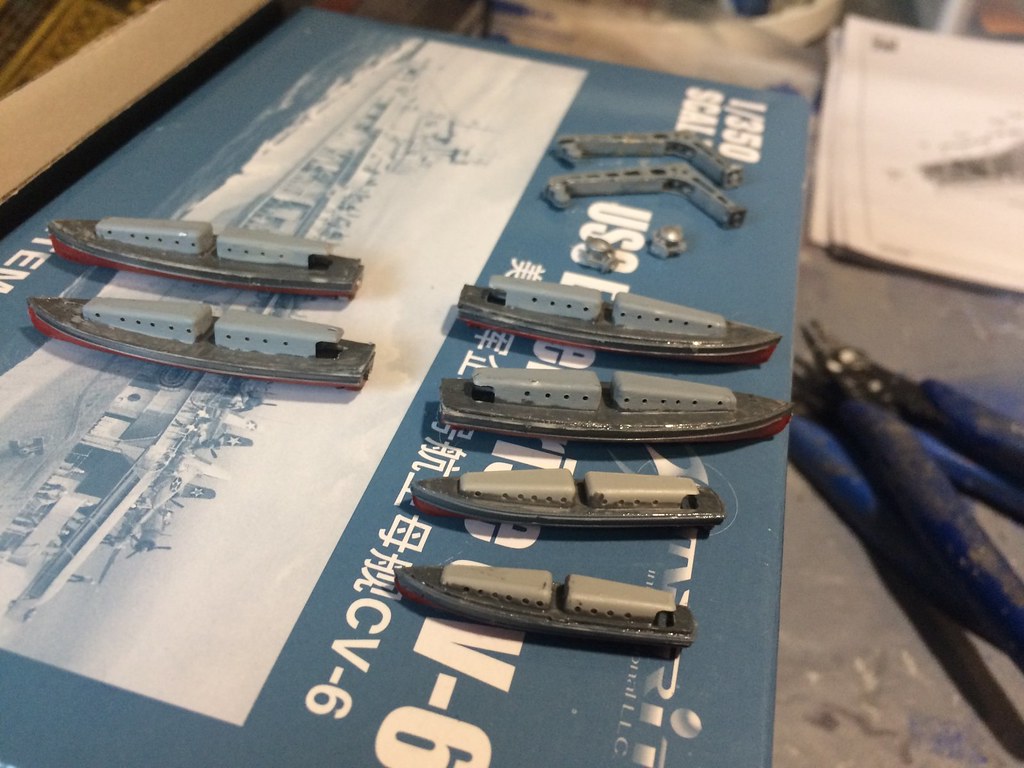
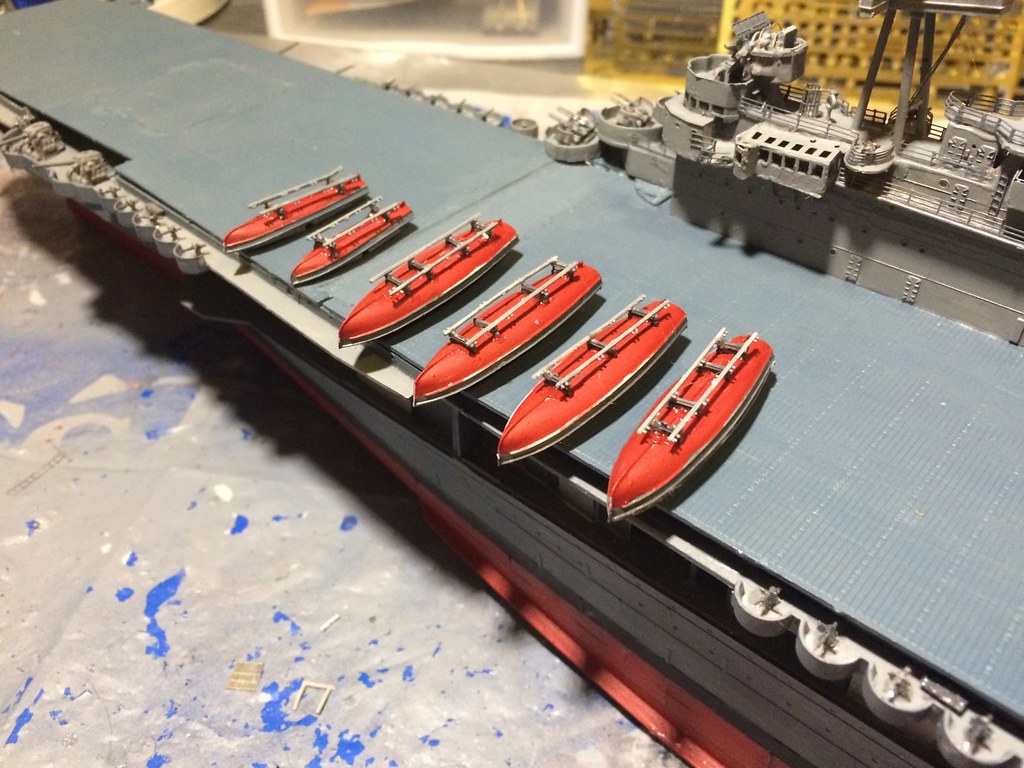
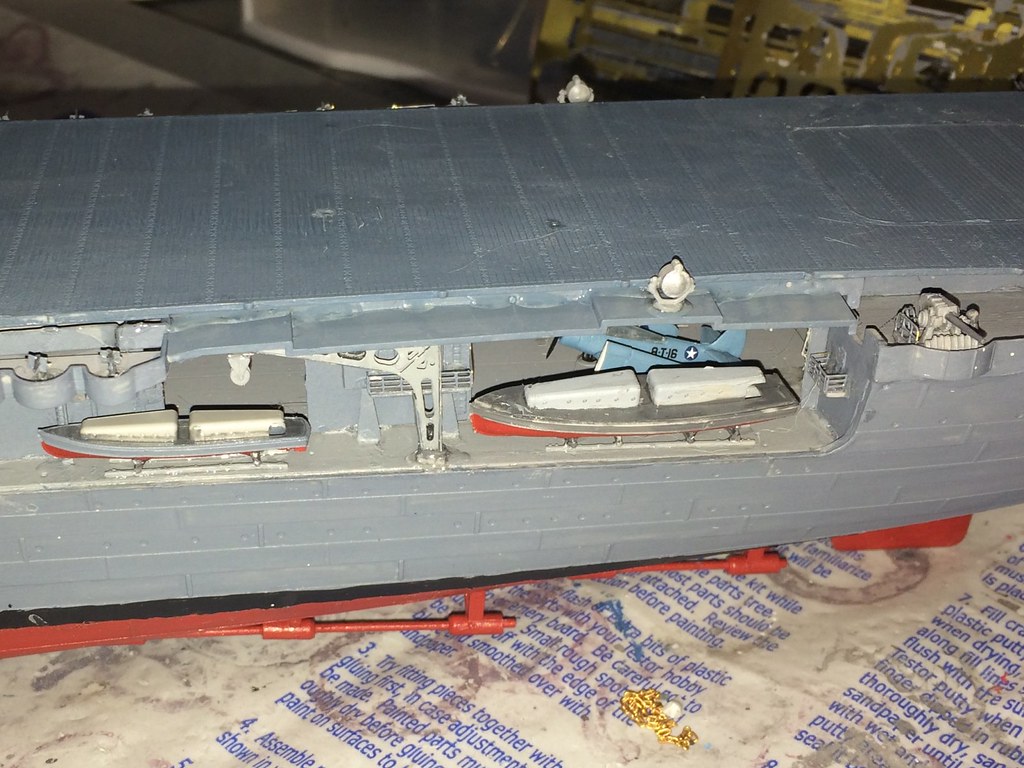
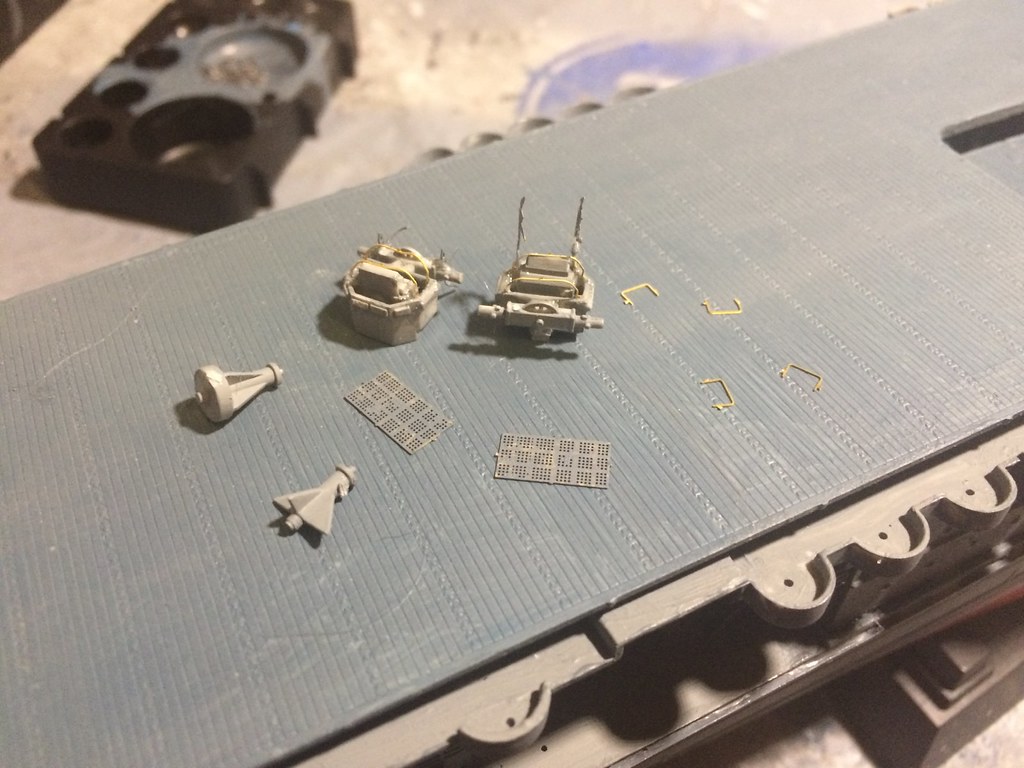
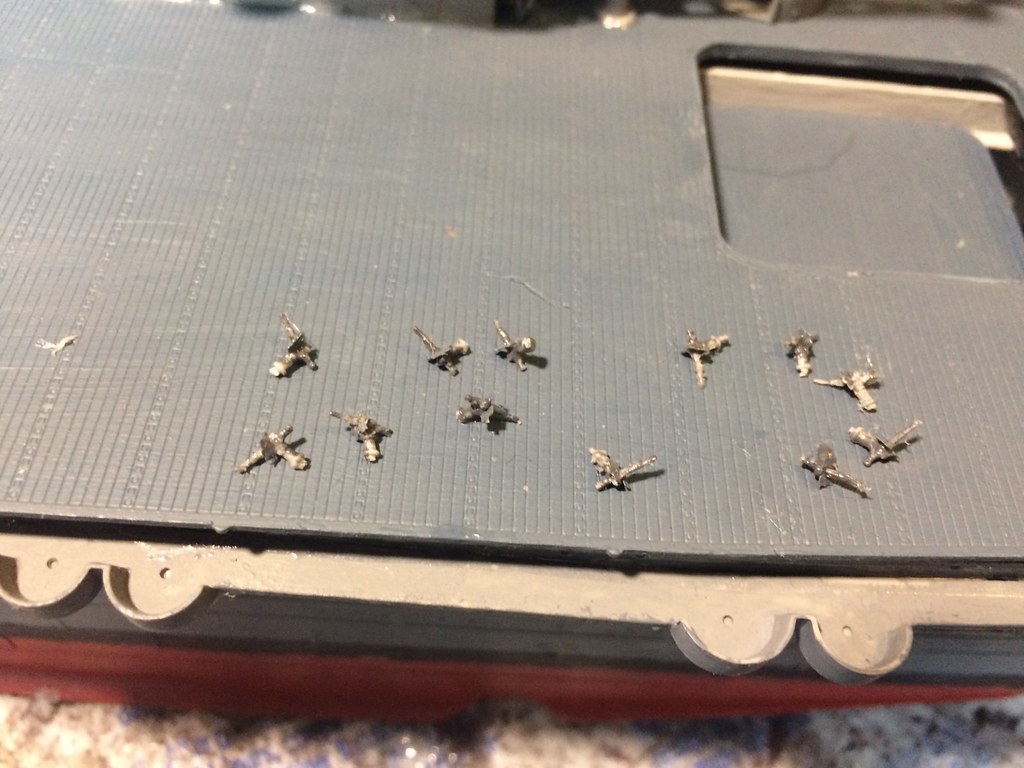
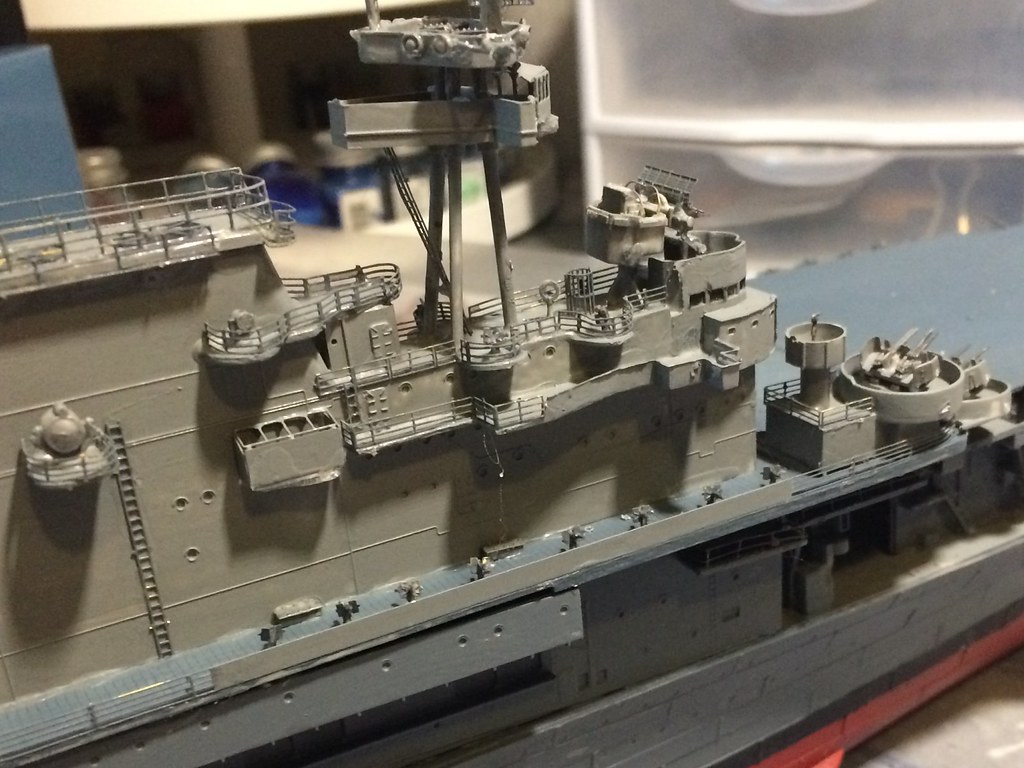
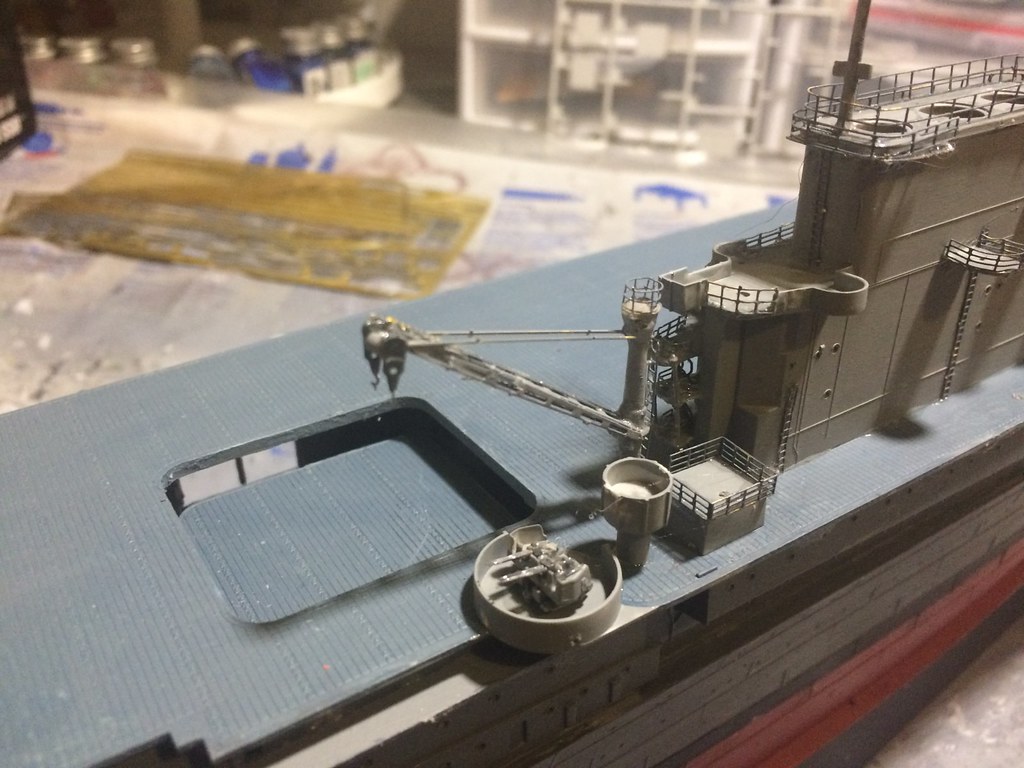
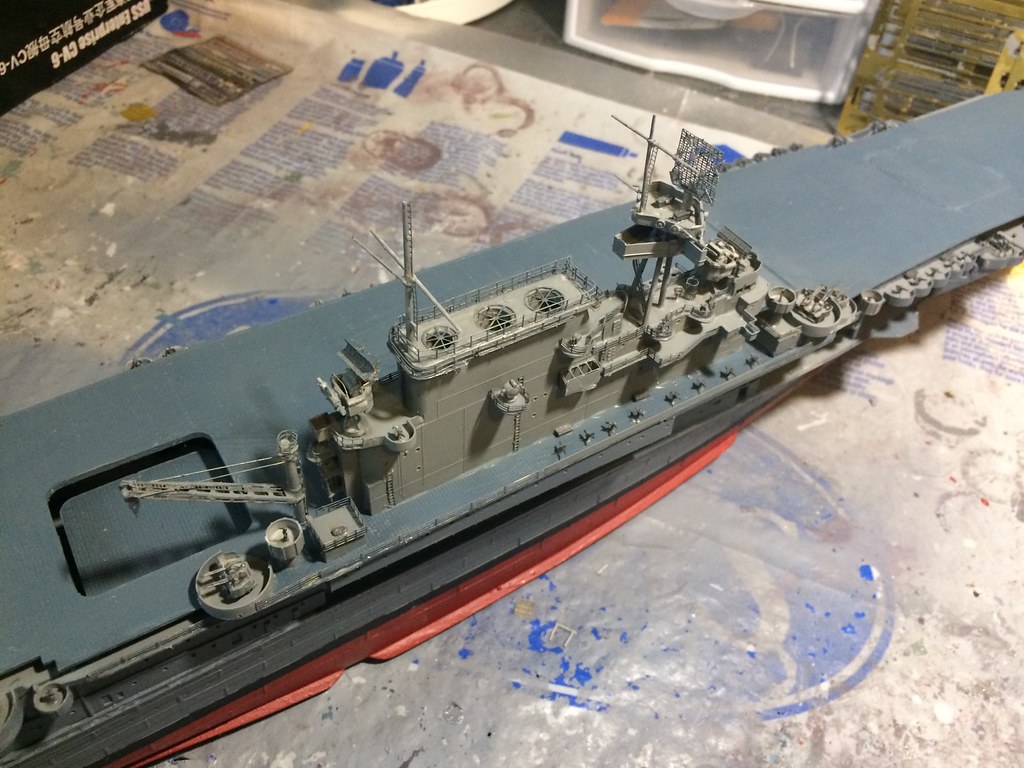
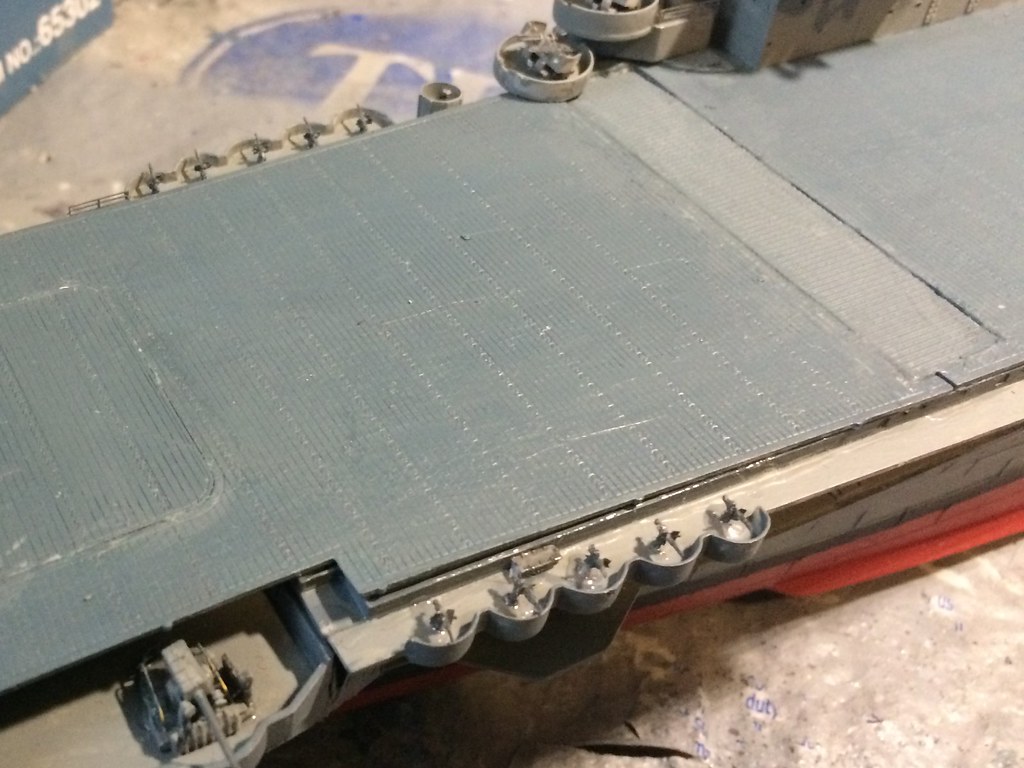
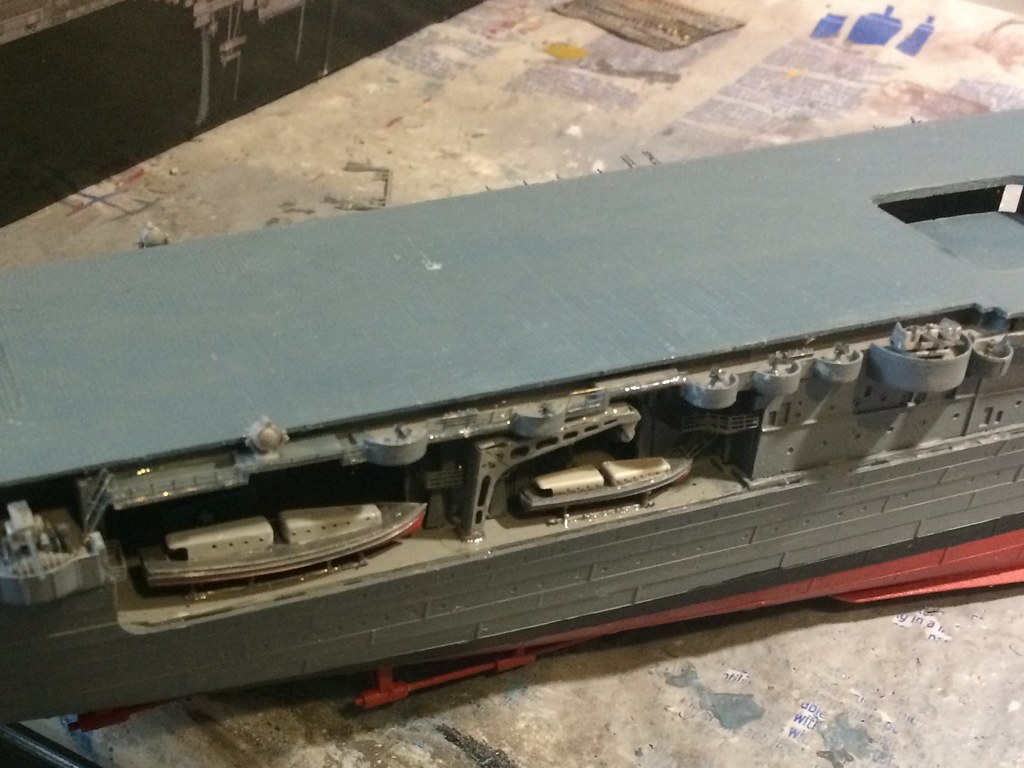
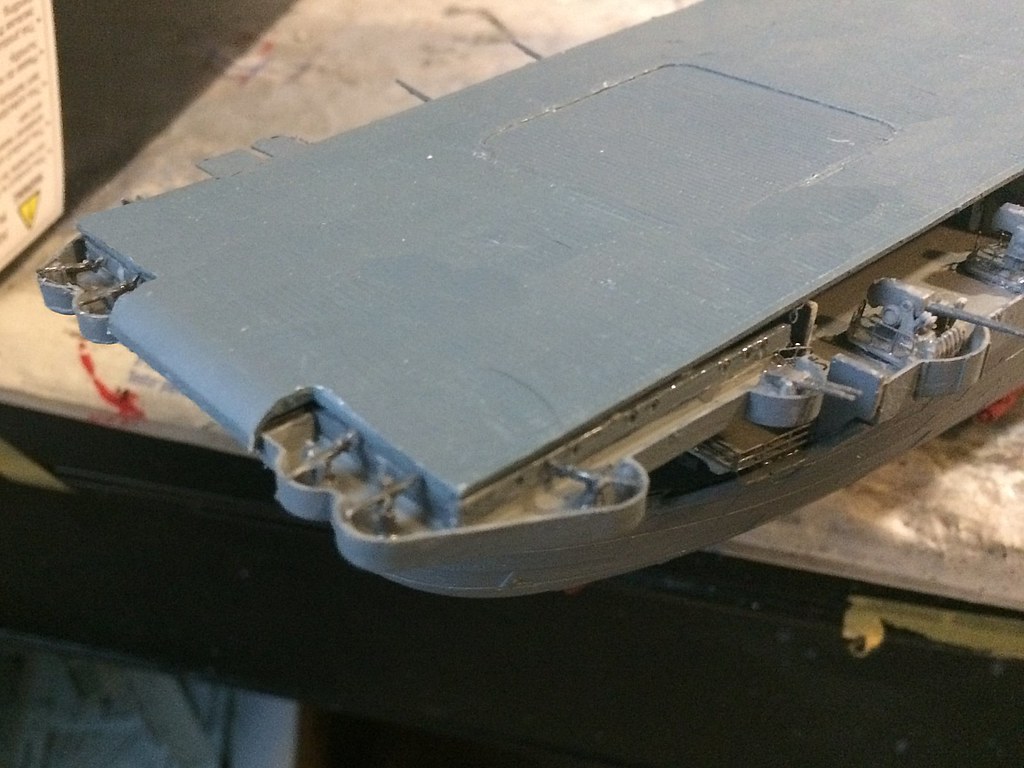
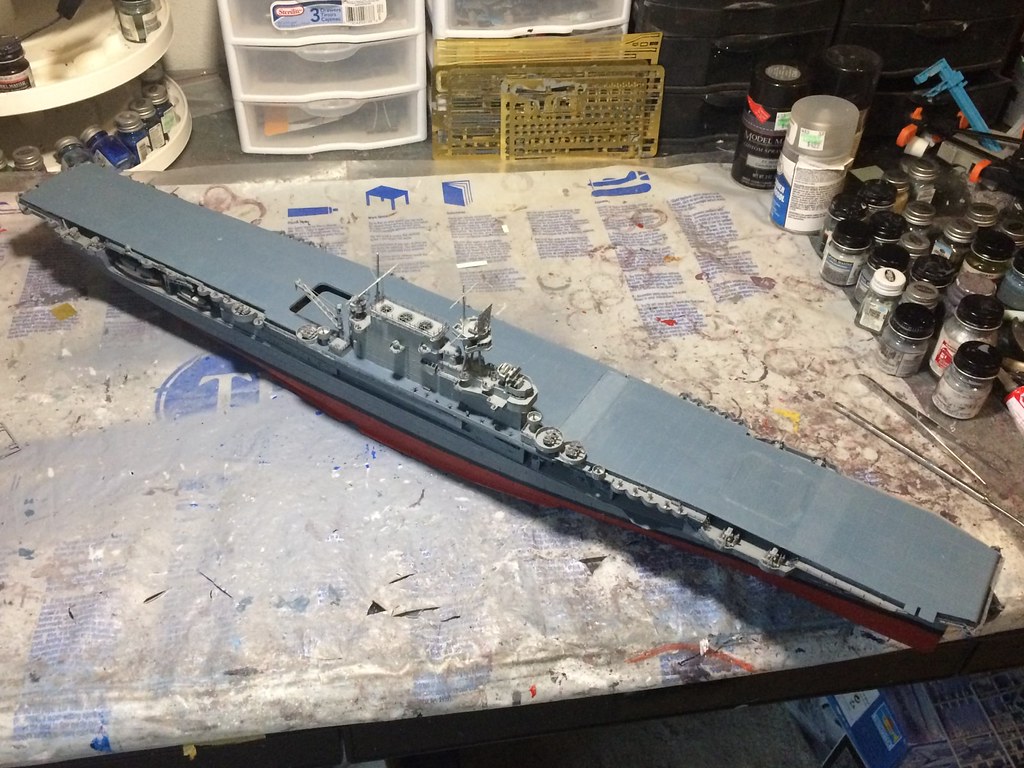
Now she is really looking like the Enterprise!
The Build - Adding the flight deck decals and building and placing the air wing on the flight deck - May 2, 2017
It was now time to add the decal markings onto the flight deck.
The large "six" that came with the model is a little too thick for the World War II markings...but I went ahead with it. If I find the large, thinner ones later, I will replace them.
As it is, this looks pretty nice once the dashed lines and elevator outlines were all in place.
I then built, painted, and added the airwing. Eight more Widlcats, eight more Duatless dive bombers, and a couple more Avenger torpedo bombers.
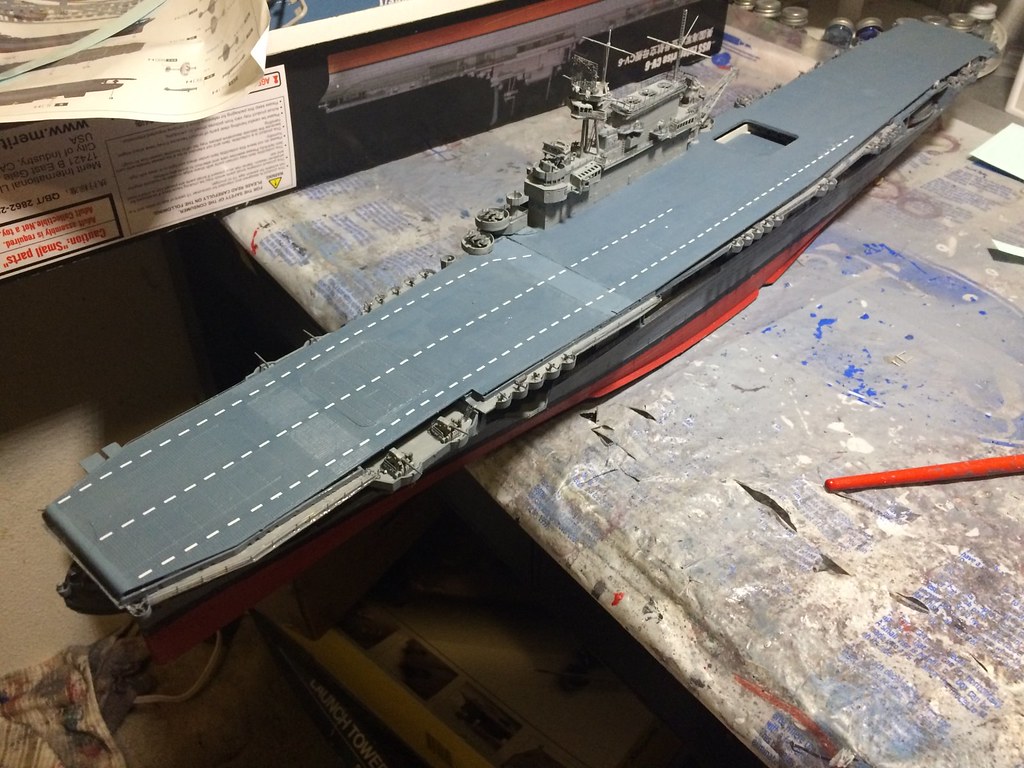
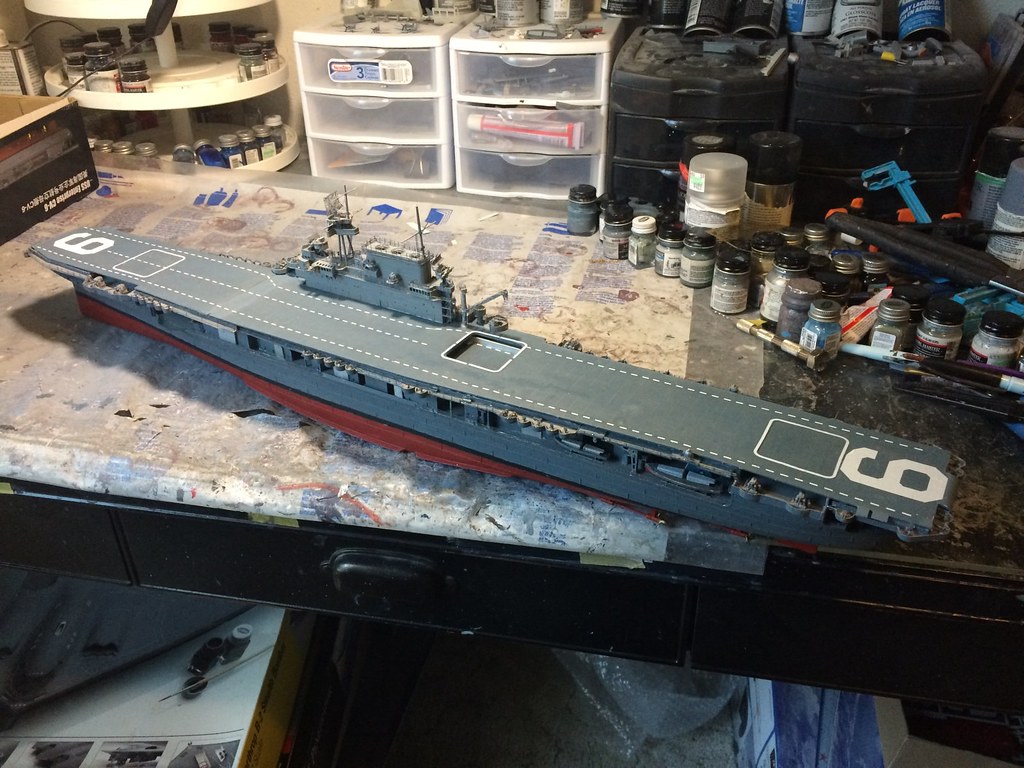
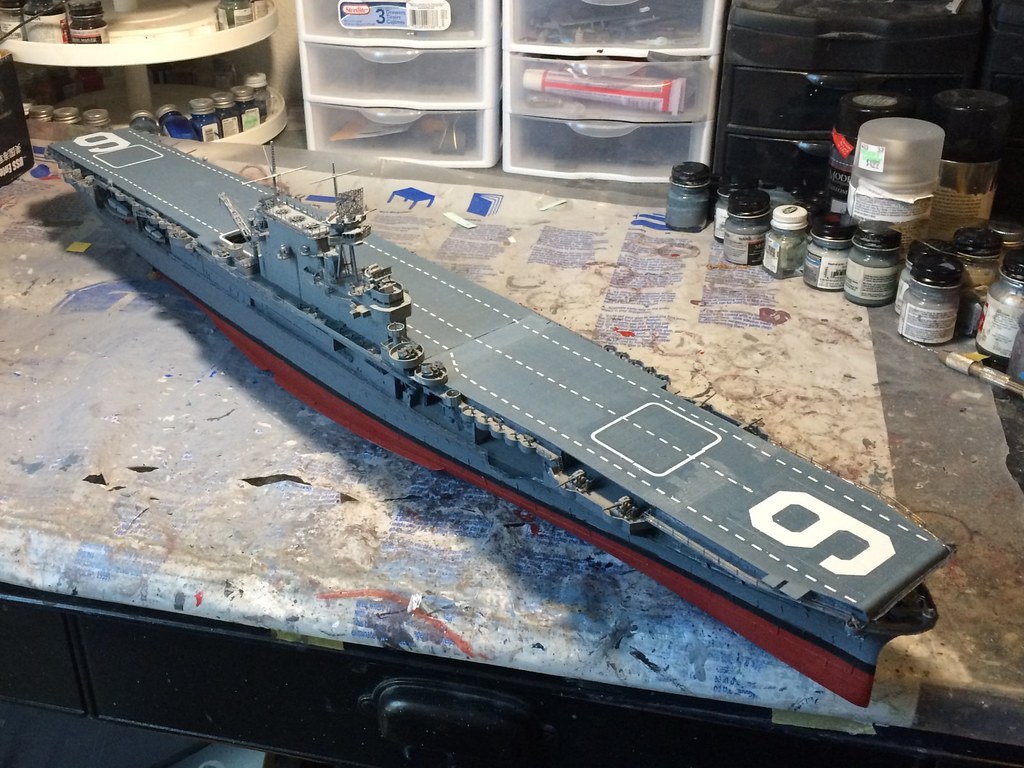
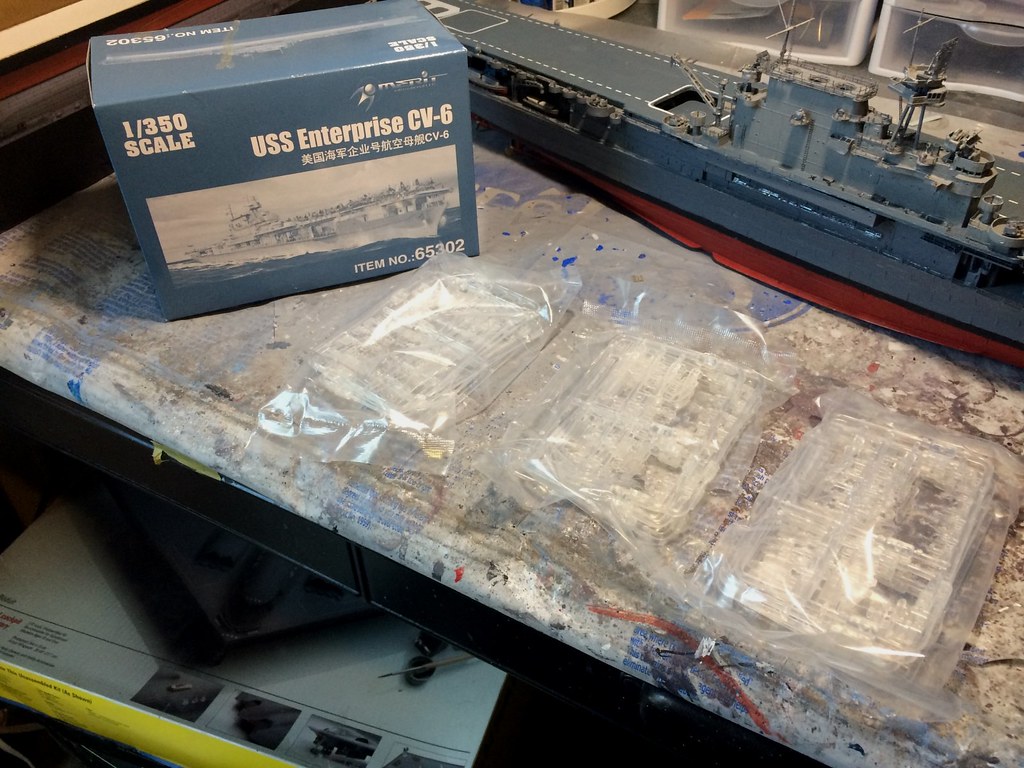
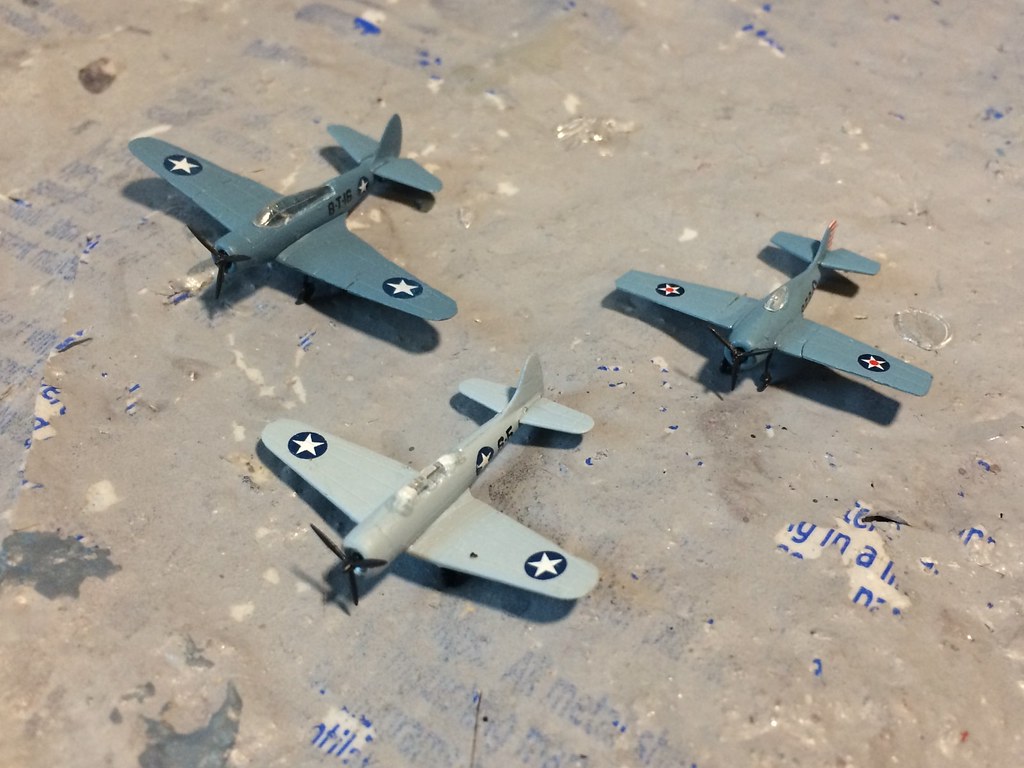
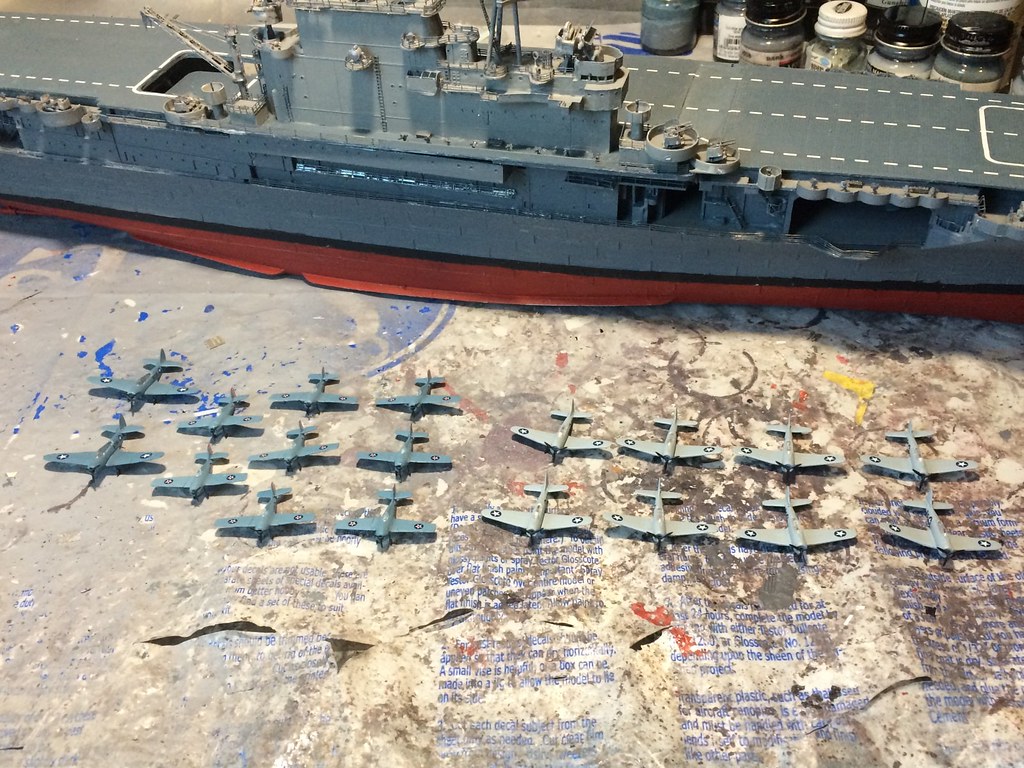
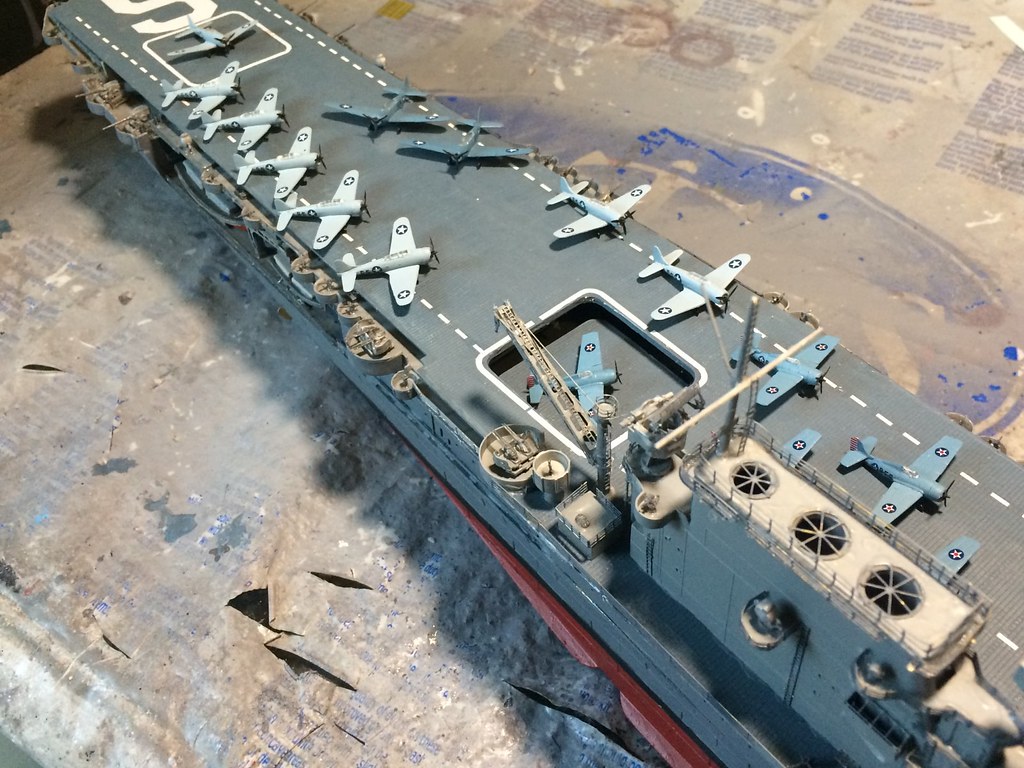
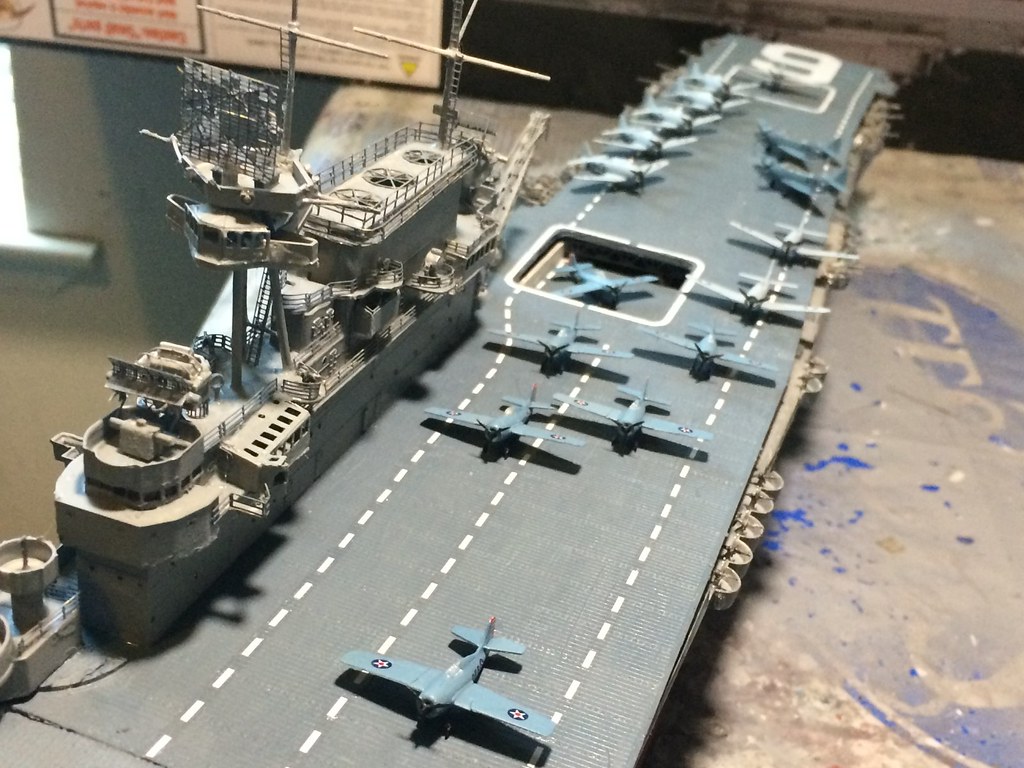
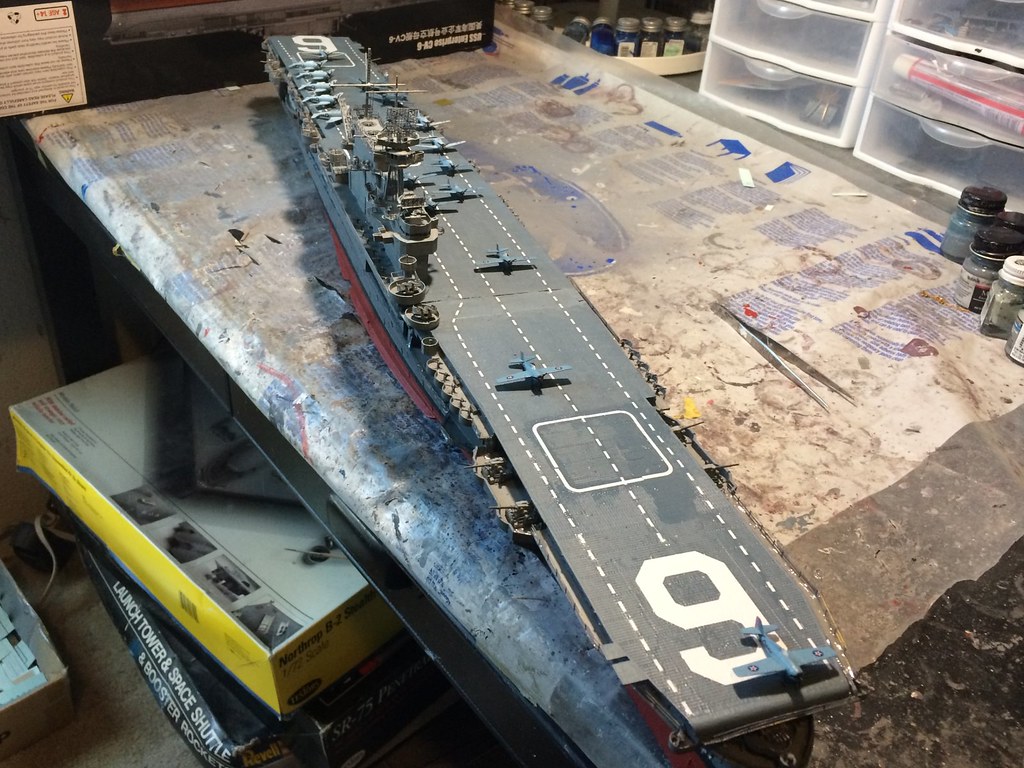
The Build - Final equiment and railings, final touch up and completion - May 7, 2017
There were stll numerous small parts for equipment to add and railing as well. THis was accomplished and then the two final coats of dull clrear coat were addded, as well as the stand. Then it was time for the final photos:
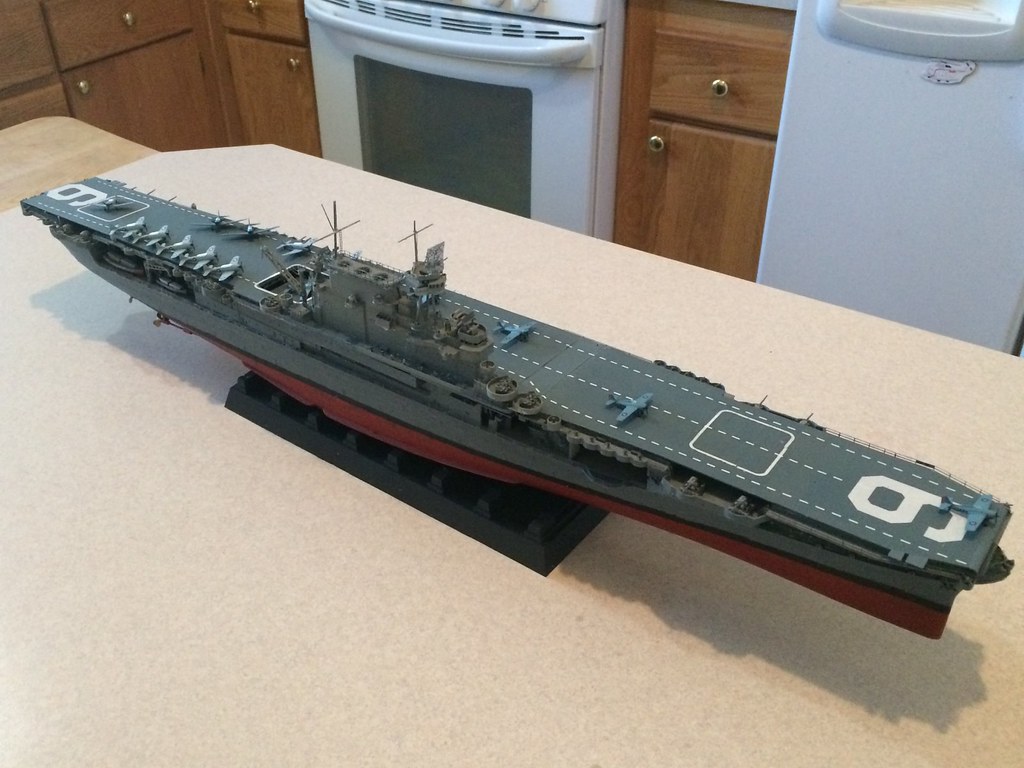
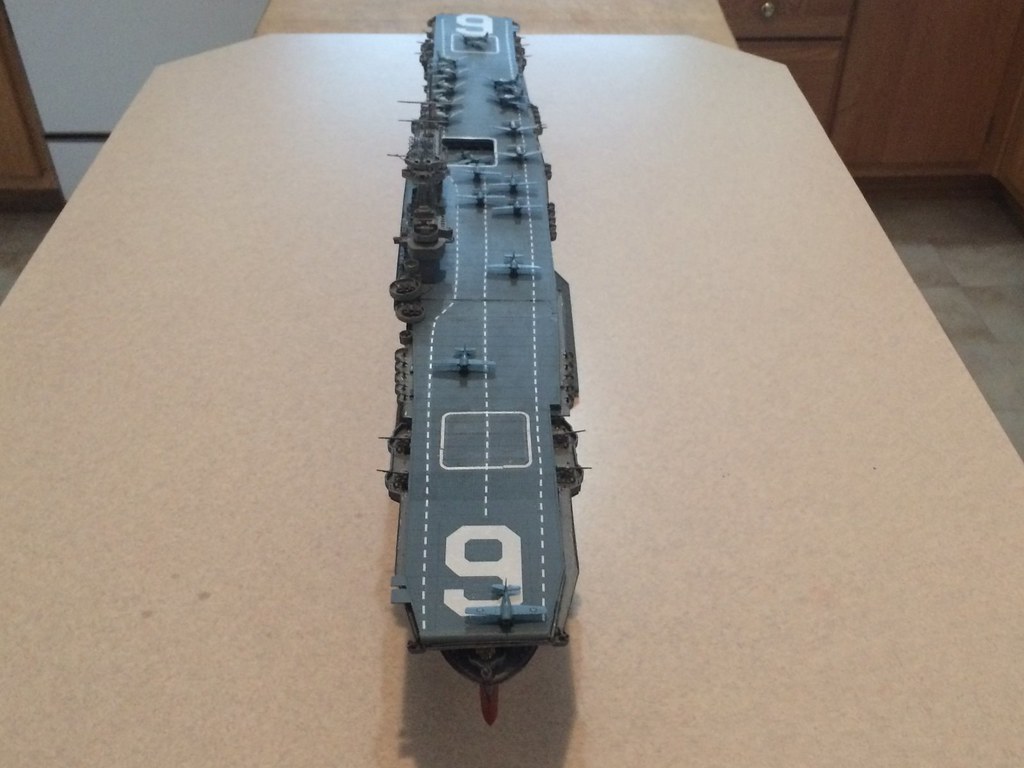
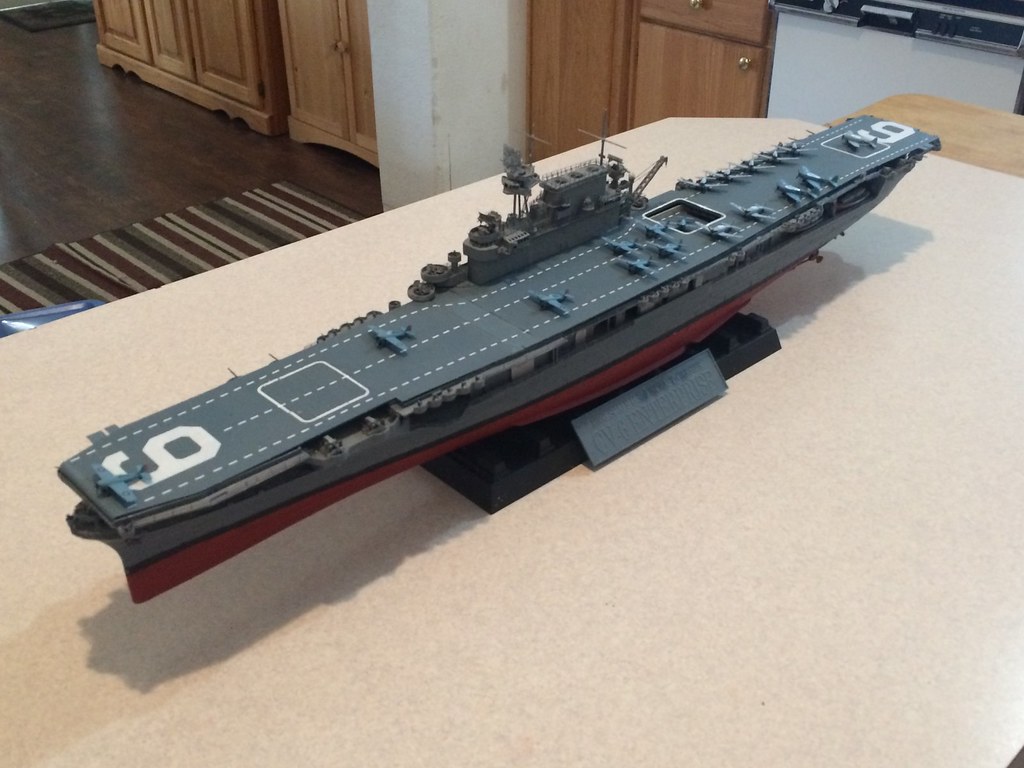
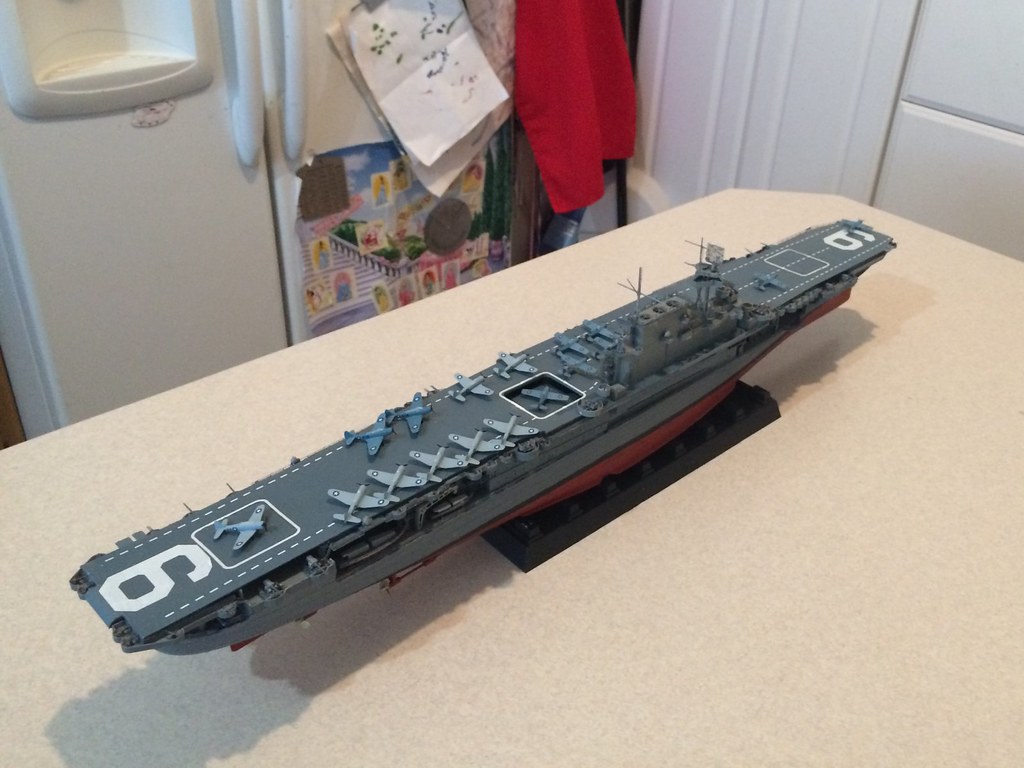
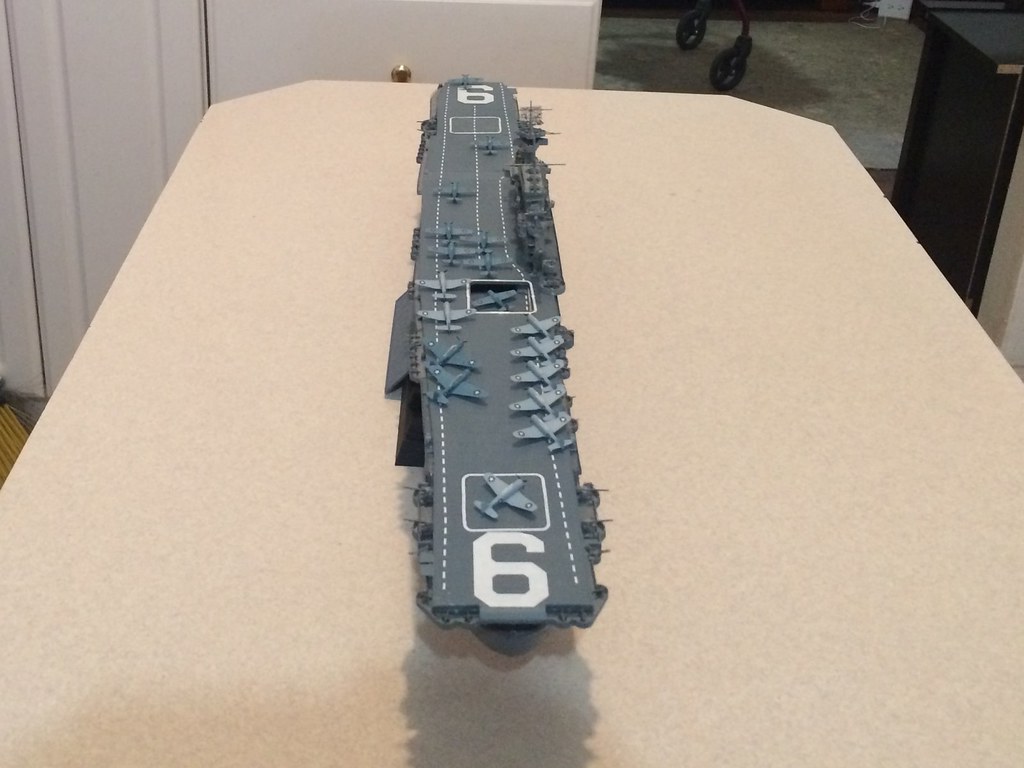

...and then some close ups:
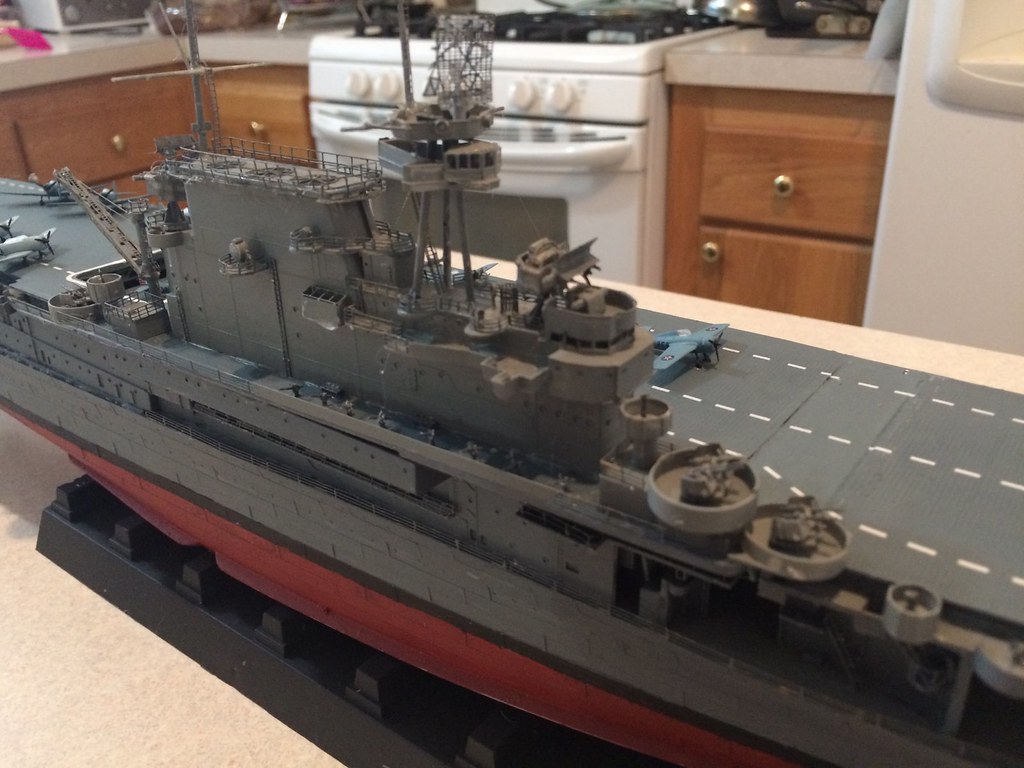
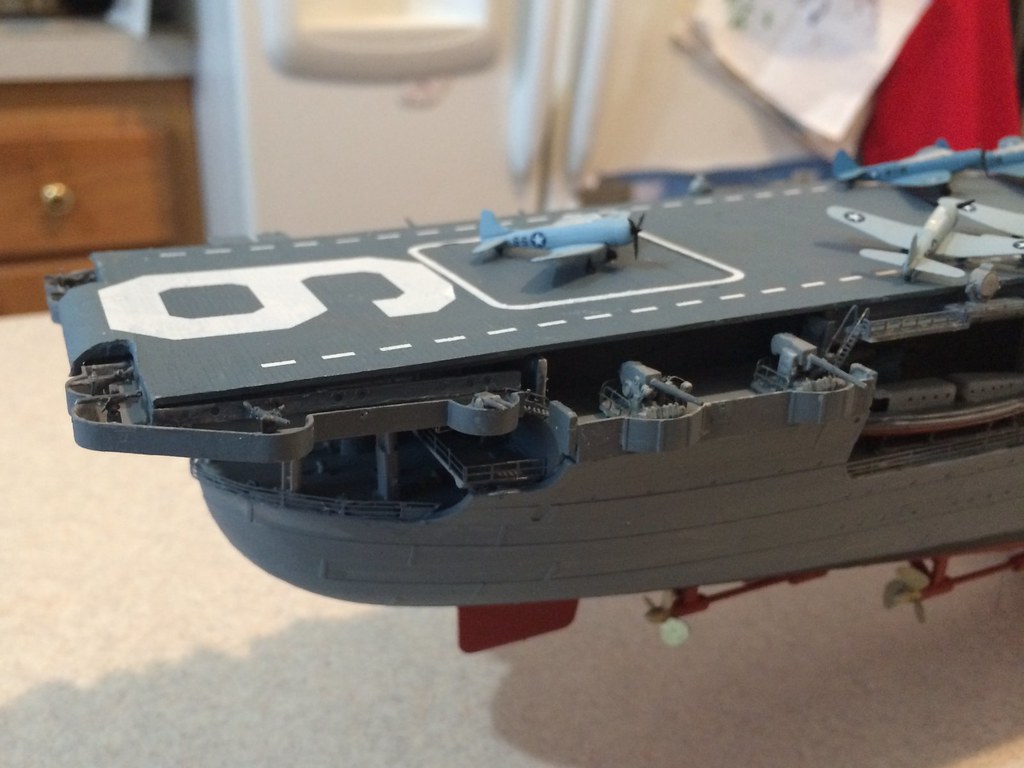
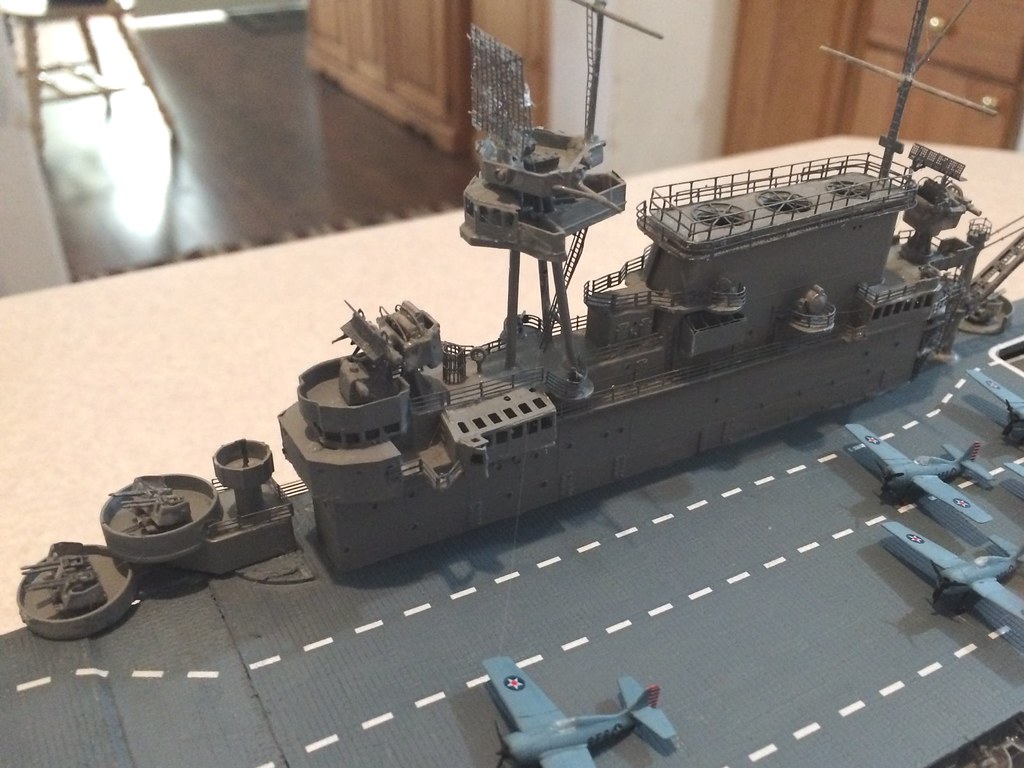
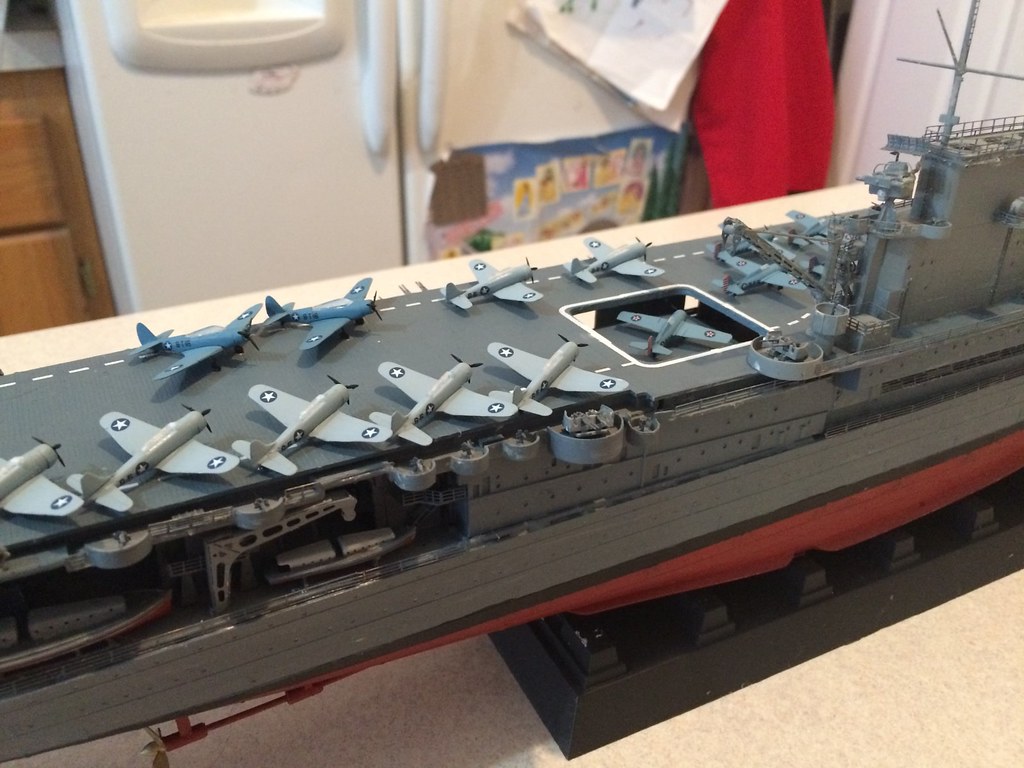
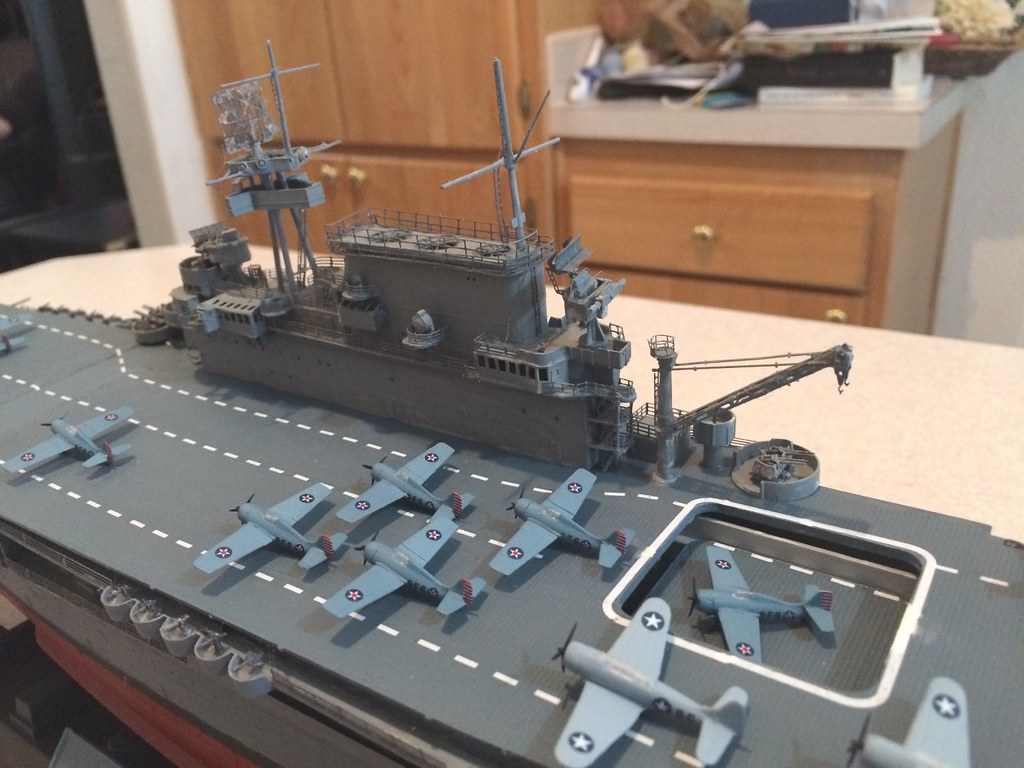
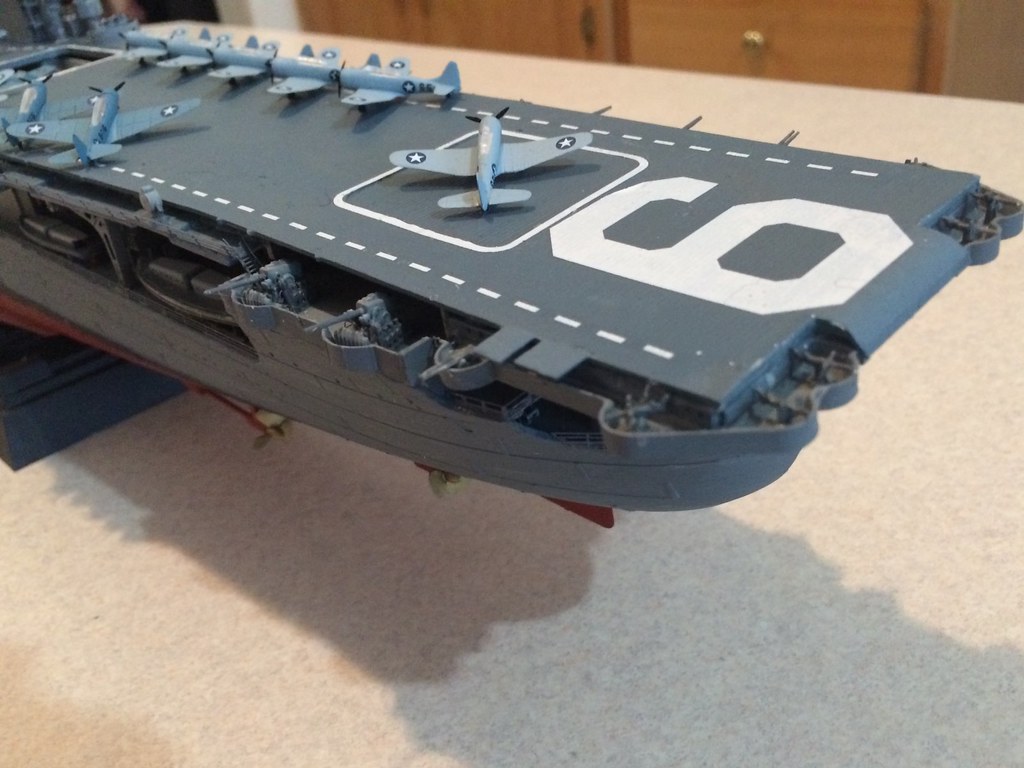
...and some of her hanger:
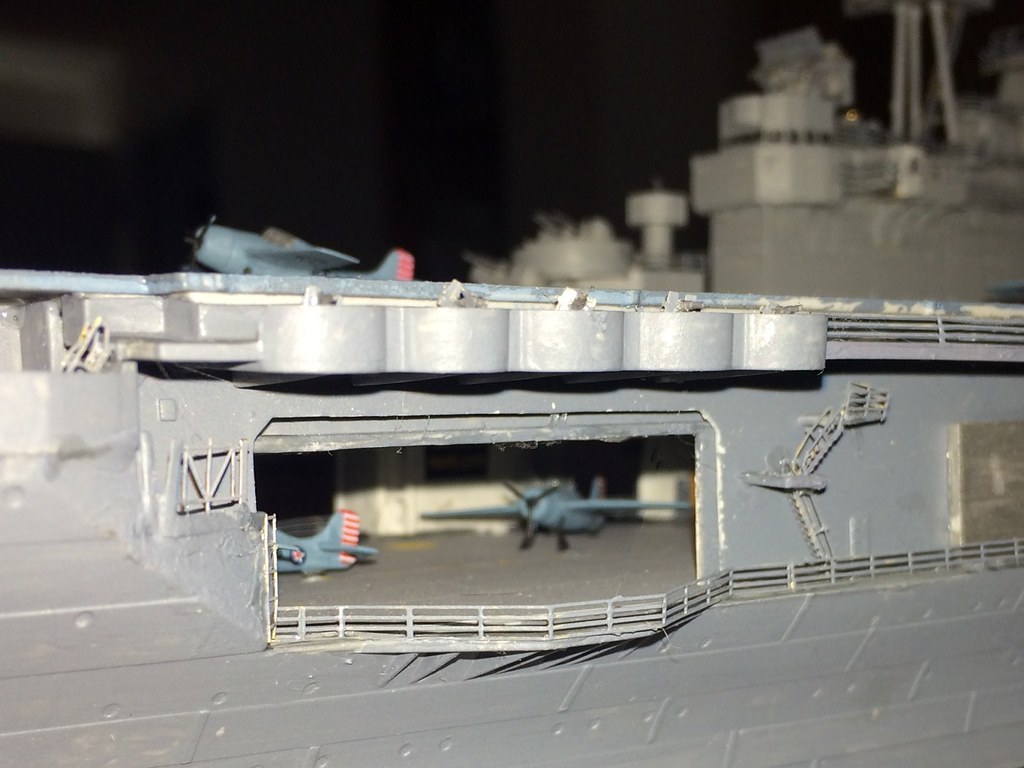
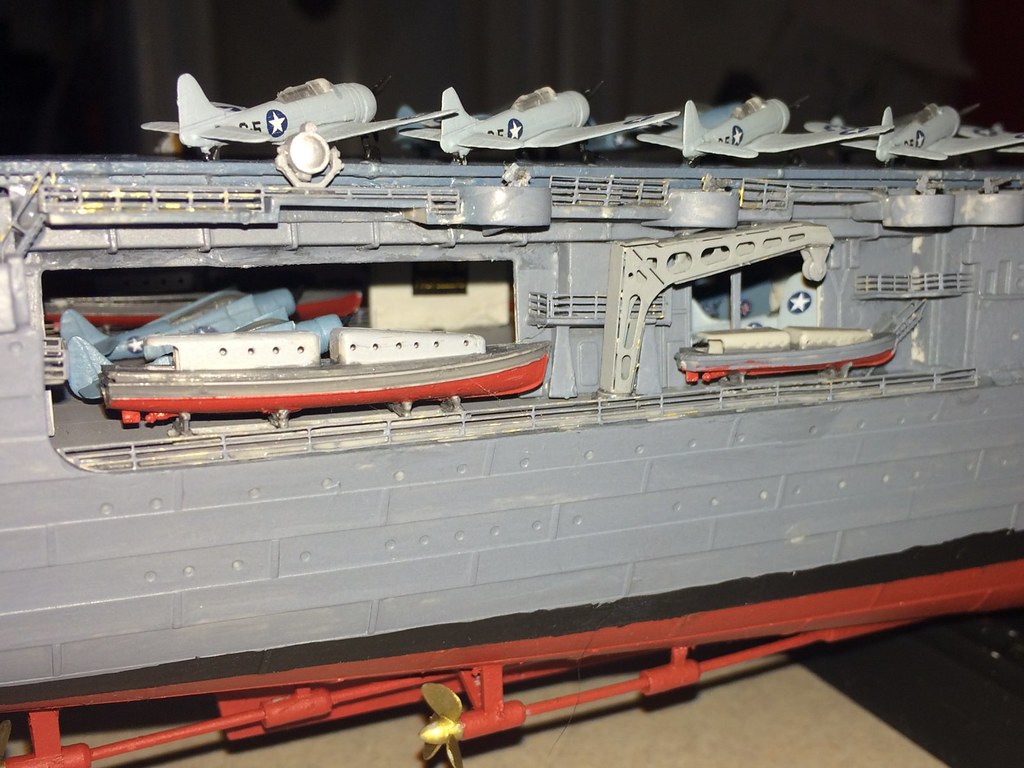
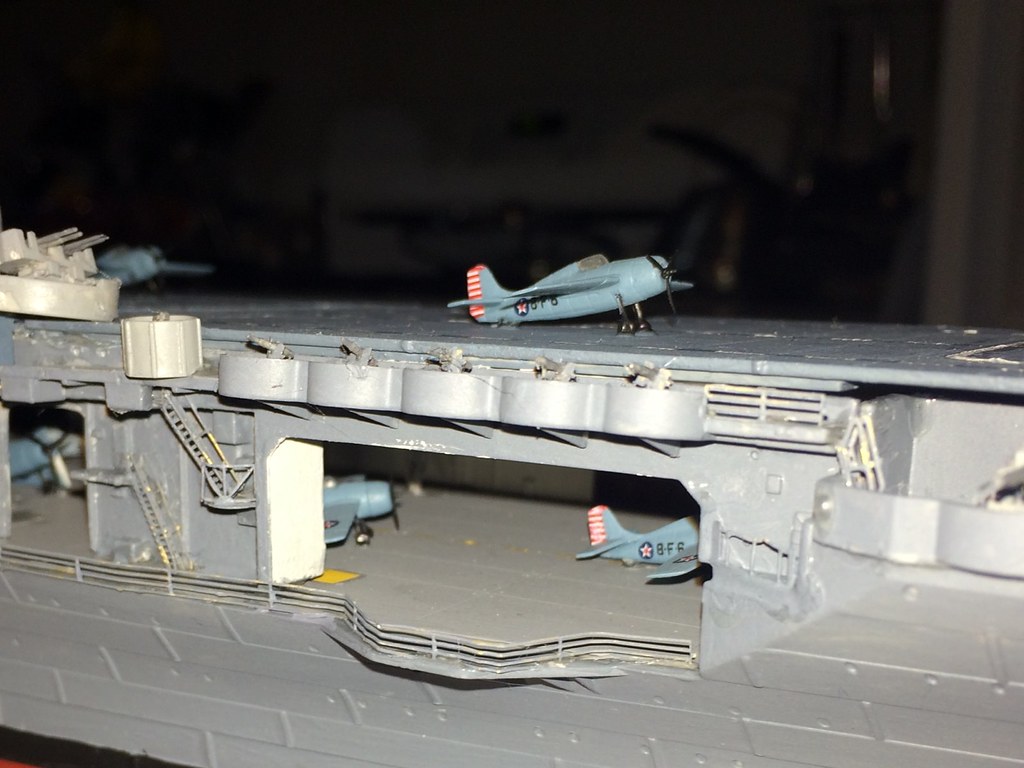
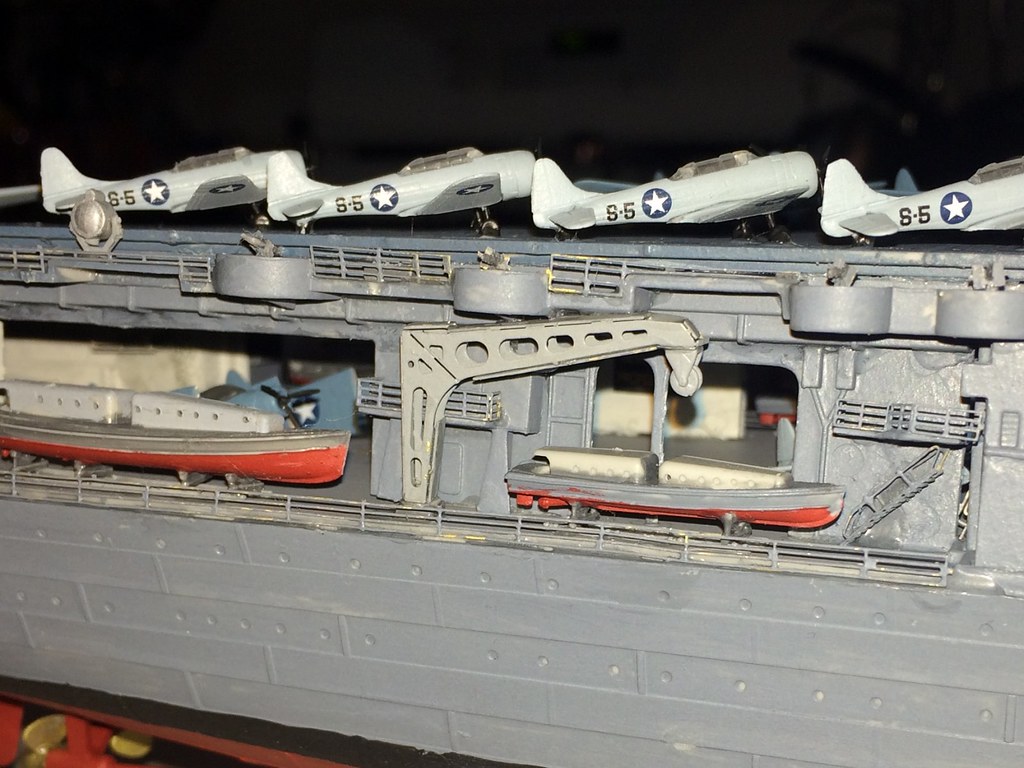
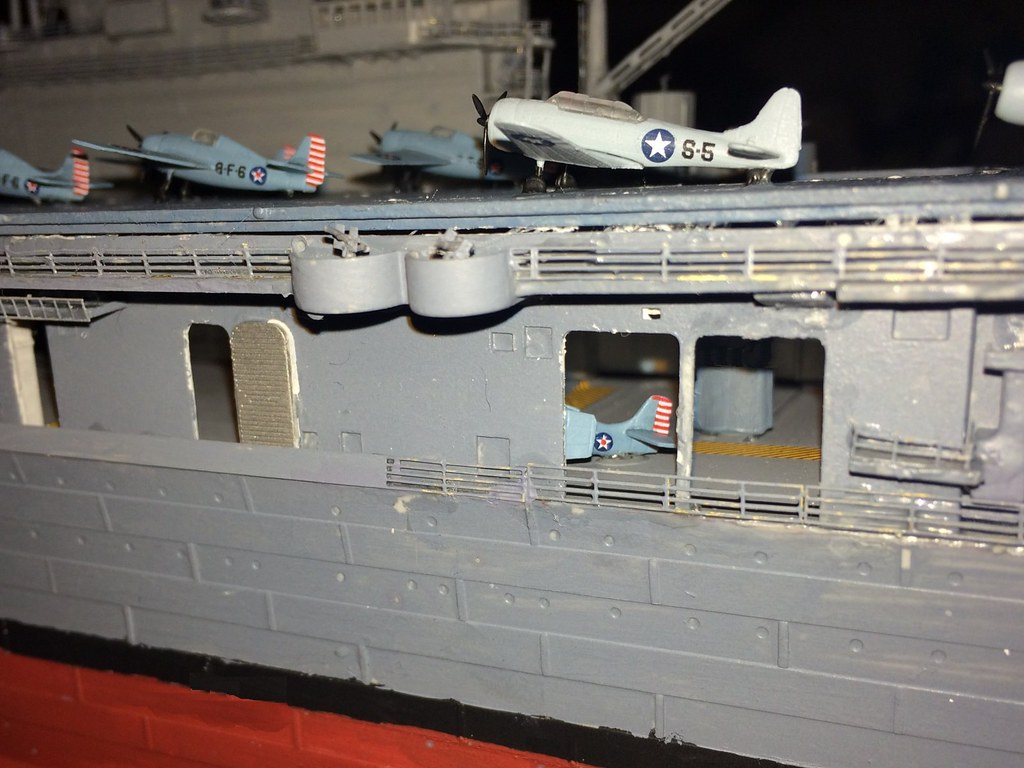
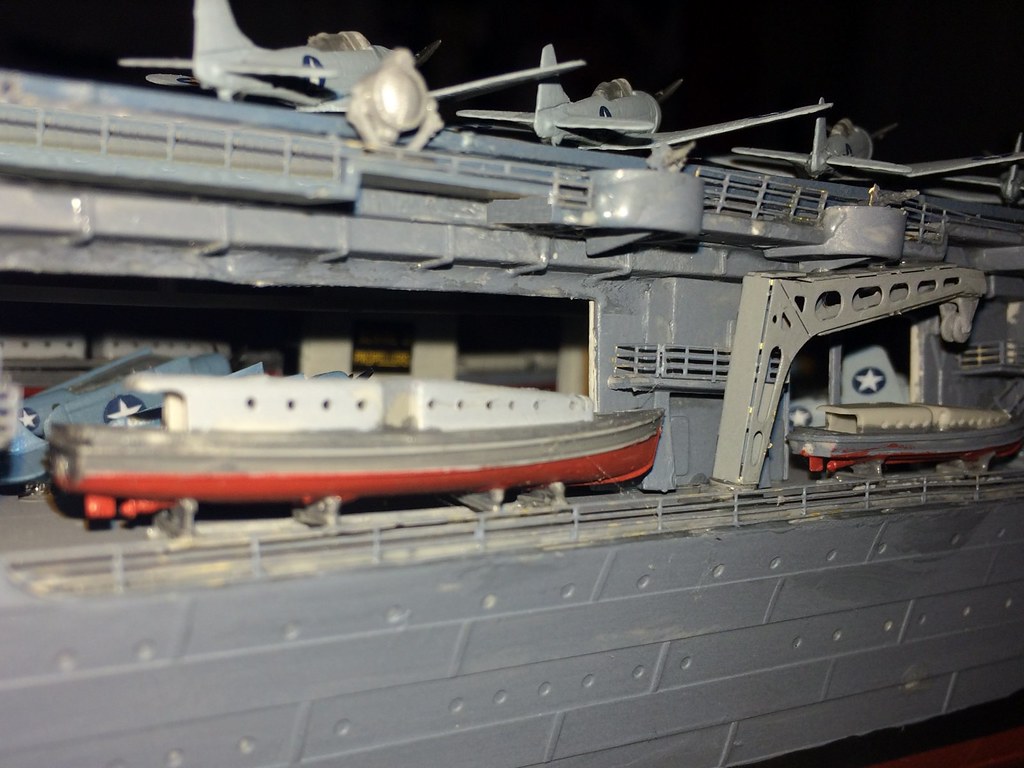
...and finally some pics of the four ship grouping for my Doolittle Raid:
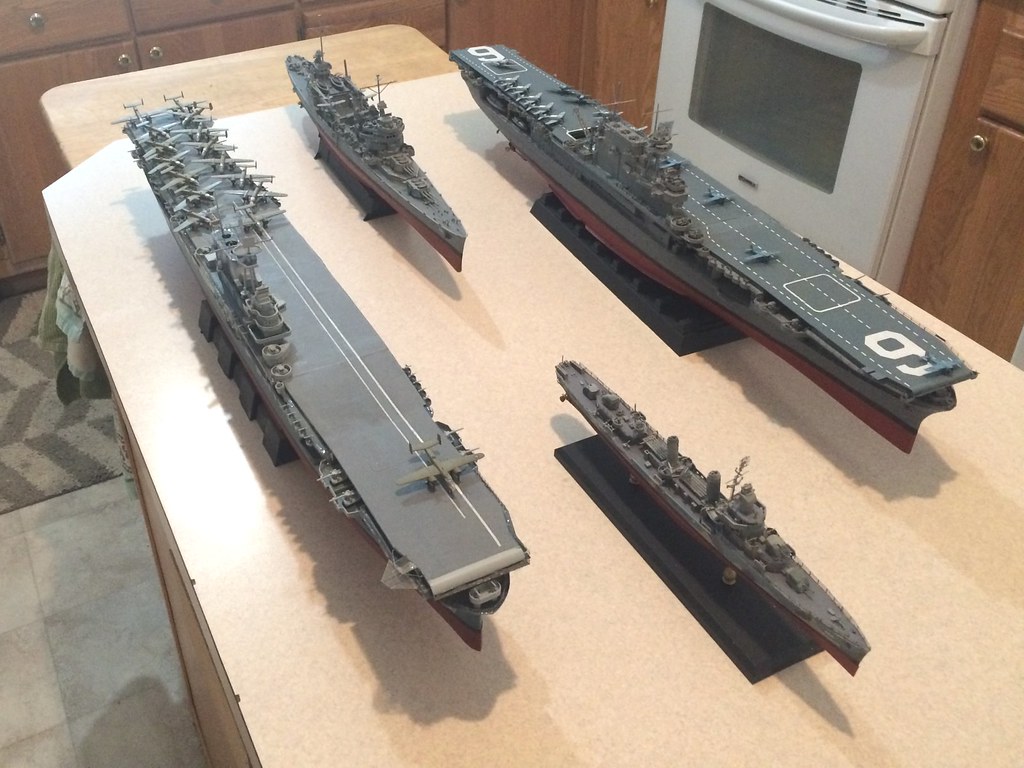
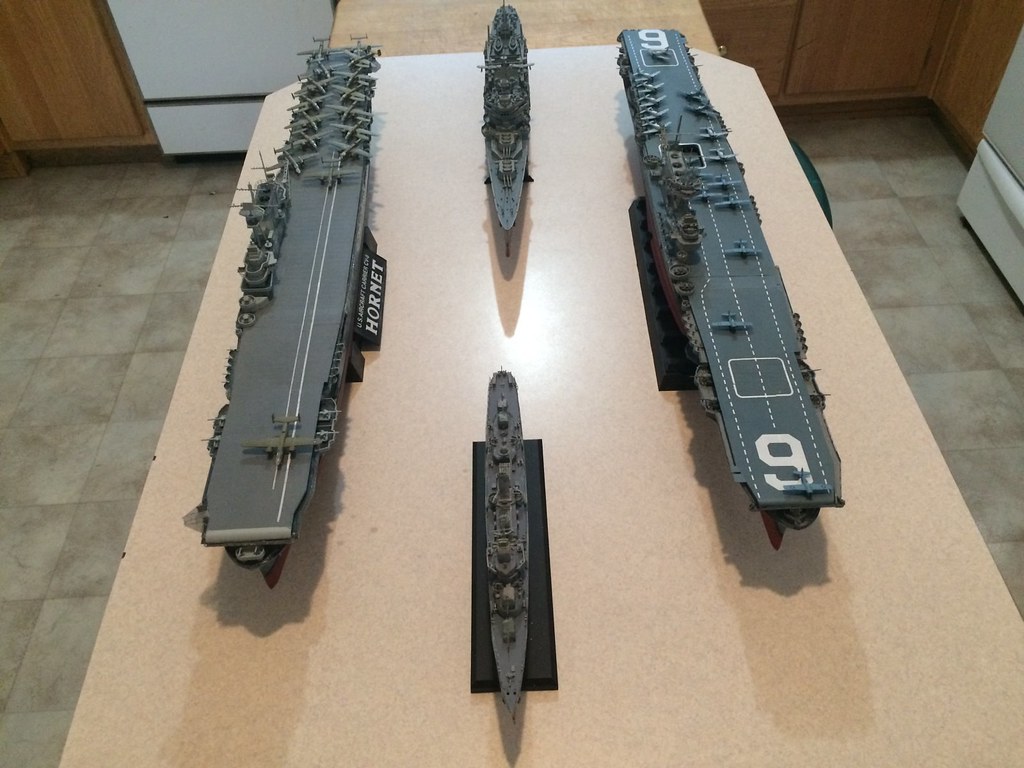
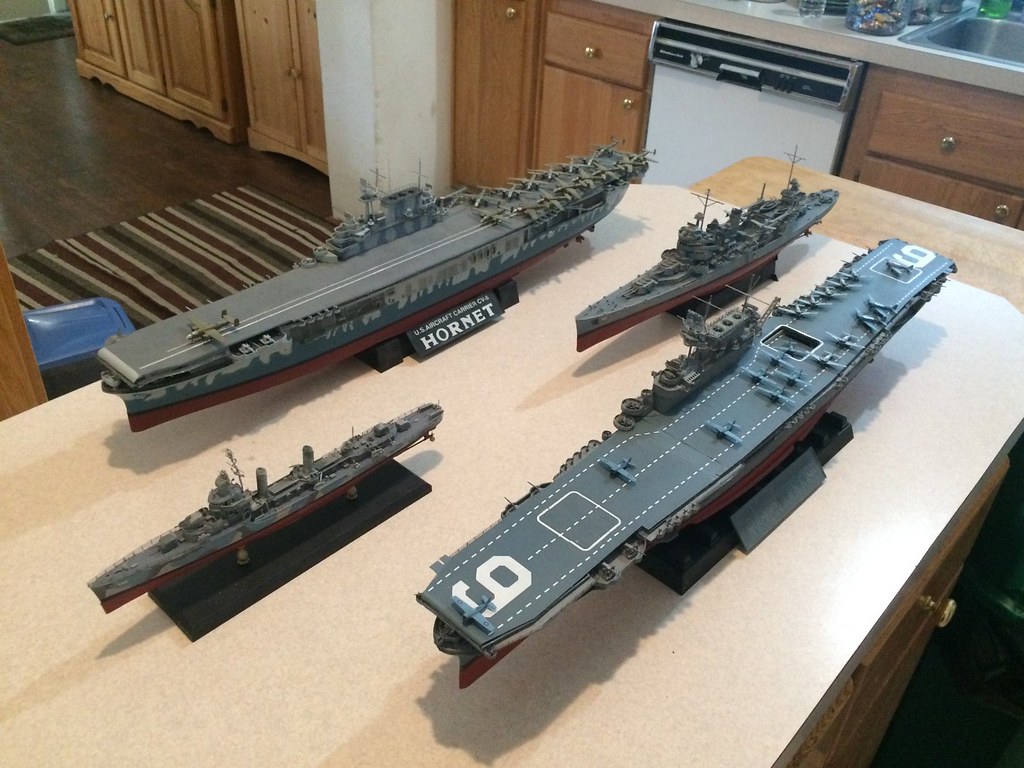
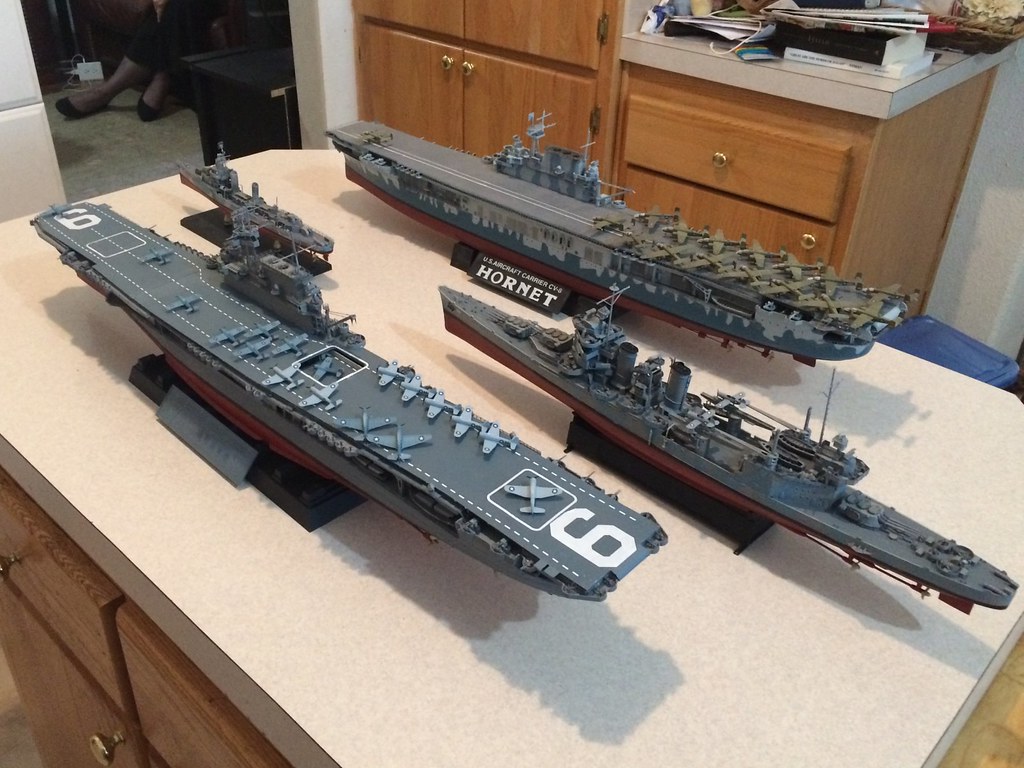
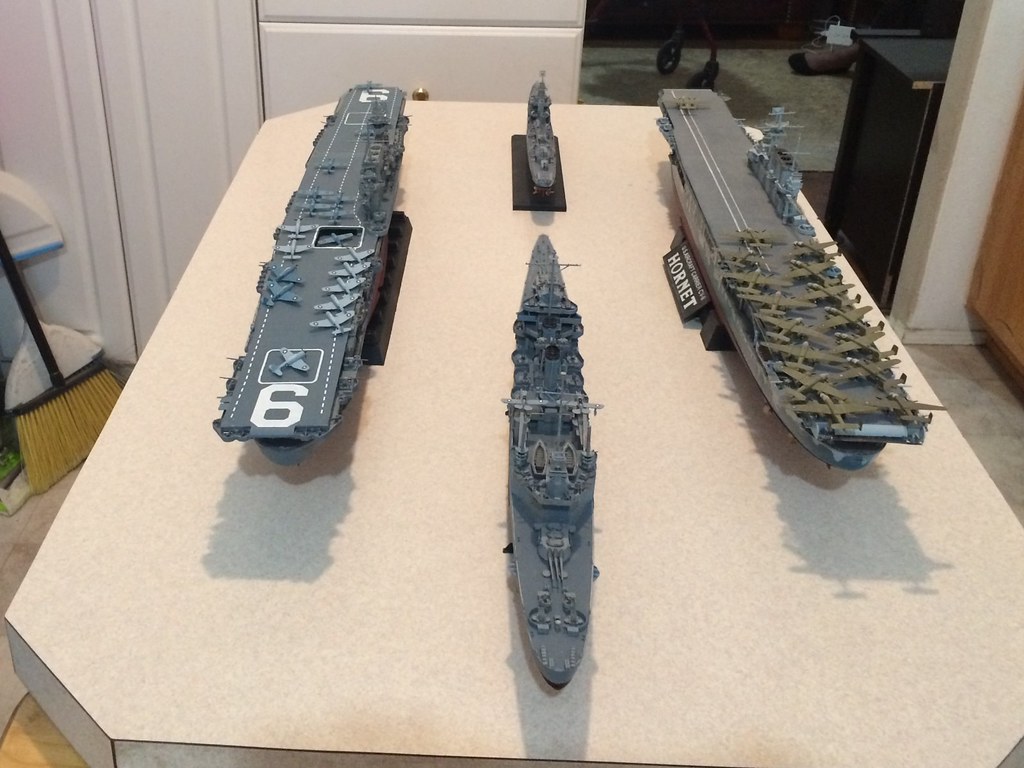
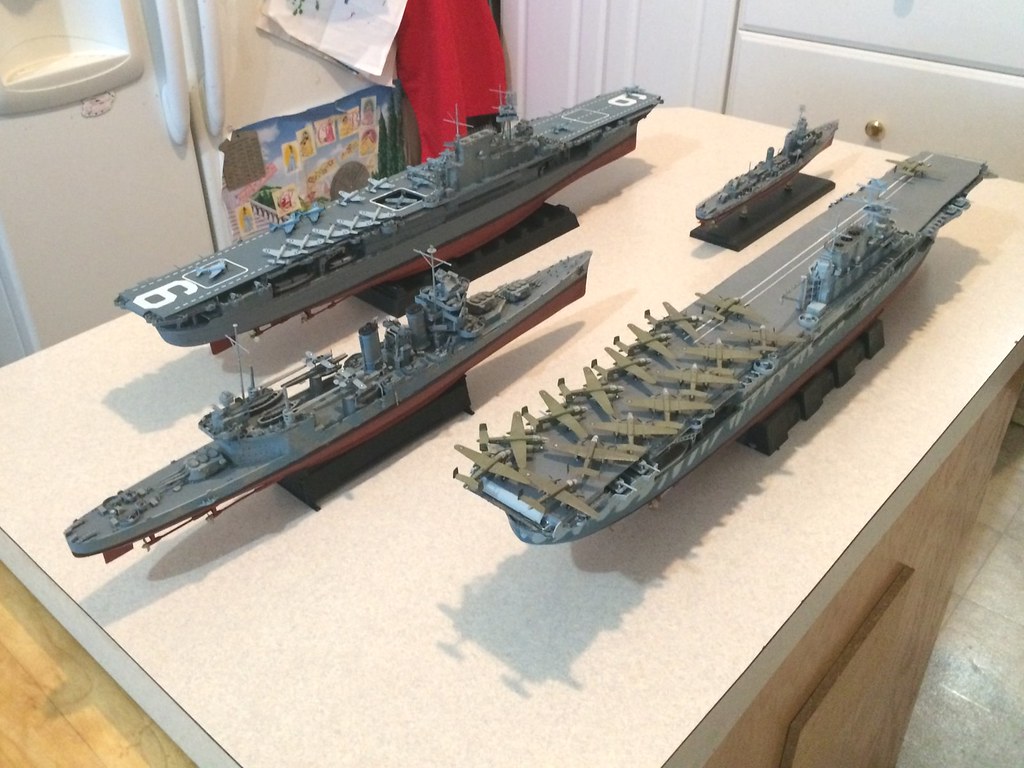
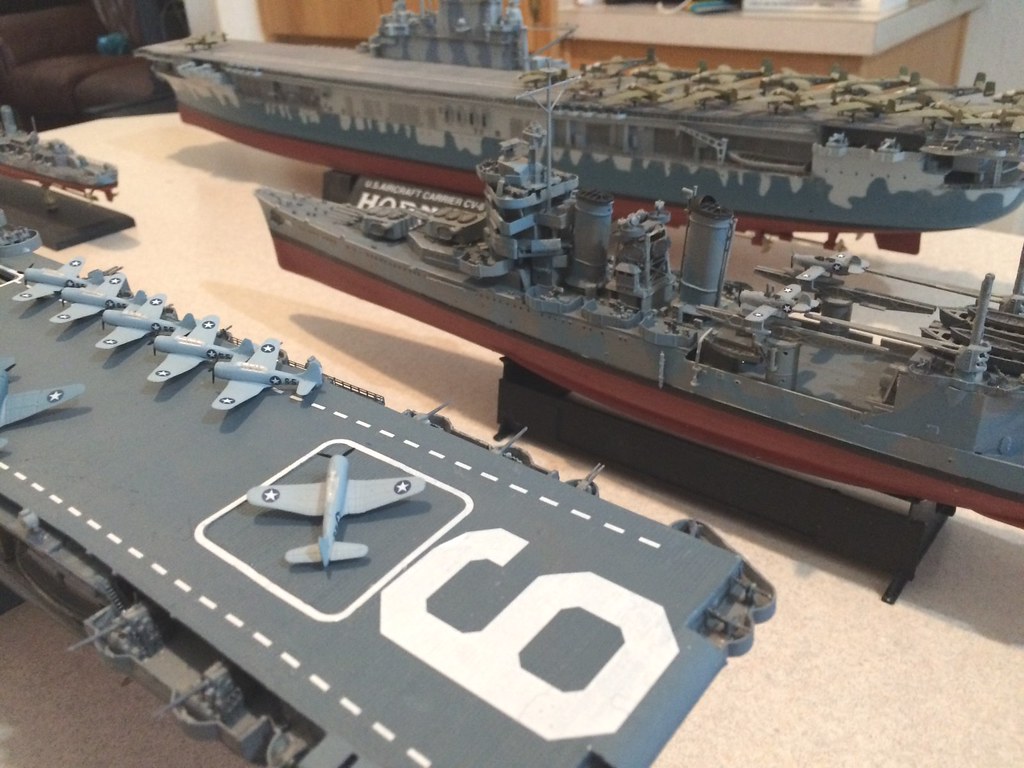
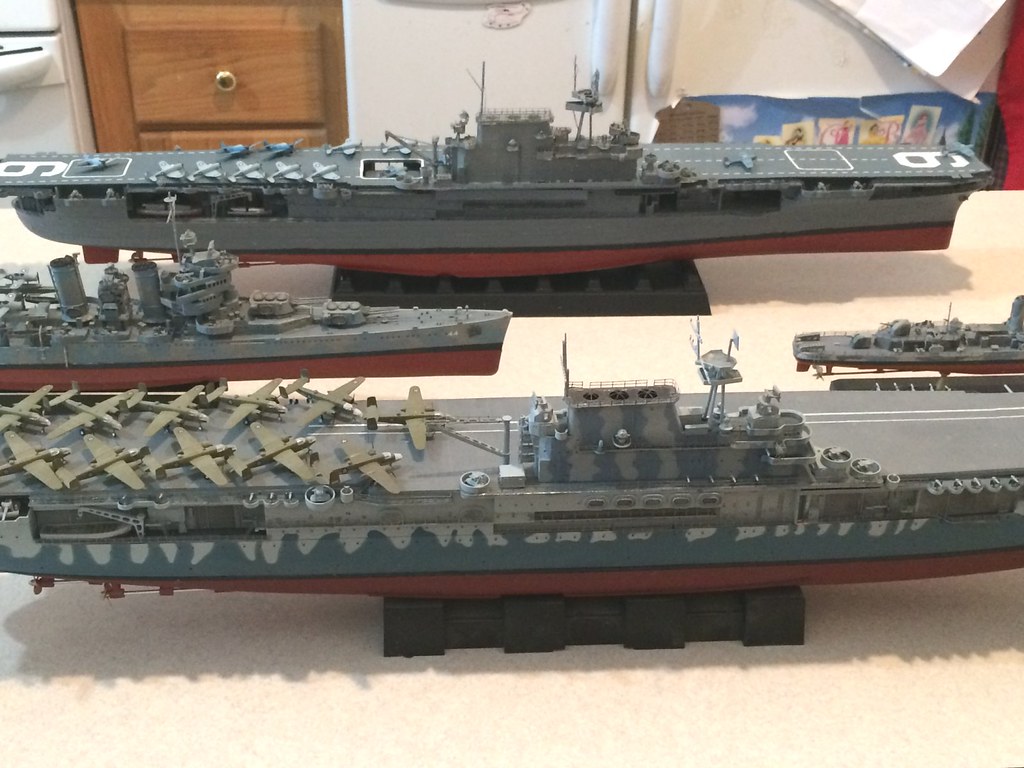
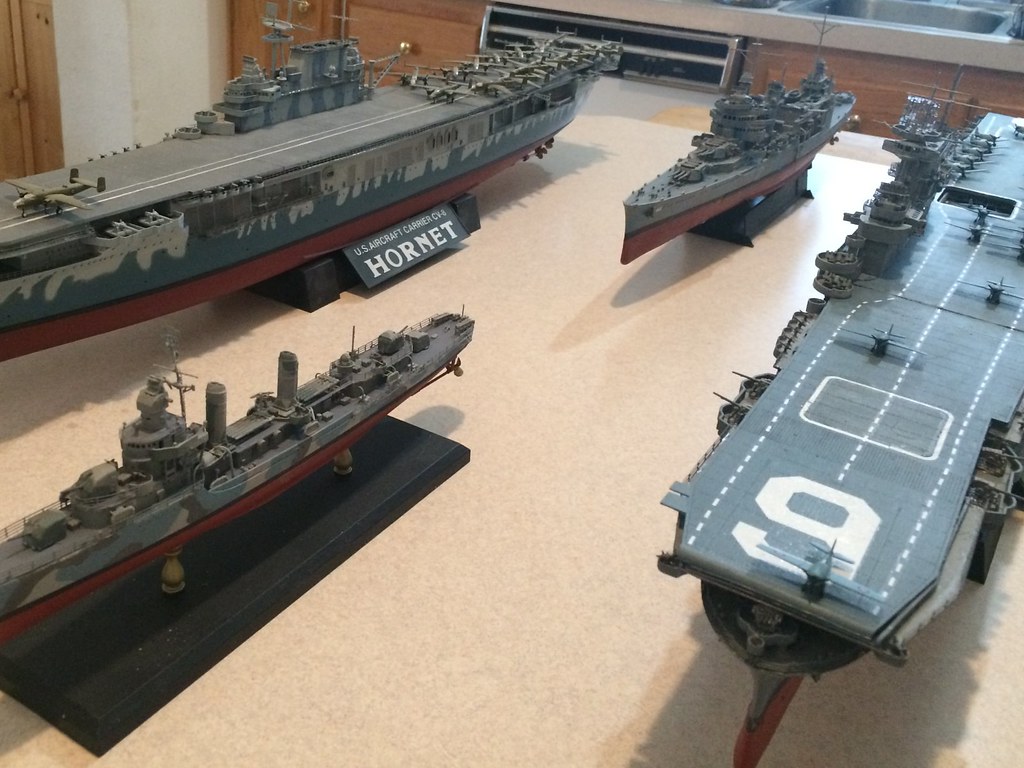
...and there you have it. The USS Enterprise in 1/350 scale.
- By June 1st, 2017 complete the WW II USS Enterprise, CV-6, in 1/350 scale
My Modern aircraft carrier groups:
The completion of the PLAN Carrier group was centered on the already completed Merit's 1/350 scale PLA Navy's Aircraft Carrier CV-16, Liaoning, (in addition to the other escorts already completed) included Mini Hobby's PLAN Guangzhou, DDG-168. I recently pre-ordered a 1/350 scale model of the PLAN Type 071 LPD, Yuzhao Class, announced by Dragon and due out in October, 2013. I will end up adding two of those, probably LPD-998 Yuzhao and LPD-999, Jinggangshan, add the PLAN- DDG-139, Ningbo, and the PLAN DDG-115, Shenyang, along with the PLAN Weifang, FFG-550 and thus build a PLAN ARG.
The completion of the US Carrier Strike group was centered on the completed Tamyia's 1/350 scale USS Enterprise, CVN-65, (in addition to the other escorts already completed) included Dragon's, USS Freedom, LCS-1, Dragon's USS Preble, DDG-88 and Hobby Boss's USS Texas, SSN-775. When a 1/350 scale USS Enterprise, CVN-80 (or any Gerald R. Ford Class) is released from Dragon, Tamiya, Dragon, or whomever else, I will add it to this group along with another AEGIS Cruiser. Whichever Ford Class coms out in 1/350 scale, I will build it as the USS Enterprise, CVN-80.
The US ARG includes Tamiya's 1/350 scale, USS Iowa, BB-62 (which I have already completed), Gallery's 1/350 scale USS Iwo Jima LHD-7, Gallery's 1/350 scale (already completed), USS New York, LPD-21 (Completed), Cyber Hobby's USS Independence, LCS-2 (Completed), Bronco Model's 1/350 scale USS Coronado, LCS-4 (Completed), a Flight IIA US AEGIS class Aircraft Carrier based on Dragon's 1/350 scale USS The Sullivans, DDG-68 (Completed), a Ticonderoga AEGIS cruiser (Completed), and a 1/350 scale Orange Hobbies USS Harper's Ferry, LSD-49...all of these models which I already own.
The completion of the UK Group featured the Airfix 1/350 scale HMS Illustrious, R06 as its center piece until a 1/350 scale Queen Elizabeth carrier is released. When that happens, I will add that carrier to the group as its centerpiece. The Royal Navy CSG will also include two Airfix 1/350 scale Daring Class DDGs (one of which is already completed), two Dragon 1/350 scale Type 23 HMS Duke class Frigates (one of which is already completed), and the Hobby Boss 1/350 scale HMS Astute SSN (which is also already completed) and Airfix 1/350 scale HMS Trafalgar SSN. One day, when a 1/350 scale HMS Ocean LPD comes out, I will use it to start building a Royal Navy ARG.
The French CSG is centered on Heller's 1/400 scale Charles De Gaulle, R91. I have purchased the 1/400 scale Heller French De Grasse, D612 DDG, which is an ASW DDG, the French Duquesne, D603 DDG which is an anti-air multi-purpose DDG, and the French Aconit D612 FFG and Gueprattet F714 FFGs, both of which are Lafayette class frigates. These five vessels round out my French CSG and are all completed. As soon as a French Robin class nuclear sub, like the French Pearle S606 SSN is released in 1/350 or 1/400 scale, I will add that to the group. Also as soon as the Forbin D620, Horizon class anti-air DDG is released in 1/350 or 1/400 scale, I will purchase two of them and replace the De Grasse and Duquesne with them, and then save those two for when a Mistral Class LPD is released in 1/350 or 1/400 scale so I can create a French ARG with those vessels.
The completion of the Japanese JMSDF group was centered on Fujimi's very finely detailed, 1/350 scale Hyuga, DDH-181. It will be escorted by Dragon's 1/350 scale DDG-177, Atago, an AEGIS class DDG and the JMSDF, DDG-174, Kongo class (which I own), Dragon’s 1/350 scale DDG-114 Susunami and DDG-111 (both of which are Takinami Class DDGs which I own), and by the 1/350 scale SS-503 Hakuryu (which I own), one of Japans new, very modern and capable AIP Diesel Electric submarines. It also included a Arts Technic 1/350 scale, DDG-116 Teruzuki (Akizuki class) Aircraft Carrier. Should a 1/350 scale Osumi Class LPD and/or the larger 1/350 Izumo class DDH be released, I will buy those vessels and add them to the group.
Then, finally the Russian CSG (centered on Merit's Kuznetsov which I own) the Russian Kirov Class nuclear battle cruiser (CGN), the Peter the Great, by Merit, the Russian Slava Class cruiser, Varyag by Dragon (which I own), two Dragon 1/350 scale Udaloy DDGs (which I own), Hobby Boss's Akula II class SSN (which I own), and the new Yasen class Russian SSN (which I own), all in 1/350 scale. These are all completed as well. Sometime in the more distant future when a 1/350 scale Russian version of the French Mistral class comes out (which is building in real life right now), I will add two of those and build a Russian ARG.
Recently I purchased Heller's 1/400 scale Foch, the Clemenceau Class carrier that was sold to the Brazilians in 2000 and in 2002 was refitted and became the Brazilian CV, Sao Paulo, using steam catapults. I will build the model as the Sao Paulo and thus start a Brazilian group, though the Type 22 DDGs and the FFGs the Brazilians use are not available at present. I have however purchased a set of 1/400 scale A-4 Skyhawks and S-3 Trackers to build a suitable air wing for the Sao Paulo.
Then, again, once the models are available, I'd like to build an Italian Carrier Strike Group centered on the Cavour and their Horizon DDGs, a Spanish Carrier Strike Group centered on the Juan Carlos and their F-100 AEGIS FFGs, and ultimately an Australian Strike Group centered on the new Canberra Class LPD and the Hobart class AEGIS DDGs. If they ever build the models, an Indian Carrier Strike Group centered on either the Vikramaditya or their new ADS Carrier, the Vikrant, and their Kolkata class DDGs and Shivlak class FFGs would also be nice.
Years more worth of work!
You can see all of these actual carriers, read their histories and specifications at my site:
WORLD-WIDE AIRCRAFT CARRIERS